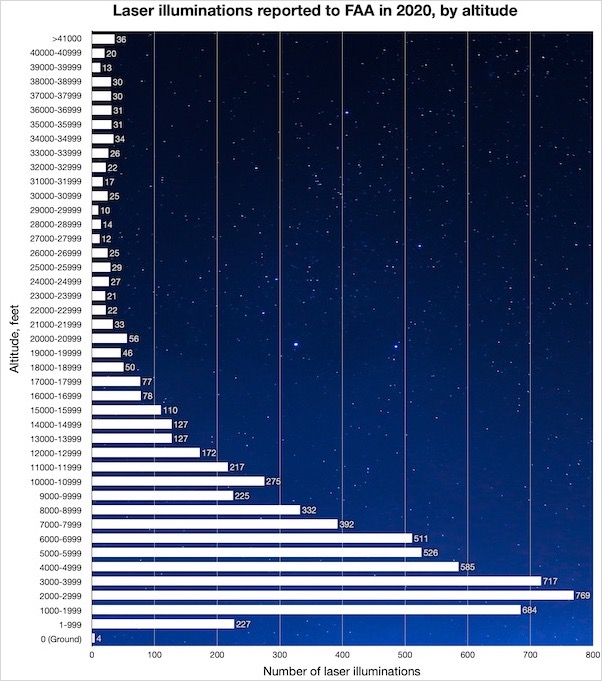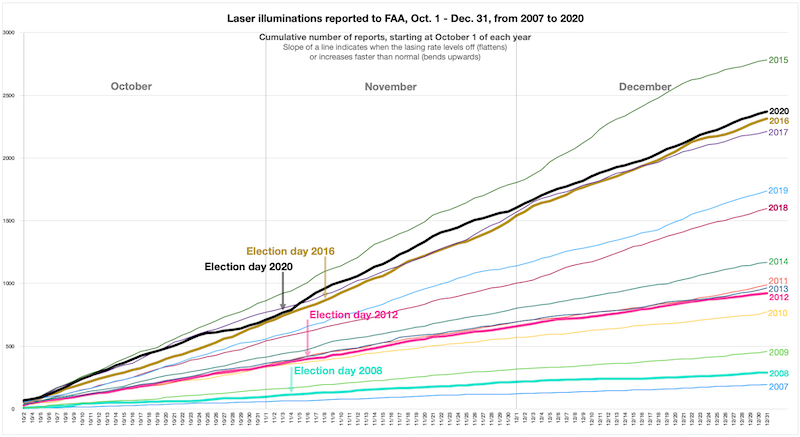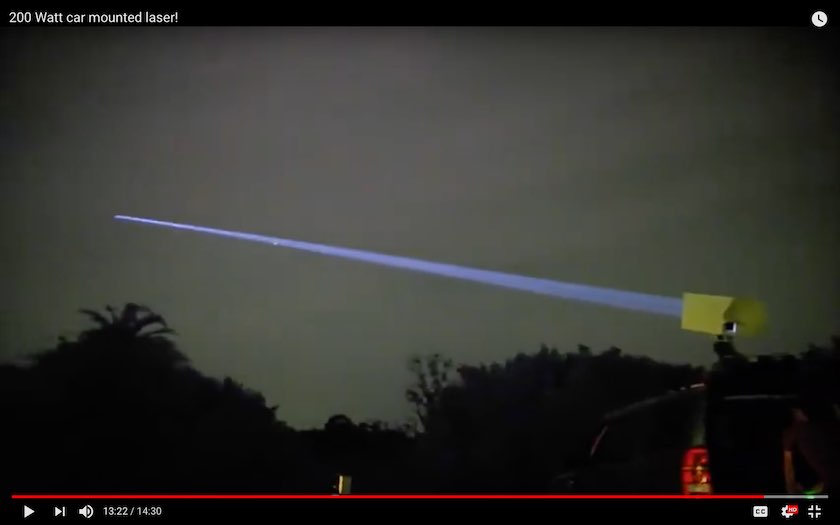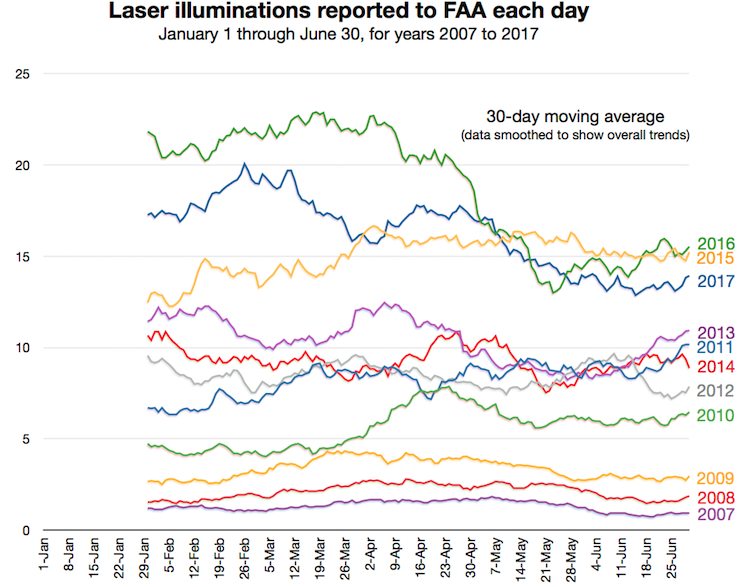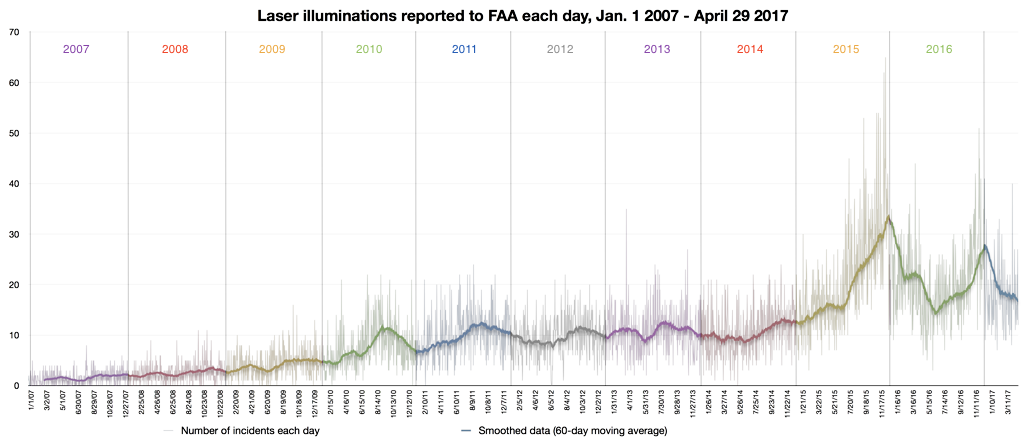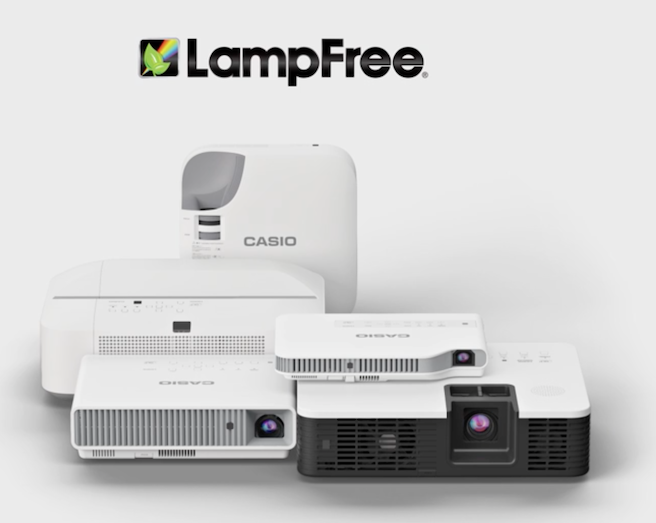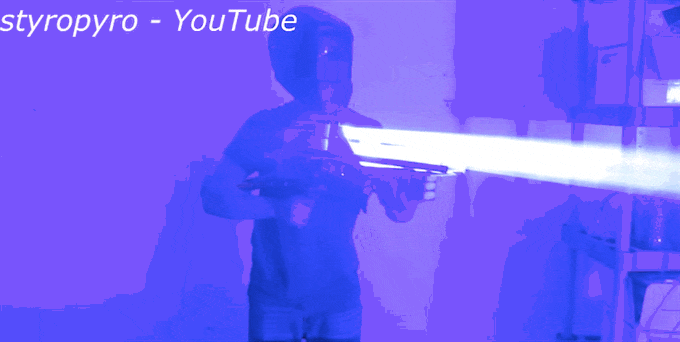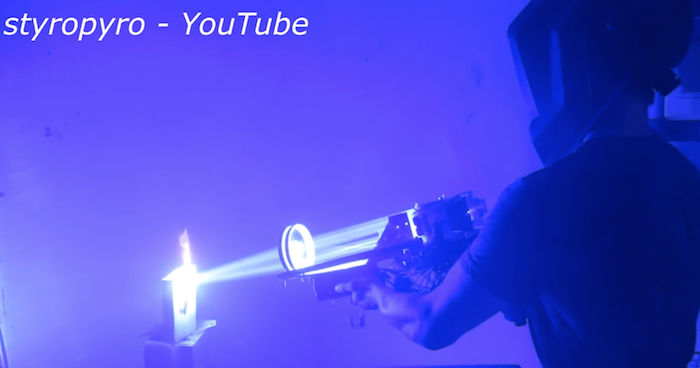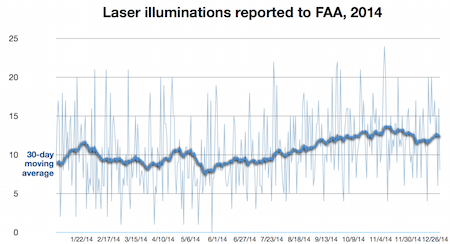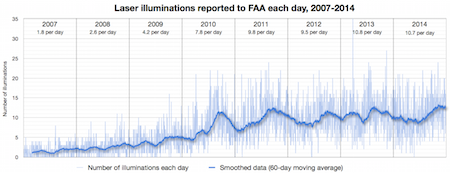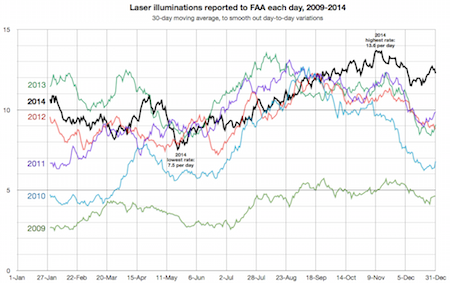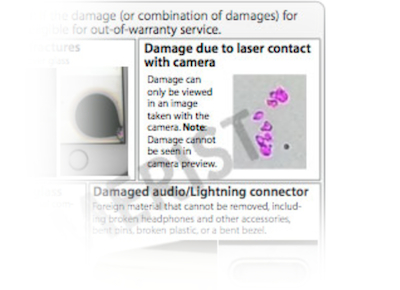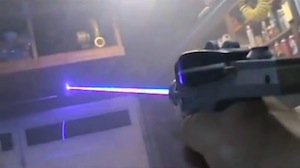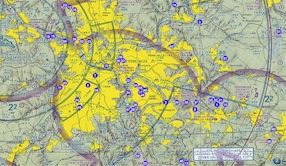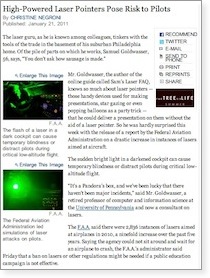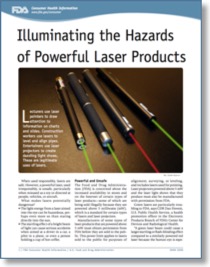Home
A comprehensive resource for safe and responsible laser use
US: 9,723 illuminations reported to FAA during 2021
This means pilots saw lasers on average 26.6 times each day in 2021.
The chart above, and other detailed statistics, are on the Laser/aircraft illuminations statistics page. This includes data such as the following:
- The total number of U.S. laser/aircraft incidents since reporting to the FAA was mandated in 2004, is 71,435 as of Dec. 31, 2021.
- The total number of worldwide laser/aircraft incidents reported to authorities since 2004 is 102,104. Only eight countries are included in this cumulative total, and many of these do not have data for some years in the 2004-2021 time period, so the actual number of incidents is higher.
- Green laser light remains the most-reported. In 2021, 86.1% of incidents involved green light; blue was second with 8.8%. The number of blue lasers reported has, in general, increased over the past few years. For example, in 2016 only 2.9% of incidents involved blue laser light.
- In 2021, 0.5% of FAA-reported laser/aircraft incidents indicated that crew members suffered eye effects or temporary injuries. This rate has decreased since 2011, when 1.4% of incidents incurred eye effects or temporary injuries. The most-reported effects were flashblindness and/or afterimage; pain, burning or irritation; blurriness; and unspecified eye injuries.
US: FAA details fines since 2016 for laser strikes
Dickson noted that "if a person shines a laser at a plane, it can mean a fine of up to $11,000 for a single incident and up to $30,800 for multiple incidents."
He added, "Like many crimes, there is a need for education, outreach, and the cooperation from the public to address this safety risk. We encourage the public to report laser strikes to the FAA via our website or to your local law enforcement agency."
From the FAA video on YouTube
US: New Missouri law makes it illegal to aim a laser pointer at a uniformed officer
A "laser pointer" is defined as a device that emits a visible light amplified by the stimulated emission of radiation.
The offense is a Class A misdemeanor.
From the "Revisor of Missouri" website page describing the new law
US: FAA webpage analyzes laser strike statistics
It includes graphs of yearly, monthly and daily laser event numbers, data on events by month and by day of the week, states ranked by raw numbers and on a per capita basis, injuries, and altitudes at which lasers were seen. By clicking on data points or sections of a chart, a box pops up with more precise information.
Here is the top part of the webpage as it appeared in September 2021:
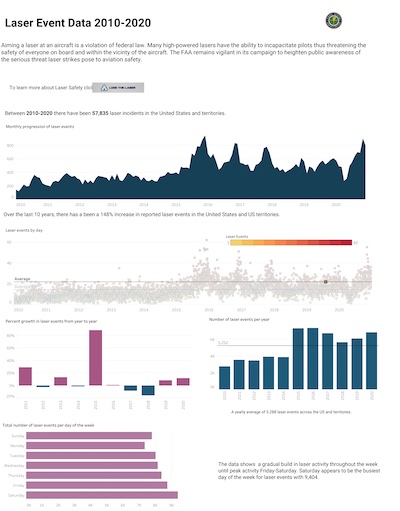
From FAA's data visualization webpage. If this link does not work, the data might also be accessed from FAA's main laser safety webpage. T
COMMENTARY FROM LASERPOINTERSAFETY.COM
Many of the FAA charts on the webpage are very interesting, such as the number of laser events per capita for each state. For example, Hawaii leads the country in laser illuminations per capita, in 2020.
However, some charts are near useless such as the "injuries" chart. This is organized by state, not by type of injury. Worse, there is no information provided about what counts as an injury, or the severity and outcome of the reported injury. (We have our own injury analysis chart on this page which is much more detailed.)
Another near-useless FAA chart is one that shows aircraft altitude during the incident. The chart shows data points with the number of flights at a given altitude. But there is no attempt to group altitude ranges together, for example, to find out how many laser incidents happened between 0-1000 ft, between 1000-2000 ft, etc. 
In contrast, this chart (done by LaserPointerSafety.com) has the same data formatted in a more understandable way:
US: 30 eye injuries May-July 2020 caused by police (not a laser)
The report focuses on kinetic impact projectiles (KIPs) such as so-called rubber bullets, baton bean-bag rounds, and tear gas canisters fired directly at protesters, journalists and bystanders. It specifically excludes chemical injuries such as from tear gas.
The effect of KIPs on the eye, according to the group, "nearly always causes total blindness in that eye, due to rupture of the globe (eyeball) as well as trauma to nearby structures."
The report notes that:
PHR’s database contains only incidents documented in traditional and social media. The tally depends on individuals to self-report their experiences, on journalists to identify and document injuries, or on the legal system to present these instances in the course of litigation. For these reasons, this count of injuries is believed to be only a fraction of the total number of people shot in the head and neck by U.S. law enforcement during the protests since May 2020….
In addition to the May 26 - July 27 2020 reports, the group also cited a "systematic review … of medical literature on kinetic impact projectiles over the past 25 years." This review found 1,925 injured people, 53 of whom died and 294 people with permanent disabilities. Further, "Permanent vision loss was the most common permanent disability."
The PHR report was cited in a May 20 2021 Narratively story (also published September 2 2021 at The Guardian) by photojournalist Wil Sands, whose right eye was blinded by a tear gas canister outside the White House on May 30 2020. Sands contacted others whose eyes were damaged by police using "less lethal weapons", told their stories, and has created an internet group for persons blinded by law enforcement.
Note: This story is part of our occasional coverage of eye injuries at protests which were not caused by a laser. This is because the number of actual or claimed laser eye injuries at protests (generally inflicted on police or security forces) is vastly outnumbered by actual or claimed eye injuries to protesters, journalists and bystanders (generally caused by police or security forces). In our view, no one should aim a laser or projectile at anyone's eye or head during protests, demonstrations and civil unrest.
US: Charges dropped against protester accused of laser pointer assault
Yusuf Labib had been arrested in March 2021 at a memorial for Breonna Taylor on a charge with "assault with force likely to cause great bodily injury."
At a court hearing, the prosecutor said "in this instance the People do not believe the evidence shows beyond a reasonable doubt that Mr. Labib specifically intended to cause fear of bodily harm.”
She continued, “The police officer in this case personally knew colleagues who have suffered permanent eye damage from lasers being shined in their eyes, so they take this conduct very seriously…. The People request Mr. Labib recognize that these potential risks exist before choosing to use a laser pointer in the future.”
Labib told the judge that he heard the prosecutor's comments.
From the Davis Vanguard
US: Air Force develops laser glare protection glasses for pilots
Washington State Patrol pilots successfully test special laser eye protection developed at Wright-Patterson Lab
Story by Mary Pacinda, Air Force Research Laboratory
Aiming a laser at an aircraft is a federal crime that can net offenders up to five years in jail or cost them a $250,000 fine. Even with this heavy potential penalty, laser strikes have become increasingly more common. According to the FAA, 6,852 such incidents were reported in 2020, compared with 385 in 2006, and so far this year, incidents of “joy lasing” are up 20 percent over last year. Cheap and easily obtained, hand-held lasers used as pointers and cat toys are certainly harmless when used as intended. But when they are aimed at the cockpit of an aircraft, they can temporarily blind the pilot — with possibly deadly consequences.
Laser strikes are almost always made at low altitudes when an aircraft is taking off or preparing to land — the two parts of flying that require the most attention from a pilot. Even if the beam of light does not hit the pilot’s eyes directly, it can cause a distraction or even raise an alarm that the plane may have become a target. In addition to the possible adverse effects of these human reactions, slight imperfections in the plane’s windscreen can cause the laser light to spread out, creating a glare that can temporarily obscure all vision inside the cockpit.
Of course, passing a law against any behavior — including pointing a laser at an airplane — seldom puts an end to the behavior. Thus, the best way to avoid disaster from laser strikes is to provide some sort of protection for the pilot. As a result, in recent years several manufacturers have developed laser eye protection (LEP) to meet a growing demand for help from military and law enforcement pilots. But this solution is not without problems of its own.
Most laser eye protection works by filtering out green or red light, the colors most commonly used in handheld lasers. Unfortunately, according to FAA studies and years of pilot experience, this can change the pilot’s ability to accurately read the instrument control panel. A 2019 FAA report suggested that this problem might be fixed by changing the type of lighting in the control panel.
Researchers at the Air Force Research Laboratory recently came up with a better solution, one that was successfully tested on the job by Washington State Patrol pilots.
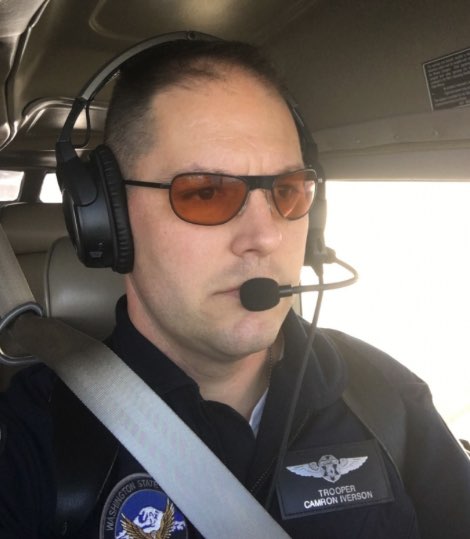
Flight Officer Camron Iverson of the Washington State Patrol tested laser protection lenses formulated at AFRL’s Materials and Manufacturing Directorate. (Photo by Mary Pacinda)
The Personnel Protection Team in AFRL’s Materials and Manufacturing Directorate, headed by Dr. Matthew Lange, used the cockpit compatibility design software developed for Department of Defense LEP and modified it for commercial use. The commercial version, called CALI (Commercial Aviation Low Intensity) filters out the laser light, but not the light coming from the pilot’s instrument panel. “Simply put,” said Lange, “the lenses maximize protection while minimizing the impact to the cockpit.”
US: Missouri bill proposes 1-year sentence for pointing laser at police
A number of persons representing doctors and police officers supported the bill. Even the lone person in opposition to the bill supported the general idea but thought that the penalty was too harsh.
On March 2 2021, the Standing Committee on Public Safety in executive session voted 10 to 0 in favor of the bill. It was referred to the Rules - Legislative Oversight committee for further action.
Bill text at the Missouri House of Representatives 101st General Assembly HB 31 webpage. Story from the News & Record, though it is difficult to tell whether the bill described in the story is this one or is HB280 which does not appear to include laser misuse in its text.
US: Arizona law proposes stronger penalty for laser misuse during disorderly protests
Currently, this offense is a Class 1 misdemeanor. House Bill 2309, if passed, would make this a Class 6 felony if the "offense occurs in the course of committing violent or disorderly assembly."
A Class 6 felony is considered aggravated assault, with a mandatory minimum six month jail term.
"Violent or disorderly assembly" is a new term created in the bill, defined as follows: "A person commits violent or disorderly assembly if, with seven or more other persons acting together, the person, with the intent to engage in conduct constituting a riot or an unlawful assembly, causes damage to property or injury to another person."
As of February 24 2021, the bill was reported out of committee to the House.
From the Martinsville Bulletin
US: Why did lasers aimed at aircraft increase after the 2020 election?
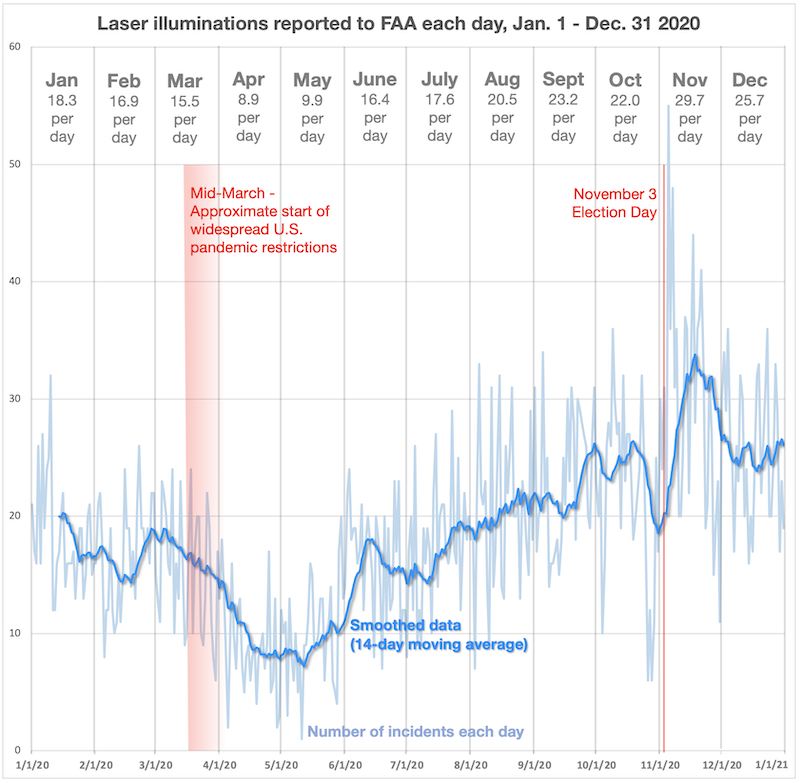
In fact, of the 10 highest days (most incidents) in 2020, all but one occurred in the Nov. 5-21 period. There were 55 incidents on Nov. 5, 48 on Nov. 6, 44 on Nov. 17, and 41 on Nov. 21. These occurred more than twice as often, compared with the 2020 average of 18.7 incidents per day.
Is this a statistical anomaly or did the disputed election results somehow lead to an increase in laser incidents?
COMMENTARY AND ANALYSIS BY LASERPOINTERSAFETY.COM
The chart below indicates that the three previous U.S. presidential elections did not have an effect on lasing incident rates.
It shows that in 2008, 2012, and 2016 the number of laser incidents each day between October 1 and Dec. 31 rose smoothly and steadily. In contrast, the lasing rate in 2020 (black line) slowed substantially around October 26, and rose significantly just after Election Day on November 3.
However, these two effects appear to counter each other. It may be that some other factor, such as how FAA records or processes laser incident reports, slowed in late October and sped back up in November.
In summary, while it is tempting to say that agitation over the 2020 election results led to an increase in persons aiming lasers at aircraft, this was not seen in previous election years and may be a statistical anomaly.
US: 6,852 laser illuminations reported to FAA in 2020
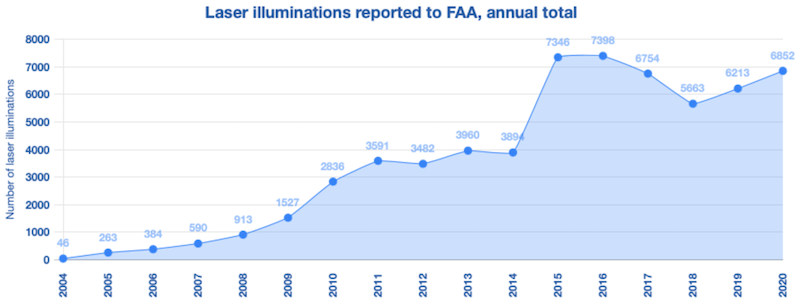
This means pilots saw lasers on average 18.7 times each day in 2020. However, the lasing rate was not evenly distributed. It reached a monthly low of about 9 illuminations per day in April 2020 — just as nationwide pandemic restrictions started. The highest rate was in November 2020, with almost 30 illuminations per day.

The peak number of illuminations, 55 on Nov. 5, occurred two days after the contentious 2020 election, when a presidential winner had not yet been declared. Of the 10 highest days (most incidents) in 2020, all but one occurred in the Nov. 5-21 period. A separate story at LaserPointerSafety.com discusses whether this is a coincidence or if there is some correlation with the election.
The charts above, and other detailed statistics, are on the Laser/aircraft illuminations statistics page. This includes data such as the following:
- The total number of U.S. laser/aircraft incidents since reporting to the FAA was mandated in 2004, is 61,712 as of Dec. 31, 2020.
- The total number of worldwide laser/aircraft incidents since 2004 is over 90,000. Only eight countries are included in this cumulative total, and many of these do not have data for some years in the 2004-2020 time period.
- Green laser light remains the most-reported. In 2020, 85.4% of incidents involved green light; blue was second with 9.2%. The number of blue lasers reported has steadily increased over the past few years. For example, in 2016 only 2.9% of incidents involved blue laser light.
- In 2020, only 0.3% of FAA-reported laser/aircraft incidents indicated that crew members suffered eye effects or temporary injuries. This rate has decreased since 2011, when 1.4% of incidents incurred eye effects or temporary injuries. The most-reported effects were flashblindness and/or afterimage; pain, burning or irritation; and blurriness.
US: New federal law makes aiming laser at watercraft a felony
The provision was added as part of the National Defense Authorization Act for FY2021, which became law on January 1 2021. It will be added to Title 46 United States Code, Chapter 700, Subchapter II, section 70014 entitled "Aiming laser pointer at vessel."
The law lists exceptions: "This section shall not apply to a member or element of the Department of Defense or Department of Homeland Security acting in an official capacity for the purpose of research, development, operations, testing, or training."
It also defines laser pointer as follows: "In this section the term `laser pointer' means any device designed or used to amplify electromagnetic radiation by stimulated emission that emits a beam designed to be used by the operator as a pointer or highlighter to indicate, mark, or identify a specific position, place, item, or object.''
According to the U.S. Coast Guard Investigative Service, "[o]ffenders who target a Coast Guard vessel with a laser pointer and harm an officer can receive up to $25,000 in civil fines, and criminal penalties can include up to 25 years imprisonment."
Text of the Enrolled Bill is available from Congress.gov. As of January 27, 2021 the text of the Public Law 116-283 has not been uploaded. Comments by the CGIS are from an article in The Maritime Executive.
COMMENTARY FROM LASERPOINTERSAFETY.COM
This is the maritime version of the February 2012 law prohibiting aiming laser pointers at aircraft, U.S.C. Title 18, Chapter 2, Sec. 39A. There are some interesting differences.
The 2021 maritime law prohibits a beam from striking a vessel on the navigable waters. The 2012 aviation law prohibits aiming at an aircraft or at the flight path of an aircraft. Apparently aiming at a maritime vessel would not be illegal unless it struck the vessel.
The 2021 maritime law has one exception, for the Defense or Homeland Security departments. The 2012 aviation law has four exemptions. The first is for FAA, aircraft manufacturers, and FAA-authorized persons doing research or flight tests. The second is identical to the 2021 DoD and DHS exemption. The third exemption is for persons using a laser emergency signaling device to send a distress signal. The fourth allows the Justice Department in consultation with the Department of Transportation to provide additional exemptions; these are not considered or allowed under the 2021 law.
Both laws, 2021 and 2012, have an identical definition of "laser pointer."
US: S. Dakota law proposed to criminalize pointing lasers at police
The provision was proposed by Republican state senator Helene Duhamel. She said it was a result of lasers being used to disrupt or harm officers during nationwide protests in the summer of 2020.
Persons on both sides of the bill were heard at a January 26 hearing.
Duhamel's proposal was supported by associations of sheriffs, police chiefs and state's attorneys. A police officer representing the South Dakota Fraternal Order of Police said South Dakota officers have been lased, but he did not know of any who were injured. The officer said he spoke with a Washington, D.C. officer with eye injuries and pain "like a sunburn on his eyeballs" from laser use at a protest
A lobbyist for a defense lawyer association said the proposed law was not needed since assaulting a police officer already is covered by assault statutes.
A Republican state senator said it was "awfully broad" since it prohibited aiming anywhere at a law enforcement officer, not just eyes.
Another lawmaker said the bill does not differentiate between on- and off-duty officers.
A citizen asked why the language does not prohibit aiming at anyone, not just police officers.
As a result of the objections, the bill was deferred two days until January 28, 2021.
From the Rapid City Journal. The entire article goes into interesting detail of the pro and con arguments presented during the hearing.
US: Los Angeles bans lasers from demonstrations
At an October 27 2020 public meeting, the deputy chief of the L.A. Police Department, said "… we have experienced numerous instances of individuals among these groups intentionally using laser devices and pointers to attempt to blind and cause harm to officers by pointing them purposely at their eyes…. Laser-type devices have no legitimate use outside of the business or educational venues."
The department warned officers to "adjust their vision" to avoid laser beams, and "has since sought to use eyewear and screens" to protect eyes from laser light.
An LAPD spokesperson said thus far in 2020, there had been 20 incidents of laser pointers being used to blind or distract people. Twenty-four people reported eye damage during the incidents, according to the spokesperson. Twenty of them were police officers; some were driving at the time.
The Los Angeles Times reported "In July, LAPD Officer Kyle Rice lost his vision in his right eye, as well as his ability to balance, and was left with migraine-like headaches after he was targeted with a laser pointer after responding to a radio call of a disturbance in Little Tokyo. A person not involved in the dispute between an homeless person and a business owner is accused of pointing the laser at Rice’s eye. An arrest was made in the incident."
According to the L.A. Sentinel, "Some people who spoke during the meeting said it was ironic that the LAPD was asking for a laser-pointer ban at protests, as officers have been photographed using bean bag projectiles that have allegedly caused gruesome injuries to some protesters, such as lost eyeballs and teeth."
Section 55.07 also prohibits items such as wood, pipe, hard signs, baseball bats, aerosol spray (tear gas, mace, pepper spray), firearms, BB guns, tasers, knives, glass bottles, open flame torches, shields of metal, wood or hard plastic, bricks, and rocks.
From the Los Angeles Times, and from the City News Service via the L.A. Sentinel and NBC Los Angeles. More on officer Kyle Rice is here.
US: YouTuber makes 200 watt car-mounted laser, aims into sky
The video was done by 29-year-old Sarasota, Florida resident Kevin Kohler, who uploads as TheBackyardScientist on YouTube (4,500,000 subscribers) and who is on Twitter as @ChemicalKevy.
In the video, he states "As normal, you should never shine a laser into the sky. But we've checked the flight radar and there's no airplanes in 100 miles that direction."
(Click the link for more additional safety information)
US: Journalist describes being hit in eye with suspected pepper ball round in Portland (not a laser)
Trip Jennings had worked at protests around the world. His photos and videos have appeared in National Geographic and PBS.
In Portland, he said he was walking away following a dispersal order. He had his camera above his head so security forces could see he was a journalist, "but as soon as I turned around just a little bit, they shot me in the face…. I got hit right in the eye. I remember seeing the lens of my gas mask shatter and then closing my eye and just blood inside of my mask." He believes agents shot him with a pepper ball.
He did not lose vision in the eye which was shot.
From CNN and Business Insider
Note: This story is part of our occasional coverage of eye injuries at protests which were not caused by a laser. This is because the number of actual or claimed laser eye injuries at protests (generally inflicted on police or security forces) is vastly outnumbered by actual or claimed eye injuries to protesters, journalists and bystanders (generally caused by police or security forces). In our view, no one should aim a laser or projectile at anyone's eye or head during protests, demonstrations and civil unrest.
US: Report describes 12 severe eye injuries during late May 2020 protests (not a laser)
According to the Post, "in three instances, video evidence undermines official accounts of what happened." The report said four additional people were also partially blinded by police during the week that included May 30.
From the Washington Post
Note: This story is part of our occasional coverage of eye injuries at protests which were not caused by a laser. This is because the number of actual or claimed laser eye injuries at protests (generally inflicted on police or security forces) is vastly outnumbered by actual or claimed eye injuries to protesters, journalists and bystanders (generally caused by police or security forces). In our view, no one should aim a laser or projectile at anyone's eye or head during protests, demonstrations and civil unrest.
US: Ophthalmologists cite 20 eye injuries from U.S. protests (not a laser)
- 7 persons lost an eye, "with additional patients undergoing surgery to save their eye"
- Persons who lost an eye ranged in age from 21 to 37 years
- Persons with an eye injury ranged in age from 16 to 59 years
- Injuries were caused by rubber bullets, bean bag rounds, pepper balls, a tear gas canister, and a corneal injury from a taser.
In addition, the AAO press release had links to stories about eye injuries during protests in Kashmir, Chile and Hong Kong.
On June 3 2020, AAO issued a statement condemning rubber bullet usage, and giving tips on eye protection from projectiles and from tear gas. They noted that tear gas "typically doesn’t cause irreversible eye injuries, but tear gas has caused serious eye injuries, including hyphema, uveitis, necrotizing keratitis, coagulative necrosis, symblepharon, secondary glaucoma, cataracts and traumatic optic neuropathy and loss of sight."
A day later AAO provided information, social media handles, photos and graphics in a post called "Help Us Stop Rubber Bullets Before They Blind More People."
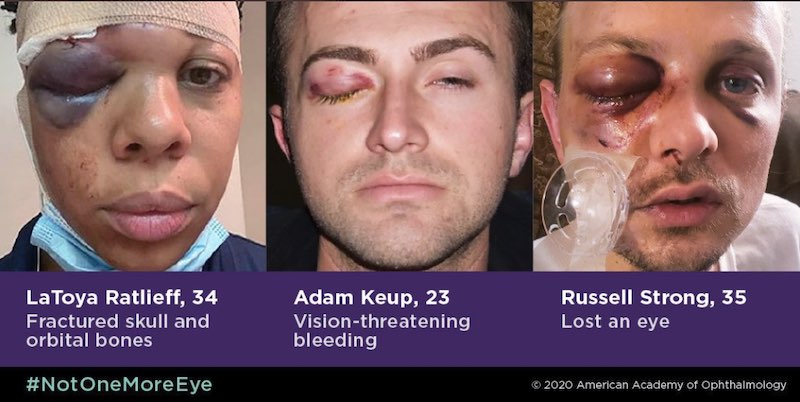
Graphic tweeted by AAO
Note: This story is part of our occasional coverage of eye injuries at protests which were not caused by a laser. This is because the number of actual or claimed laser eye injuries at protests (generally inflicted on police or security forces) is vastly outnumbered by actual or claimed eye injuries to protesters, journalists and bystanders (generally caused by police or security forces). In our view, no one should aim a laser or projectile at anyone's eye or head during protests, demonstrations and civil unrest.
US: 2019 laser incidents up almost 10% compared to 2018
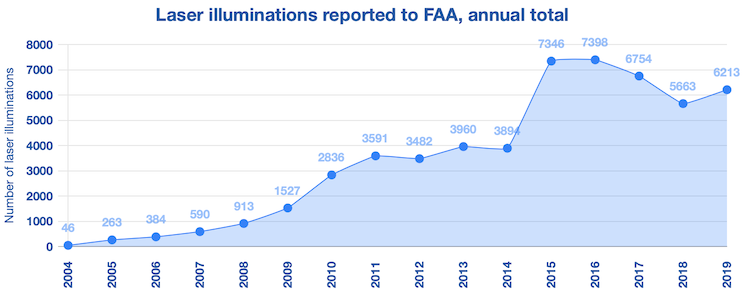
During 2019 there were 17 laser incidents reported each night in the U.S., on average.
This brings the 15-year total to 54,860 incidents since 2004 when FAA first started requiring pilots to report laser sightings or illuminations.
The majority of reports continue to involve green lasers (87.2% of 2019 reports). However, reports of blue lasers have risen steadily, from 2.9% in 2016 to 8.2% in 2019.
Holiday lights do not seem to be a significant problem. In 2019 there were only 11 reports (out of 6,213) involving Christmas or holiday laser light projections.
The number of incidents with reported eye effects or claimed injuries was 31 in 2019, a significant increase over the 23 reported in 2018. There were no serious or permanent injuries. The most-reported effect was being flashblinded and/or seeing spots. Six pilots had pain, burning or irritation in their eye. Only three pilots sought or considered seeking medical attention for their eye effects — the lowest number in the seven years analyzed by LaserPointerSafety.com (2011, 2012, and 2015-2019).
FOR MORE INFORMATION: Additional charts showing U.S. and other country laser illuminations, are on the Laser/aircraft illumination statistics page.
US: Bakersfield (Ca.) paper advocates restrictions on purchasing laser pointers
The paper suggests requiring retailers to restrict access, putting them in a cage or behind a counter in order to "take away the 'anonymous' nature of the purchase and drive home the serious concerns about their use.
From the Bakersfield Californian. The paper also ran a news story April 11 2019 about the hazards of laser pointer misuse against aircraft.
US: FAA warns against aiming holiday lasers into the sky
With the holiday season upon us, the Federal Aviation Administration (FAA) wants to make sure your laser-light displays are aimed at your house and not into the sky.
Each year we receive reports from pilots who are distracted or temporarily blinded by residential laser-light displays. You might not realize this, but a well-meaning attempt to spread holiday cheer has the potential to create a serious safety risk to pilots and their passengers flying overhead.
So please make sure all laser lights are directed at your house and not into the sky. The extremely concentrated beams of laser lights reach much farther than you might realize.
If we become aware that your laser-light display affects pilots, we’ll ask you to adjust them or turn them off. If your laser-light display continues to affect pilots, despite our warnings, you could face a civil penalty.
Laser strikes against aircraft continue to increase each year. Last year we received 6,754 reports of laser strikes against aircraft, a 250 percent increase since we started tracking laser strikes in 2010.
Intentionally aiming a laser at an aircraft is a serious safety risk and violates federal law. Many high-powered lasers can completely incapacitate pilots who are trying to fly safely to their destinations and may be carrying hundreds of passengers.
We work with federal, state, and local law enforcement agencies to pursue civil and criminal penalties against individuals who purposely aim a laser at an aircraft. We may impose civil penalties of up to $11,000 per violation. Civil penalties of up to $30,800 have been imposed by the FAA against individuals for multiple laser incidents.
US: FAA data shows lower numbers for 2015 and other years
The original, higher figure came from the December 31 2015 FAA Laser Report. This spreadsheet of laser incidents had 7,703 rows with each row listing one laser illumination report.
In January 2016, researcher Dr. Todd Curtis cleaned up the list and found 7,676 valid reports. (The clean-up criteria is not known.)
The FAA's new, lower number of 7,346 reports was first noticed by LaserPointerSafety.com in an April 10 2019 fact sheet released by FAA. The agency has a separate page with Microsoft Excel spreadsheets listing reported laser incidents for 2010 through 2018. The spreadsheet now online for 2015 has only 7,346 reports — not the 7,703 reports of the original December 31 2015 FAA spreadsheet.
LaserPointerSafety.com has analyzed some of the dropped reports. A few may be duplicates, but many appear to be valid reports dropped for an unknown reason.
LaserPointerSafety.com believes that the original 7,703 figure is closer to the actual number of laser illumination reports submitted by pilots in 2015. However, for consistency, as of May 5 2019, LaserPointerSafety.com is using the new April 2019 FAA numbers on various pages such as the Laser/aircraft illumination statistics page.
Note that there may be some website pages and some articles, scientific papers, etc. outside of the website which reference the original, pre-April 2019 numbers.
Changed numbers also for 2007, 2008, 2016 and 2017
The number of laser incidents reported in other years has also changed:
- 2007 was originally listed as having 639 reports; in April 2019 FAA said there were 590 reports.
- 2008 was originally listed as having 949 reports; in April 2019 FAA said there were 913 reports.
- 2016 was originally listed as having 7,442 reports; in April 2019 FAA said there were 7,398 reports.
- 2017 was originally listed as having 6,753 reports; in April 2019 FAA said there were 6,754 reports.
US: FAA credits "heightened public awareness" for lowering laser incident numbers in 2017 and 2018
Incidents reported to FAA have declined from 7,398 reports in 2016, to 6,754 reports in 2017, and 5,663 reports in 2018, the last full year for which statistics are available.
According to FAA, "the agency and law enforcement agencies are working hard to increase public awareness of the dangers posed by lasers."
The news item linked to a page entitled "Laser Incidents and Legal Interpretation of the Law", a new video published April 10 2019 on YouTube, entitled "Laser Strikes on Aircraft Pilots", and an April 10 2019 Fact Sheet on lasers.
One paragraph of the fact sheet says that "The FAA’s guidance for agency investigators and attorneys stresses that laser violations should not be addressed through warning notices or counseling. The agency seeks moderately high civil penalties for inadvertent violations, but maximum penalties for deliberate violations. Violators who are pilots or mechanics face revocation of their FAA certificate, as well as civil penalties."
From FAA news item "Outreach Helps Bring Laser Strike Numbers Down"
COMMENTARY FROM LASERPOINTERSAFETY.COM:
We are not aware of any recent (2015-2018) campaign by FAA to increase public awareness.
In 2014, there was a publicity campaign by the Federal Bureau of Investigation (FBI) in 12 U.S. cities between February 11 and April 11 2014, which offered a $10,000 reward for information about anyone pointing a laser at an aircraft. This was expanded nationwide between June 3 and September 1 2014. During 2014 there was a 12.8% decline in laser incidents compared to 2013. It is not known how much the FBI publicity campaign contributed to the decline.
In our view, there may be other reasons for the decline. For example, pilots may be tiring of reporting laser illuminations with no apparent follow-up or effect. This would lead to a decline in reported incidents.
We are not aware of any studies done to determine the reasons for declines in reported laser incidents.
To summarize, it seems incorrect to attribute the lower number of laser incidents to "heightened public awareness." In fact, there is some anecdotal evidence that publicity actually leads to copycat laser incidents.
US: MIT develops laser to deliver secret audio messages
Their paper describing this, "Photoacoustic communications: delivering audible signals via absorption of light by atmospheric H₂O", was published in January 2019. The abstract is as follows:
We describe a means of communication in which a user with no external receiver hears an audible audio message directed only at him/her. A laser transmits the message, which is encoded upon a modulated laser beam and sent directly to the receiver’s ear via the photoacoustic effect. A 1.9 μm thulium laser matched to an atmospheric water vapor absorption line is chosen to maximize sound pressure while maintaining eye-safe power densities. We examine the photoacoustic transfer function describing this generation of audible sound and the important operational parameters, such as laser spot size, and their impact on a working system.
The laser is said to be eye- and skin-safe. The system can currently send a sound up to 60 dB across a distance of 2.5 meters (8 feet). In the future they are hoping for a range of 100-500 meters (328-1,640 feet). It is useful for applications as diverse as notifying one person in a crowd, and for headphone-free listening. MIT is patenting the technology.
From R. Sullenberger, S. Kaushik, and C. Wynn, "Photoacoustic communications: delivering audible signals via absorption of light by atmospheric H₂O," Opt. Lett. 44, 622-625 (2019). A PDF of the article is here. News stories about this appeared in numerous publications including Digital Trends, Photonics.com and The Sun.
US: 2 Watt "laser bongs" for sale
The laser beam is so intense it is a diffuse reflection hazard. The bong comes with 2 pairs of protective eyewear.
![]()
The founder of the company said in a November 2018 email to Mashable that the laser is not dangerous but can sting if you get your hand in it "kind of like a magnifying glass."
In addition to the 445 nm blue laser and protective glasses, the app-controlled bong also has a rotating bowl and color-changing LEDs.
The product has been in the works for some time. According to Gizmodo, a January 11 2018 Instagram video from Silicon Cali's founder demonstrated a prototype laser bong available for pre-order. On January 23 2018, he wrote on Instagram about shipping time: "It’s just dealing with the FDA regulation and all the other requirements for manufacturing and selling a high powered class4 laser product in the USA that take the time."
It is not known when the late fall 2018 version officially went on sale.
At the company's website, as of November 5 2018 there is no mention of FDA certification nor any picture of FDA-required warning labels, though there is a description of "turn key ignition." In the photo above, a small key can be seen inserted into the bottom of the bong. Federal law requires a key or similar lock-out device to prevent laser devices from being turned on by unauthorized users.
Laser bongs are a relatively old idea among persons interested in high tech and recreational drugs. A web search turns up a July 30 2009 post to Grasscity Forums, linking to a YouTube video of a prototype LaserBong (different product) made by the chief engineer of Wicked Lasers. The video is now unavailable at YouTube. Other YouTube videos still online show, for example, a June 4 2013 video of a person using a handheld blue laser to ignite bong material.
From Silicon Cali with additional reporting by Mashable and Gizmodo.
US: DoD awards nearly $250 million in contracts for pilot laser eye protection
The contracts went to Gentex and to Teledyne Scientific & Imaging, and will be completed by September 2024.
Earlier, on August 10 2018, DoD announced a $49 million contract for the Flash and Laser Airborne Protection System, which provides for research, development and manufacturing of photonic resistant material to protect air crews from flash blindness. Photonic shielding is used on high-value military aircraft such as Air Force One, but is not in widespread use.
The contract went to UES Inc. of Dayton Ohio, and will be completed by November 2024.
According to an October 1 UPI story, "the Pentagon started moving on improved eye protection for pilots after the Chinese military reportedly used lasers against pilots from a base in Djibouti, as well as in the South China Sea."
From UPI (Oct 1 story about Gentex and Teledyne) and UPI (Aug 13 story about UES)
US: Advisory committee recommends pilot procedures, training and glare protection
ARP6378™ has three main parts:
- A description of how lasers can interfere with pilots’ vision and operational performance, and how pilots can reduce adverse effects.
- A recommendation for pilot training, including exposure to safe, simulated laser light in a simulator or other realistic flying environment
- A description of Laser Glare Protection eyewear and windscreen film, with recommendations for whether and how to use these.
The document was developed by the SAE G10OL “Operational Laser” committee over a two-year period. It is available for purchase from SAE for $78. A three-page preview, which includes most of the Table of Contents except the appendices, is here.
From SAE ARP6378™, “Guidance on Mitigation Strategies Against Laser Illumination Effects”, published June 2 2018. Available from SAE.org.
Click to read more...
US: Marines to buy 1,653 eye-safe laser dazzlers
- An infrared (1535nm) laser rangefinder determines the distance to a person or object. The closer the distance, the lower the laser power output.
- Near-field detection shuts off laser emission if a person or object is too close to the laser output aperture.
- A 3-axis gyroscope detects motion. If the Glare Recoil is suddenly moved, the laser shuts off until stability is resumed and an accurate determination of the distance to a person or object can be re-established: “This prevents hazardous irradiance in situations where Glare Recoil is moving faster than the laser rangefinder can detect objects and dose power output. This results in the prevention of eye hazard danger caused by rapid movement of the device (example: flagging) or improper situational awareness of the operator.”
With these technologies, the laser detects objects or people in the proximity of the beam and then self-adjusts the power output to maintain eye safety. The Nominal Ocular Hazard Distance is said to be 0 meters; the range is 10 feet to 10 miles.
Suggested uses include urban patrolling, cordon and search, crowd control, clearing facilities and security checkpoints.
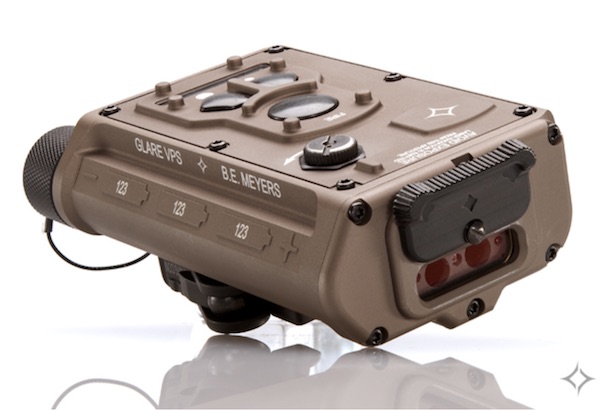
The Glare Recoil is about the size of a Walkman tape player at 5.5” x 3” x 2”. It can mount on a rifle or be handheld.
Meyers also sells a Class 1M “Glare Helios” which has an FDA variance allowing sales to U.S. local, state and federal law enforcement, and U.S. flagged vessels.
From Marine Corps Times, Soldier Systems, and B.E. Meyers. A video produced by the company goes into detail about the specifications and how the person/object detection works.
US: Low-cost malaria detector uses a laser pointer and a magnet
The portable device is about the size of a toaster. It “has been made simple enough to be used by everyone and is also compact and rugged so that it can be shipped worldwide.”
One of the principal researchers is working on making this commercially available.
Popular press account at CrazyEngineers.com. Scientific paper published May 21 2018: Rapid Diagnostic for Point-of-Care Malaria Screening, Samantha E. McBirney, Dongyu Chen, Alexis Scholtz, Hossein Ameri, and Andrea M. Armani, ACS Sensors Article ASAP, DOI: 10.1021/acssensors.8b00269
US: Air Force wants 38,000 more laser eye protection glasses and visors
While the original draft RFP was published for comments on March 27 2018, the revised request takes on additional urgency after the Pentagon on May 3 2018 accused China of aiming lasers at aircraft flying from a U.S. airbase in Djibouti. According to the Pentagon, two pilots had minor, short-term injuries as a result. The next day, China denied using lasers against aircraft in Dijibouti, calling them “groundless accusations.”
The current provider of the Air Force’s laser protection is Teledyne Scientific & Imaging, which was awarded a $30.1 million contract in July 2016 for 11.805 Aircrew Laser Eye Protection (ALEP) Block 2 glasses. The May 2 2018 RFP is for Block 3 glasses and visors. and will provide protection both during the day and at night from laser light.
The RFP’s Requirements Matrix does not specify the exact wavelengths to be blocked. It does say that the night version must have at least 50% visibility (Photopic Luminous Transmittance) and at least 14% for day versions. The document also states:
The ALEP Block 3 will not impair visual performance to the extent that it interferes with safety of flight or mission completion. The device will be visually compatible with the following devices/activities:
- All USAF aircraft
- Joint Helmet Mounted Cueing System (JHMCS); Night Vision Goggles (NVG); Panoramic Night Vision Goggles (PNVG), Helmet Mounted Integrated Targeting (HMIT/HoBiT), and fielded/post- Milestone B visors and aircrew chemical warfare masks
- Canopies/windscreens, HUD, and color cockpit displays
- Detection, recognition, identification, and tracking of targets
- Ability to distinguish terrain colors and geographical features
- Cockpit interior lighting, external aircraft lights, and airfield lights
- Ability to read charts, maps, and other printed materials in the cockpit
- Ability to perform normal aircraft duties in cockpit
From Jane’s 360 and the Air Force Aircrew Laser Eye Protection Block 3 IDIQ Draft RFP. When navigating the FRP webpage, note that there is the Original Synopsis dated March 27 2018 and the “Changed” version dated May 2 2018. There may be subsequent versions as well. The Statement of Work and the Requirements Matrix are the primary documents in the RFP.
US: $8 billion space telescope aligned for shipping with $70 hardware store lasers
The container was 100 feet long and had to fit with a clearance of about six inches on each side.
In testing the container’s fit in the C-5C, engineers originally used cameras to line up the container within 1/2 inch of the aircraft centerline. However, the camera method did not work in practice.
So lead project engineer John Andersen suggested using laser guides from a local home repair store. One laser would shine along the centerline of the floor, the other would mark the centerline of the back of the shipping container. As Anderson explained, “So, for about $70, we bought the laser guides, set them up, and we were able to load the container perfectly by following the laser lines.”
He added, “I’m glad we came up with a cheap solution to load the container on the aircraft using the lasers. It didn’t cost thousands of dollars to do it or a lot of time.”
The space telescope is scheduled to be launched from French Guiana in 2019.
From the Dayton Daily News
US: Coast Guard evaluating laser strike protection for cockpit use
The Coast Guard cannot use standard laser eye protection, such as is used in laboratories and industry, because it blocks too much light. One of the options the RDC is looking at is “a flexible optical filter that is reflective of lasers only and has just a slight tint, so it doesn’t interfere with the pilot’s visibility. The material can be applied to any transparent surface, such as the cockpit windshield, to deflect harmful laser beams and prevent them from reaching the inside of the cockpit.”
The chief of the Coast Guard’s Safety Program Management Division indicated eyewear or visors would be short-term solutions, and laser protective coatings for the aircraft would be a long-term solution.
According to Coast Guard information, “[o]nce finalized, the RDC findings will be integrated into an ongoing laser eye protection project the Office of Safety and Environmental Health is conducting in partnership with the Naval Aeromedical Research University in Dayton, Ohio, and the Air Force Research Laboratory at Wright-Patterson Air Force Base in Ohio.”
From a February 21 2018 blog post from the U.S. Coast Guard. Click the “Read more” link for the full blog text. Thanks to George Palikaras for bringing this to our attention.
Click to read more...
US: UPDATED - 6,753 laser/aircraft incidents reported to FAA in 2017; 9% lower than 2016
During 2017, there were 6,753 laser illumination incidents reported to the U.S. Federal Aviation Administration. This compares with 7,442 reports in 2016, and 7,703 reports in 2015. This is a 9% drop compared with 2016, and a 12% drop compared with 2015.
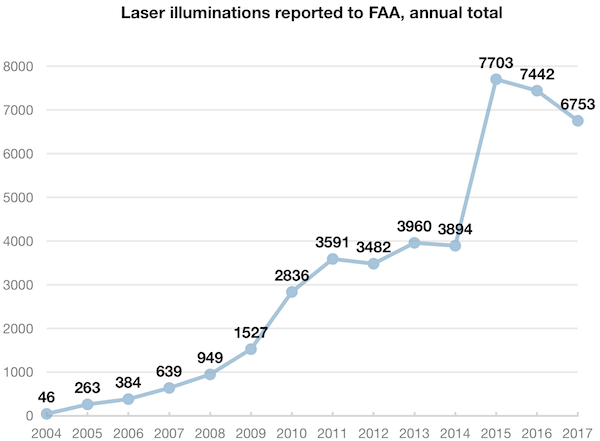
Here is the same data, plotted to show the average number of illuminations per day, during each year:
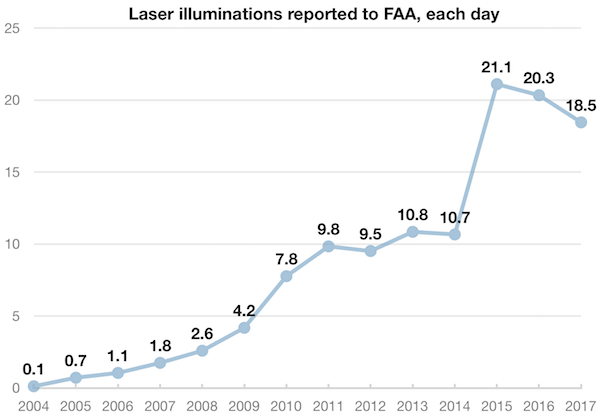
For additional charts and statistics, click the “read more” link.
US: MIT develops system to locate laser perpetrators using as few as two cameras, from miles away
The Laser Aircraft Strike Suppression Optical System (LASSOS) uses two or more low-light CCD sensor cameras that observe the night sky, each with a star tracker that determines the attitude of the sensor. The cameras observe a volume of airspace such as around an airport. Beam locations are identified by analyzing the two (or more) different views to find the endpoint of the laser beam.
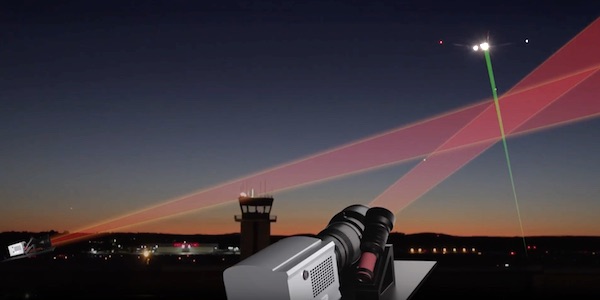
In one test, LASSOS identified the ground location of a laser beam aimed into the sky, using two cameras located nine nautical miles away. The locations was determined within 30 seconds. The system was so accurate that it could differentiate between locations separated by only 5 meters.
A key attribute of LASSOS is that the final output is a Google Earth map with the beam and perpetrator location overlaid. This makes it easy for law enforcement to know the area they will be searching for the perpetrator.
An MIT press release gave no indication of potential installation and operational costs, and did not indicate any further plans for testing or implementation.
LASSOS was developed under Air Force Contract No. FA8721-05-C-0002 and/or FA8702-15-D-0001.
From a September 2017 MIT Lincoln Laboratory press release, reprinted below (click the “read more” link.) MIT also has a YouTube video of the system; the LASSOS description begins about 56 seconds into the video. Thanks to Greg Makhov, who brought this to our attention via a Tech Briefs article printed in January 2018.
US: FDA recommends against using Laserworld and Ray Technologies laser projectors
Laserworld set up a special website, www.cdrh.info, with a statement and information from their viewpoint.
The International Laser Display Association published guidance for ILDA Members and others who are doing shows in the U.S. with Laserworld and RTI projectors.
US: FDA recalls certain X-Laser light show projectors
FDA listed the following actions:
X-Laser LLC will bring into compliance:
1. All purchasers and associated dealers of affected LLS projector models will be notified by mail and email of their failure to comply with the performance standard. The notification will follow the format and include the information required by 21 CFR 1003.21. Those that do not respond within 14 days will be notified a second time. Those not responding to the second attempt will be notified again every 6 months for the next 2 years. Non-responsive dealers will be ineligible for future orders.
2. All affected LLS projectors will be repaired by removing the auto and music modes from the dipswitch accessible settings, after which, these modes will only be accessible through the DMX connection. These actions, including transportation of the LLS projector, will be made free of charge.
3. All LLS projector models that X-Laser receives, regardless of purpose, will be checked for dipswitch accessible auto or music modes and repaired if needed.
4.Corrective actions will be completed within 120 days of receipt of this letter.
For further questions please call (866) 702-7768.
For additional details from X-Laser, click the “read more” link. Click to read more...
US: Artist uses sixteen 1.2 watt lasers to make "wormhole" sculpture
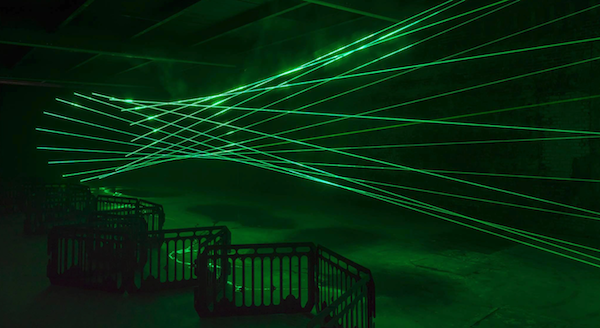
Particulates by Rita McBride
Spectators are prevented from accessing the beam by means of a fence-like barrier.
Artist Rita McBride created Particulates out of her interests in space, time travel and quantum physics. From the exhibition brochure:
“The 2017 commission by Rita McBride, Particulates, features a type of high-intensity laser that is normally reserved for industrial, military, and scientific use to harness light’s efficient capacity to articulate space. At first glance the lasers clearly define the geometry of a hyperboloid of revolution, a hyperbola rotated around a single axis. Yet the contours of this shape are dispersed by the constant motion of particulate matter—ambient dust and molecules of water circulating in the air—that becomes visible as it passes through the beams of light….. However, the real and imaginative spaces conjured by Particulates remain elusive, and are protected by a series of custom carbon-fiber panels, titled Guidance “Barriers” (2017), which the artist designed to keep us at a lawful distance.”
It is on exhibition at the Dia:Chelsea from October 27 2017 until June 2 2018. CT Lasers provided technical support.
From Engadget. Photo by the artist.
US: FAA issues warning about holiday laser lights
Enjoy Your Holiday Laser-light Display Responsibly
Each holiday season for the past several years, the Federal Aviation Administration (FAA) has received reports from pilots who said they were distracted or temporarily blinded by residential laser-light displays.
The FAA's concerns about lasers – regardless of the source – is that they not be aimed at aircraft in a way that can threaten the safety of a flight by distracting or blinding the pilots. People may not realize that systems they set up to spread holiday cheer can also pose a potential hazard to pilots flying overhead.
So if you’re going to install a holiday laser-light system, please make sure the lights are hitting your house and not shining up into the sky. It may not look like the lights go much farther than your house, but the extremely concentrated beams of laser lights actually reach much further than most people think.
If the FAA becomes aware of a situation where a laser-light display affects pilots, we start by asking the owner to adjust them or turn them off. However, if someone's laser-light display repeatedly affects pilots despite previous warnings, that person could face an FAA civil penalty.
Note: The FAA press release was reprinted in a number of news sources including KUSA, the News Tribune and SFGate.
LaserPointerSafety.com has a separate story about the number of FAA laser incident reports in 2017 due to actual or suspected holiday light displays.
US: Nationwide recall of Santajoy Christmas laser lights sold at Walmart
On Dec. 22, 2017, Santajoy initiated a nationwide recall of Galaxy Holiday Laser Lights and Northern Lights Holiday Laser Lights. These laser projection products may incorporate a laser having a higher output than intended and fail to comply with FDA performance standard requirements (21 CFR 1040.10 and 1040.11). These higher-power lasers have the potential for eye injury.
Consumers who purchased any of the 5,254 units of Galaxy Holiday Laser Lights and Northern Lights Holiday Laser Lights sold by Walmart between August 1, 2017 and October 25, 2017 should stop using them and return them to any Walmart store for a full refund.
The Galaxy Holiday Laser Lights and Northern Lights Holiday Laser Lights were manufactured from May through September 2017 and distributed from August through October 2017. The affected products sold by Walmart can be identified by the packaging photos and UPC numbers shown below.
Santajoy voluntarily recalled these products after becoming aware that the product presented a potential safety hazard and has notified the FDA of this action. There have been no reports of injury related to the use of these products. Santajoy is notifying the public through this press release, and Walmart is accepting the return of these products for a full refund.
Walmart Stores Inc. distributed these products nationwide. Consumers with questions may contact Walmart via telephone at 1-800-Walmart from 7 a.m. to 9 p.m. CT Monday through Friday or online at www.corporate.walmart.com/recalls for more information.
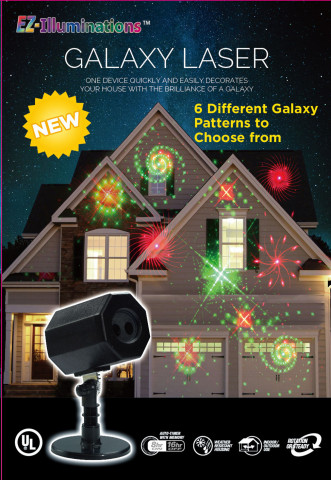
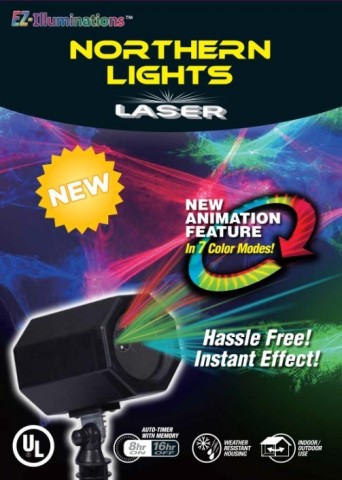
Note: As of January 1 2018, neither laser was listed on the Walmart Product Recalls webpage. The product recall also did not appear to be at FDA’s recalls webpage or enforcement report webpage, as of January 1. The only online source on that date was the December 22 2017 Business Wire press release, or a few publications and news sources such as KCTV that reprinted the Business Wire press release.
US: FDA issues warning about laser toys
FDA gave these examples of laser toys:
- Lasers mounted on toy guns that can be used for “aiming”;
- Spinning tops that project laser beams while they spin;
- Hand-held lasers used during play as “light sabers”; and
- Lasers intended for entertainment that create optical effects in an open room.
According to the Consumer Update, “Toys with lasers are of particular interest to the FDA because children can be injured by these products. Because they are marketed as toys, parents and kids alike may believe they’re safe to use.”
The FDA had tips for safe use, including:
- Do not aim at persons or animals
- Do not aim at any vehicle, aircraft or shiny surface; or persons playing sports
- Children’s toy lasers should be Class I.
- Children should not be allowed to own or use laser pointers. Pointers are not toys.
- Do not buy or use any laser that emits more than 5 milliwatts.
- See a health care professional in case of a known or suspected laser eye injury.
The FDA’s health warning was referenced in numerous news and publication sources over the 2017 holiday season.
From the FDA Consumer Update, “Laser Toys: How to Keep Kids Safe”. FDA also linked to a 2015 FDA YouTube video on laser pointer safety.
For background, LaserPointerSafety.com has a series of webpages about laser toys which begin with a summary here.
US: FAA requests comments by Oct 31 2017 regarding form used to report outdoor laser operations
The form is filled out by commercial and professional users who want to operate lasers outdoors, including laser light shows, observatories, LIDAR operators, and satellite communications.
According to FAA, there have been about 400 laser operators who filled out the form. The agency also says it takes 4 hours to gather information needed for the form and to fill it out.
FAA needs to periodically review whether the form is useful and whether the 4-hour estimate is accurate. The deadline for comments is October 30 2017.
The August 31 2017 Federal Register notice states:
“In accordance with the Paperwork Reduction Act of 1995, FAA invites public comments about our intention to request the Office of Management and Budget (OMB) approval to reinstate a previously approved information collection. In order for the FAA to ensure safety it proposes to collect information from potential outdoor laser operators. The FAA will review the proposed laser activity against air traffic operations and verify that the laser operation will not interfere with air traffic operations.”
The notice details what information specifically is requested:
“You are asked to comment on any aspect of this information collection, including (a) Whether the proposed collection of information is necessary for FAA's performance; (b) the accuracy of the estimated burden; (c) ways for FAA to enhance the quality, utility and clarity of the information collection; and (d) ways that the burden could be minimized without reducing the quality of the collected information. The agency will summarize and/or include your comments in the request for OMB's clearance of this information collection.”
Form AC 7140-1 does not impact laser pointer users per se, but it can affect professional outdoor laser users.
- The most impacted are outdoor laser light show operators. They are required by the Food and Drug Administration to submit their shows to FAA, and to receive a “letter of non-objection” from FAA, before FDA will grant permission (a “variance”) for a show.
- All other outdoor users are requested to submit Form AC 7140-1, but are not legally required to do so. This is because FAA has no regulatory authority to restrict outdoor laser usage. There may be organizations such as NASA or observatories that have internal requirements to submit AC 7140-1 and receive a letter of non-objection. This is usually done in the spirit of cooperation and/or to help avoid liability issues in case of problems.
Additional information, including instructions on how to submit comments, is at the Federal Register notice webpage. LaserPointerSafety.com has a webpage with suggested corrections to Advisory Circular 70-1, and advice on filling it out.
US: Apple repair guidelines include laser damage to iPhone cameras
A few pages and graphics were leaked from a 22-page Apple document, the March 3 2017 “Visual/Mechanical Inspection Guide,” including this page showing the service eligibility for common problems:
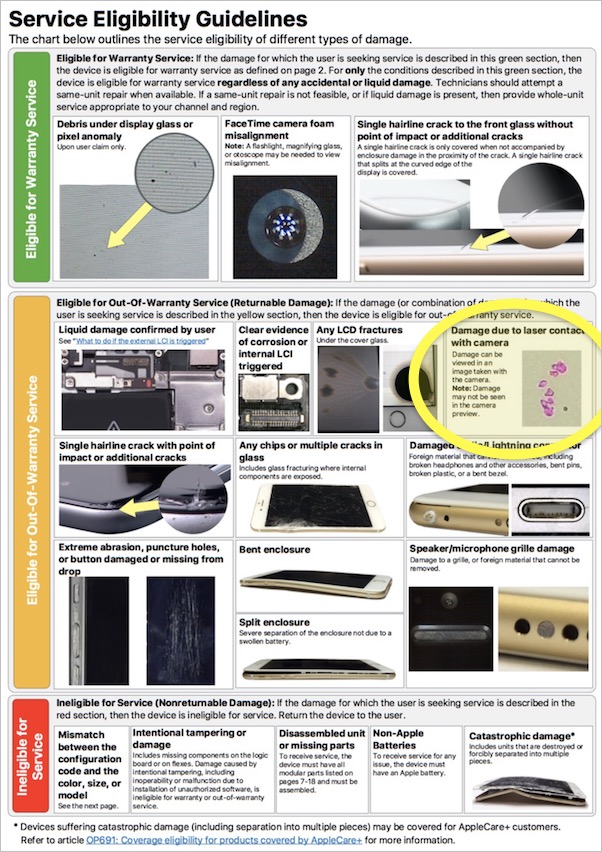
The page lists common items such as liquid damage, broken screens, cracks — and “Damage due to laser contact with camera.”
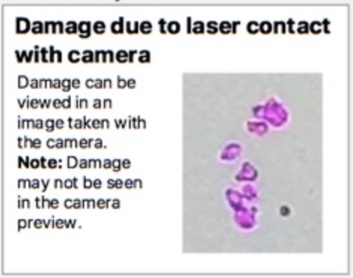
It is likely that elsewhere in the leaked document are details about the laser damage, along with other example photos. However, only a few pages of the document were publicly revealed.
A page like this was first revealed in 2014. The document leaked September 1 2017 covers Apple’s most current iPhones: 6, 6S, 7 and associated “Plus” versions.
From Business Insider via MacRumors.
US: Utah National Guard reluctant to report laser cases to FBI, apparently after suspect's suicide
In an interview, Chief Warrant Officer Robert Williams discusses the hazards of laser interference with pilots. He recounts an episode in mid-July 2017 where he and a co-pilot were lased. They identified the source of the laser beam. Ground officers found that the perpetrator was a teenager. Williams said “We specifically requested that the cops not get the FBI involved. I don’t want any kids going to jail or getting felony charges on their record.”
He added, “When the cop showed up at the door and explained to the dad what was going on, the dad broke the kid’s laser there on the spot.”
The reluctance to report appears to stem from a 2009 lasing incident which was reported to the FBI. A 30-year-old man, Joshua Don Park, “on a whim” decided to aim a cat laser pointer at a Utah National Guard helicopter. Park told arresting officers that he was unaware the laser’s light could interfere with pilots’ operations. The Journal story says Park “faced up to five years in prison. [Another source says he faced up to 20 years.] Tragically, he committed suicide shortly before he could be sentenced.”
The story continues, “Since that sobering incident, no Utah National Guard pilots have reported lasing incidents to the FBI—but not for lack of occurrences. ‘My unit alone has had two incidents in the past three months,’ said Williams.”
From the South Valley Journal. More details about the original February 2009 lasing and September 2009 suicide are here.
US: Mosquito-targeting laser still not ready
How has the “Photonic Fence” device progressed? The short answer is that it is still being developed. It is just about to have its first excursion outside the lab.
In a 2,500-word article in the July 24 2017 New York Magazine entitled “Where’s Our Laser-Shooting Mosquito Death Machine?” writer Carl Swanson looked into the Photonic Fence progress.
Swanson visited Myhrvold’s company Intellectual Ventures. He watched a demonstration which he says “is, as you might expect, enormously satisfying. There is the laser itself, aimed by a mirror that is synced to a camera that identifies the pest marked for death based on its shape and size and the distinctive beat of its wing, and a monitor that allows you to watch its autonomous targeting. And it does so fast: 100 milliseconds is the time allotted to see the bug and shoot it for the 25 milliseconds it takes to kill it.” He said the system has killed more than 10,000 mosquitos in the lab.
But the mosquito-targeting system is still in the testing phase. Swanson notes “It’s taken years of development to figure out how to continuously track and identify a specific type of insect and then dispatch it safely and efficiently.”
Eye safety for humans is one consideration: “For instance, for the demonstration, I had to wear protective goggles since that type of laser is not safe for your eyes; I was assured that when it’s market-ready, the laser they deploy will not potentially blind human passersby.”
A major barrier is cost: “And no one has yet worked out how to make the device cheap enough to be useful in the places it is most needed, places where most people’s mosquito-defense system consists of sleeping under nets every night.”
The system “will finally be tested later this summer in Florida, in a screened-in structure, against the Asian citrus psyllid, an invasive bug that is devastating the state’s orchards.” If that goes well, it will then be tested in the open.
From New York Magazine
US: Survey paper says "Injury from laser pointer trauma is a public health problem on the rise"
It begins by summarizing misuse in sports, and in the thousands of incidents per year in the U.S. where lasers are aimed at aircraft.
The authors, Dr. Gregory D. Lee and Dr. David R. Lally, then write “Perhaps the greatest concerns are raised by reports of unsupervised children who have received these lasers as toys or gifts and expose themselves to the laser beams, causing permanent retinal injury with reduced central vision. From 2000 to 2009, there were five reports of 18 patients with injuries due to laser pointer exposure.”
They discuss the types of injuries (thermal, photochemical and mechanical) and locations of retinal injuries. There is a listing of laser classes, with “pointers” — Class 1, 2 or 3R (IIIa) — being distinguished from similar-looking but more powerful Class 3B and 4 “handheld” lasers.
The authors conclude as follows:
“Inappropriately used class 3B or 4 lasers should be considered weapons that can cause serious, permanent bodily injury. Even brief exposures to diffused rays of laser beams can cause temporary flash blindness that may last for hours in airline pilots, endangering the lives of passengers, particularly during takeoff and landing sequences. Cases of short-range laser exposure are becoming more common, often involving children who are inappropriately given these devices as toys, and these patients are referred to retina specialists after the damage has already occurred.
“No definitive experimental study, case report, or animal model has shown improvement in these injuries with any type of treatment, but typically these patients are treated with a short course of corticosteroids or nonsteroidal antiinflammatory drugs. Secondary choroidal neovascularization has been treated successfully with intravitreal anti-VEGF agents.13,14
“Clinicians, particularly retina specialists, can raise awareness of this rising public health issue by educating patients and parents about the hazards of laser pointers. Legislation is currently being written to impose stronger regulations on the distribution and sale of these devices. If a patient presents with findings of a laser-related retinal injury, clinicians should report the incident to the FDA so that investigations can be performed into the manufacturers of these devices. Reports can be made at www.fda.gov/downloads/AboutFDA/ReportsManualsForms/Forms/UCM236066.pdf.”
From Retina Today
US: Navy tests green beam across Chesapeake Bay
The information was released to help reassure any residents who might see the beam. The Navy called the beam “eye-safe” and said the beam would be turned off if an aircraft or watercraft is within 300 meters.
The purpose of the test is to “evaluate the performance of a laser system at long range over water,” according to a spokesperson. The laser would be aimed from the source to a target as far as 13 miles away.
There was speculation that the laser was 150 kilowatts, based on an earlier speech by the vice chief of naval operations. However, the spokesperson said the June 27 test would not be using the 150 kW laser.
From the Baltimore Sun, WTOP and the town of Morningside, Maryland
US: UPDATED - 2017 laser incidents on pace to be lower than 2016
As of June 30 2017, there were 2,933 laser illuminations of aircraft reported to the U.S. Federal Aviation Administration. This is 15% fewer than the 3,441 illuminations reported as of June 30 last year (2016).
The chart below shows cumulative laser illuminations for the period Jan. 1 - June 30, for each of the past 10 years. The blue 2017 line shows that thus far there have been fewer incidents in 2017 than in 2016, but more than in 2015.
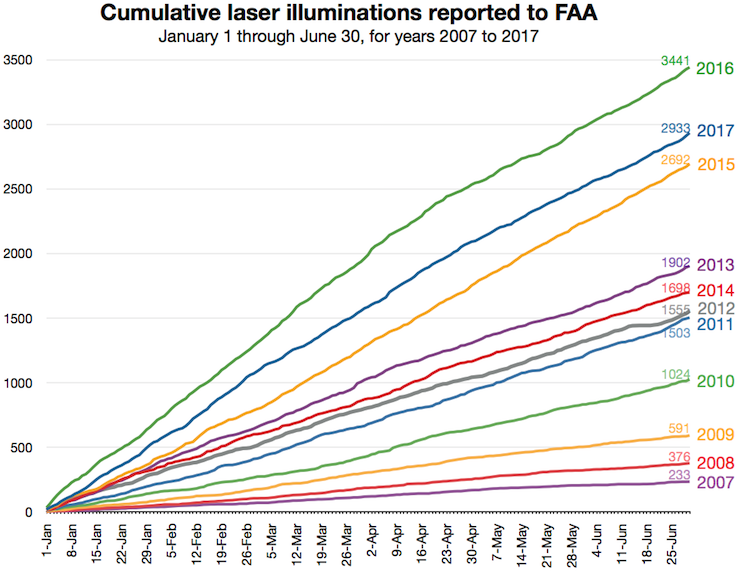
How to read this chart: Each year starts with 0 illumination reports. Each colored line then plots the cumulative (year-to-date) illumination reports for that year since January 1. For example, looking at the 2016 top green line, there were about 1000 reports between Jan. 1 and Feb. 12 (where the green 2016 line crosses the 1000 horizontal line). In contrast, in 2013 (purple line) there were roughly 500 reports between Jan. 1 and Feb. 12 (where the purple 2013 line crosses the 500 horizontal line).
Based on historical data, LaserPointerSafety.com projects that there will be around 7,200 laser illuminations reported to the FAA in 2017. This would be about 4% lower than the 7,442 reports in 2016, and about 7% lower than the 7,703 reports in 2015.
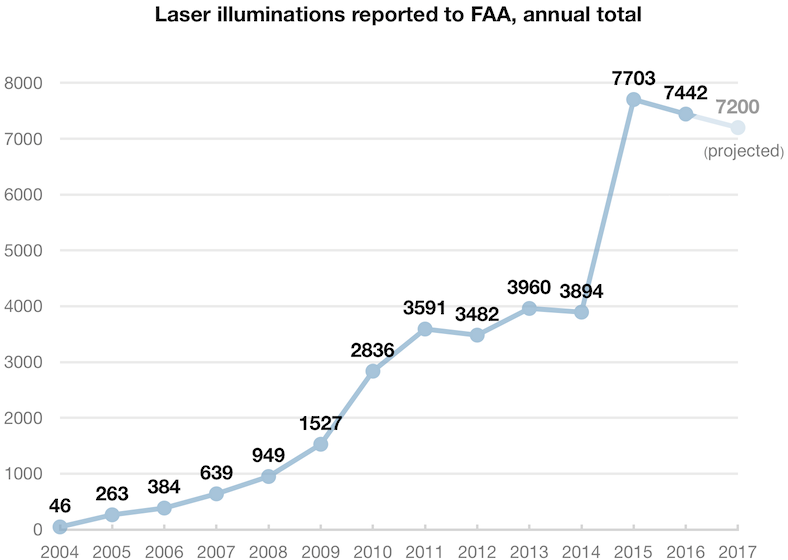
The next chart shows the number of laser illuminations per day. Each line is a different year. The lines have been smoothed by averaging the previous 30 days (a 30-day moving average). For this reason, the lines do not start until January 30.
This shows trends within a year. For example, in both 2016 and 2017 the number of reports dropped significantly in early May, while in 2015 the number of reports was more constant during that period.
The chart below shows the number of laser illuminations for every single day between Jan. 1 2007 and April 29 2017. The light spiky line shows each day’s illumination reports. This number can vary widely from one day to the next. The dark line is a 60-day moving average. This helps smooth out the data, in order to show longer-term trends.
From these charts, it can be seen that illumination reports grew slowly, or even declined, in the first few months of 2015, 2016 and 2017. However, in the final months of 2015 and 2016, the number of illumination reports picked up significantly. The estimate above (that there will probably be around 7,200 reports in 2017) takes this effect into account.
Statistical note: The careful reader will see that the blue 2017 line in the first chart falls between the 2016 and 2015 lines. Yet LaserPointerSafety.com predicts 2017 as a whole (Jan-Dec) will be lower than both 2016 and 2015. This is because we used all ten years, 2007-2016, to estimate the year-end total as a proportion of the first six months. Both a simple average of these ten years, and a weighted average — where more recent years have a larger effect — indicate that the 2017 total will be in the ballpark of 7,200 illuminations. In other words, 2015 was an atypical year where illuminations in the last eight months of the year grew much faster than any other year.
US: Editorial wants warning labels on lasers
The editorial notes that in the late 2000s, New Jersey beachfront cities had problems with widespread laser sales — followed by widespread misuse. Ocean City NJ banned laser sales and possession in the summer of 2010, as did another Jersey Shore city, North Wildwood, a few years later.
The paper wrote “Apparently, coverage of the incidents and bans was enough to spread the word that pointing lasers at aircraft is dangerous and illegal, as incidents in the area greatly diminished.”
The editorial then noted that despite this local decrease, there are “still about 7,000 reports of lasers aimed at aircraft each year [in the U.S.].”
The article concluded with the suggestion to “[r]equire a warning about the five years in prison and $250,000 fine on every laser for sale (on the packaging or on a handout to the buyer).”
From the Press of Atlantic City
US: New Michigan law targets directed energy aimed at aircraft, trains
The bill was introduced February 27 2017 after a number of laser pointer incidents in the state.
Although there is a similar federal law (5 years in federal prison and fine up to $250,000), the legislators who introduced the Michigan bill said the state can now prosecute, whether or not federal officials choose to prosecute. Prior to passage of the law, state or local law enforcement could not arrest laser perpetrators unless they committed a separate offense under state or local law.
The bill makes it illegal to intentionally aim “a beam of directed energy emitted from a directed energy device at an aircraft or into the path of an aircraft or a moving train.” The bill defines “directed energy device” as “any device that emits highly focused energy and is capable of transferring that energy to a target to damage or interfere with its operation. The energy from a directed energy device would include the following forms of energy:
-- Electromagnetic radiation, including radio frequency, microwave, lasers, and masers.
-- Particles with mass, in particle-beam weapons and devices.
-- Sound, in sonic weapons and devices.”
As with the federal law, there are exceptions in the bill for FAA and DOD authorized users, and for persons using a laser emergency signaling device to send an emergency distress signal.
There were actually two bills introduced by Republican state representatives Laura Cox and Tom Barrett. House Bill 4063 made it a crime to aim directed energy at aircraft or a moving train. HB 4064 also adds the laser provisions to sentencing guidelines.
HB 4063 originally passed the House March 16 2017 by a vote of 107-1. An amended version passed the Senate April 25, 111-37 and passed the House May 2, 105-2. It was sent to the Governor on May 4.
From the Detroit News (March 16 story, May 2 story), U.S. News and World Report, and the Michigan legislature website page for HB 4063.
US: Student develops experimental laser location detection device
The system is intended for use in cockpits, and is self-contained — it does not need to interface with any aircraft instruments. For location, altitude and orientation data, it has a GPS and a 3-axis magnetic compass.
A laser is detected by a camera sensor, currently with 1024 x 1024 pixel resolution. The camera detects the bright “bloom” from a direct or near-direct laser illumination (left image, below). To distinguish laser light from a bright non-laser light such as the sun, it looks at surrounding pixels to see whether they saturate the green channel of the sensor. (The system currently looks only for green laser beams since those represent over 90% of FAA-reported laser incidents. But future versions could look for other color laser beams as well.)
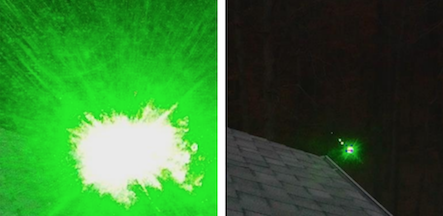
As the laser aims away from the camera, the bright center of the laser is still visible (right image, above). The system then looks at the center of the bright area to find the pixel location. Knowing the camera’s orientation, location and altitude, a Raspberry Pi computer running a Python program written by Hough calculates the approximate location. This is automatically sent via text message to pre-programmed recipients which could include law enforcement.
In ground testing on a slope, at a relatively short distance, the error was 15 meters. As the photo diagram shows, the system was successful in determining an approximate distance and location.
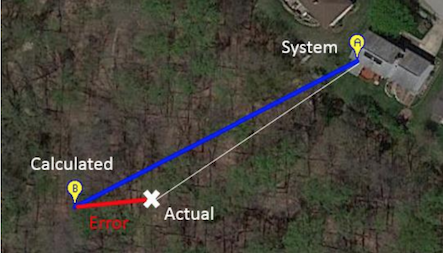
Hough notes that the system is a low-cost proof-of-concept. Suggested improvements include “more precise location sensors [that] would improve target location accuracy. Tapping into the high quality compass and GPS sensors on a commercial aircraft, for example, would drastically improve the ability of the system.” He also stated that smartphones include all the equipment needed: camera, compass, GPS, processor and display. So it should be possible to make a smartphone application to accomplish the same task.
From “Detection and Location System for Laser Interference with Aircraft”, December 2016. Thanks to Nate Hough for bringing this to our attention and allowing us to host the PDF. Note: A similar system, which does not calculate the laser source location, is the Laser Event Recorder.
US: Study shows FAA-reported eye effects or injuries for four recent years
The data shows that pilots reported eye effects or injuries in less than 1% of laser illumination incidents. Flashblindness was the most-reported effect, followed by “Pain, burning or irritation in eye.” Blurriness was also frequently listed, along with unspecified “eye injury.”
In 20% of eye effect/injury cases, the person affected sought medical attention.
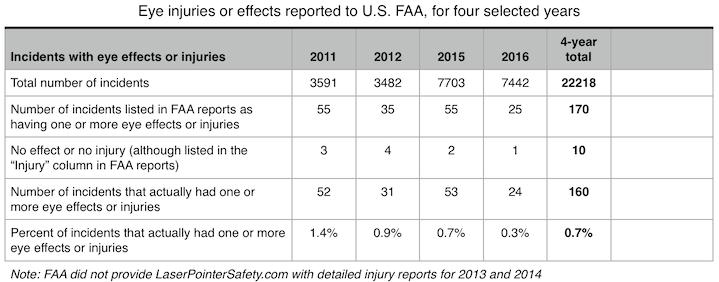
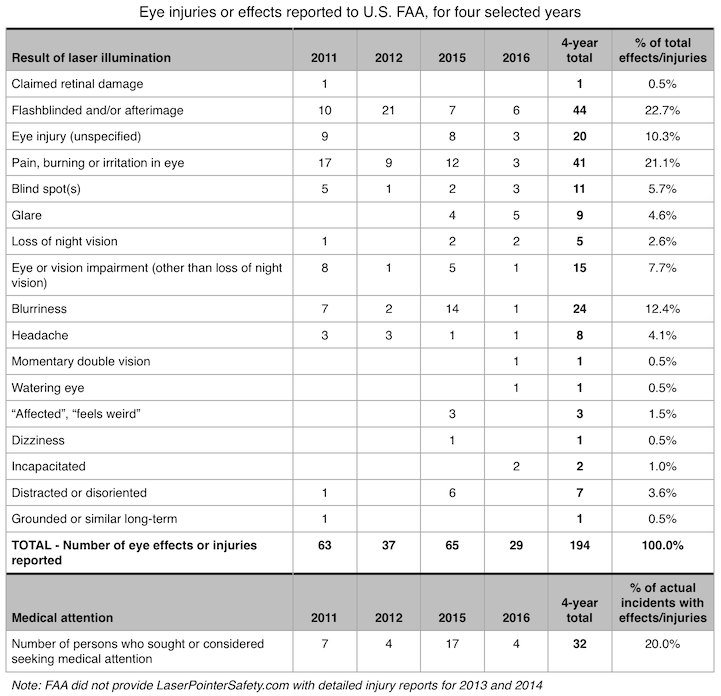
From the FAA weekly Laser Report
US: UPDATED - 7,442 laser incidents in 2016; slight decrease compared to 2015
According to FAA data, there were 7,442 laser illuminations reported by pilots in 2016. This is a slight decrease of 3.5%, compared to 2015. However, both 2015 and 2016 had far more incidents than the previous four years, 2011-2014.
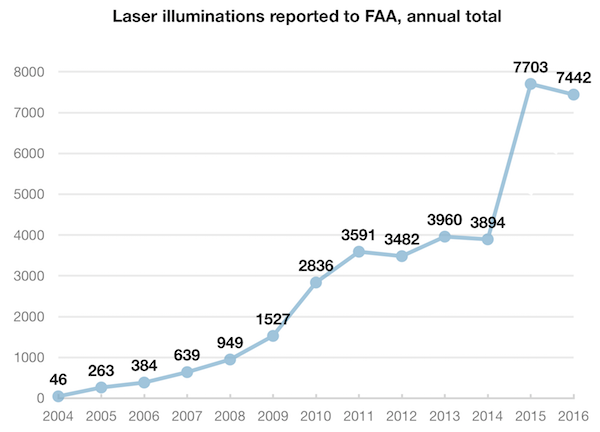
Here is the same data, arranged to show the average number of incidents per day:
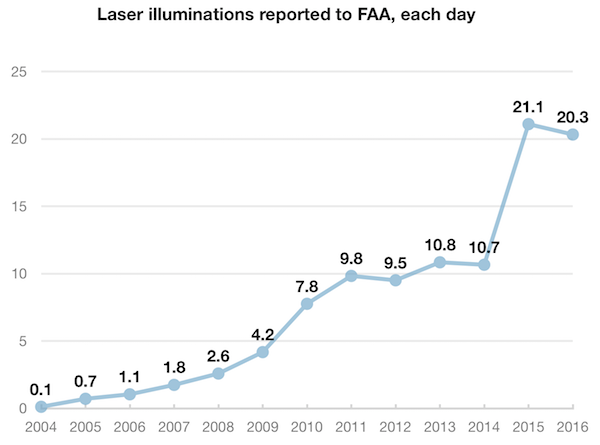
Laser color(s)
As in previous years, green was by far the most-reported color:
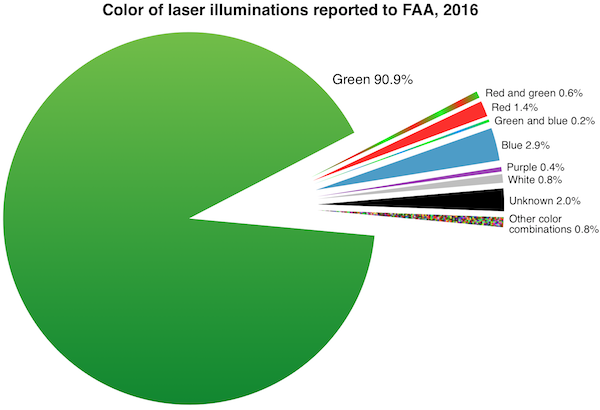
An October 2016 U.S. Food and Drug Administration proposal would allow the manufacture of laser pointers only in the 610-710 nanometer wavelength (orange-red to deep red). This chart shows the 2016 laser illuminations arranged according to those colors:
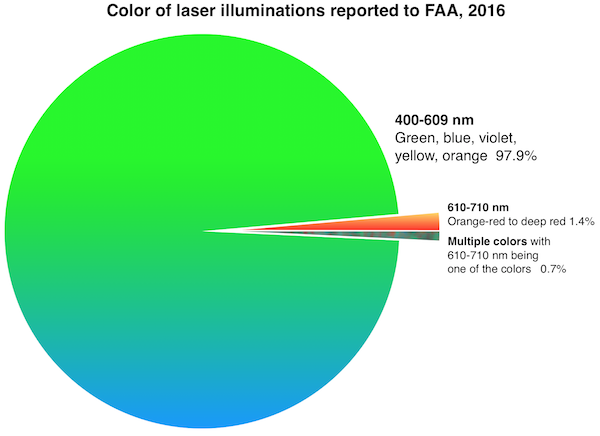
Eye injuries or effects
There were 24 laser illumination incidents in 2016 where eye effects or injuries were listed. This is 0.32% of the total number of incidents. These are the effects listed; the total adds up to more than 24 due to multiple effects in some cases.
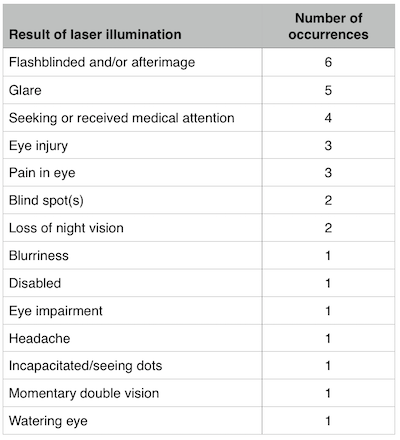
From the FAA weekly Laser Report, January 9 2017 with data January 1 - December 31 2016
US: Amazon aggressively lowers pricing on Star Shower home laser projectors
A December 14 2016 article in the Wall Street Journal describes a price war between sellers of the updated Star Shower Motion, which adds movement to the laser dots.
The list price from Telebrands was $49.99. It appears they lowered the price to around $35, then Amazon and other retailers lowered their prices to $31-33. The wholesale price of the Star Shower Motion is around $30, meaning that Amazon is barely making money on selling this laser projector.
For consumers this may be good news. However, Telebrands is watching a major distributor undercut its own pricing. And, the lower prices are putting more laser projectors in the hands of consumers.
From the Wall Street Journal (subscription required). Summary at Consumerist. LaserPointerSafety has run previous stories about he Star Shower, since they first became popular in 2015. Click for stories about aviation incidents and for general stories about the lights and their potential hazards.
US: FAA Eastern Region warns against holiday & Christmas laser light display misuse
The full text of the statement is as follows:
“The FAA’s concern is that lasers -- regardless of the source -- not be aimed at aircraft where the beams can threaten the safety of a flight. Consumers who buy laser light displays should take precautions to make sure that the lights are hitting their houses and not shining off into the sky. In situations such as this, we would start by asking the person to either adjust them or turn them off. For more information on lasers, please go to www.faa.gov/about/initiatives/lasers/“
From an FAA Eastern Division email to LaserPointerSafety.com, and from the Boston Globe. LaserPointerSafety has run previous stories about Christmas and holiday laser lights such as the Star Shower, since they first became popular in 2015. Click for stories about aviation incidents and for general stories about the lights and their potential hazards.
US: Bird wearing tiny goggles safely flies through laser beam
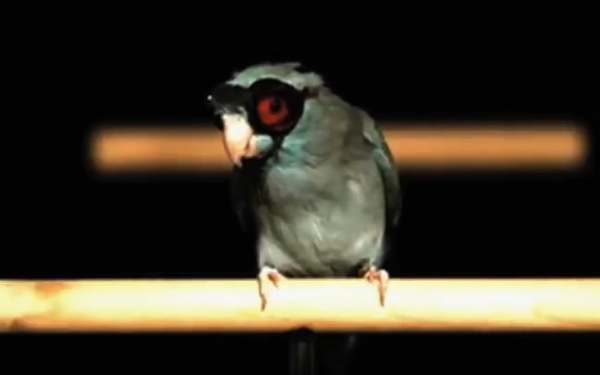
Researchers at Stanford University wanted to get data on how much lift a bird generates. To monitor the wing wake and vortices, they used a laser beam spread by a lens into a plane of light. The light source was a Litron brand double-pumped Neodymium-doped yttrium lithium fluoride (Nd:YLF) laser. The light was green at 527 nanometers, and had a pulse repetition rate of 1 kHz.
A non-toxic mist in the air illuminated the light sheet, just like theatrical fog used at concert laser light shows. As the bird flew through the light, the mist scattered and showed the air patterns, in a technique called “particle imaging velocimetry” or PIV.
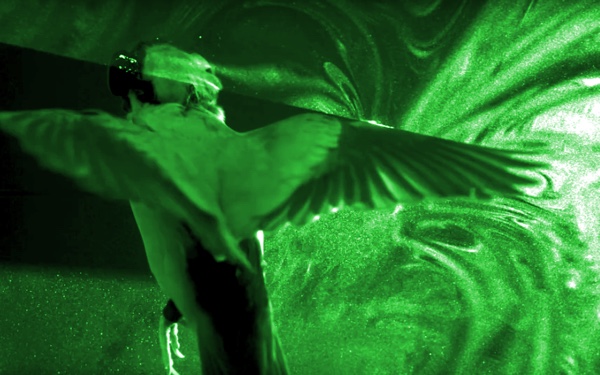
Bird-sized goggles were used to prevent any harm to the bird’s eyesight. The lenses came from human laser safety glasses and had an optical density of 6, meaning that they transmitted only 0.0001% of the laser light. The frame was 3D printed and was held on by veterinary tape. The goggles weighed 1.68 grams, which is roughly 6% of the bird’s body weight (equivalent to 9 pound glasses on a 150 lb. human).
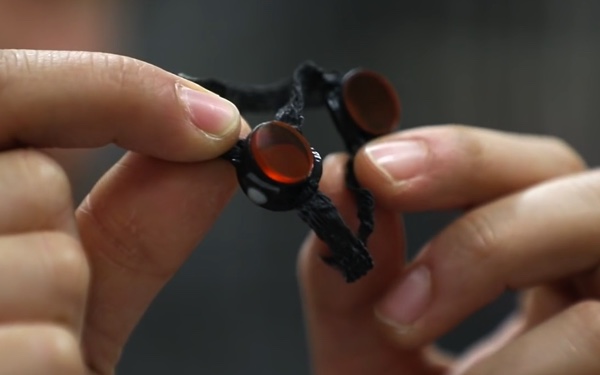
Before beginning the series of experiments, the researchers trained four parrotlets “through many small stress-free steps of habituation.” After “several months of effort” with the birds, only one — a parrotlet named “Obi” — voluntarily flew with the laser goggles. According to the researchers, “[a]ll training and experimental procedures were approved by Stanford's Administrative Panel on Laboratory Animal Care.”
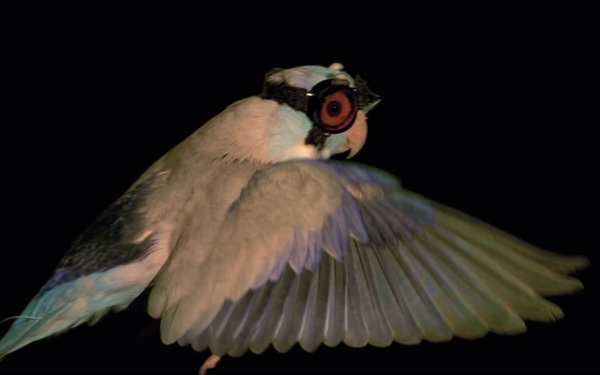
Twelve cameras were used. Four high-speed stereo cameras were for PIV particle motion recording and recorded 4000 frames per flight. Eight cameras were for recording Obi’s wing and head kinematics as it flew from one perch, through the laser light plane, to a landing perch.
The results give “the clearest picture to date of the wake left by a flying animal.” Unexpectedly, the wing tip vortices did not stay stable as happens with aircraft, but instead broke up quickly and violently. This had not been predicted by any previous models.
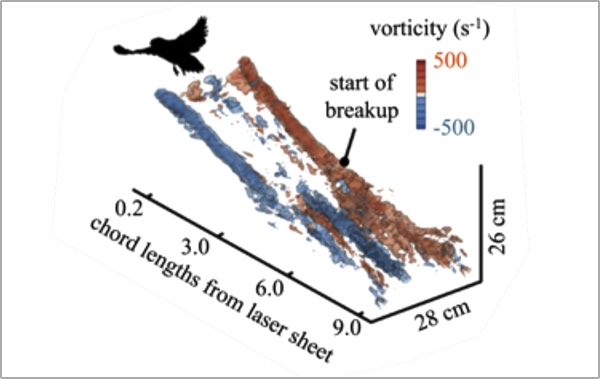
From a Stanford University news story, picked up by numerous websites and news outlets including Popular Mechanics, NBC News, The Verge, Optics.org and many others. The results were published December 6 2016 in the journal Bioinspiration & Biometrics, volume 12, number 1. Thanks to Drs. Ronald K.A.M. Mallant, MSc. for pointing out an error in our description of OD 6 density; the error has been corrected.
US: Airport police can go off property to find laser attackers
The measure aims to address people pointing lasers at planes that are taking off or landing and the proliferation of drones near airports. It was signed Tuesday November 22 2016 by Gov. Rick Snyder.
The lasers often are used off airport property but directed at planes while in protected airspace. The beams can fill cockpits with green light and temporarily blind pilots or blur their vision.
From the Detroit Free Press, November 23 2016.
Note from LaserPointerSafety.com: We have been unable to find details about this law. For example, a search of the Michigan Legislature website for bills introduced in 2015-2016 with “laser” as a keyword did not appear to turn up any relevant text. For example, adding “airport” as a search term found no bills at all. A similar search for completed signed bills (“Public Acts”) found a list only with entries prior to August 2016. If anyone has more details about this bill, please contact us.
US: UPDATED - FDA wants to allow only red laser pointers, calling all other colors "defective"

FDA’s primary concern is green lasers’ interference with the vision of vehicle operators including pilots. Green lasers are involved in over 90% of incidents where pilots reported to the Federal Aviation Administration (FAA) that they saw or were illuminated by laser light during a flight. (The charts below were added in January 2017 after the 2016 FAA final numbers came out.)


FDA is also worried about blue lasers which can have greater visibility to night-adapted eyes than red lasers of equivalent power.
Thus FDA is applying the “defective” label — giving them added authority over potentially injurious products — because of what they consider to be a well-known, established public safety hazard to operators of vehicles, aircraft and watercraft.
What FDA is trying to accomplish
FDA has two main goals:
1) “Turn back the clock” to the 1990s and early 2000s when almost all laser pointers were red. According to the agency, red light has the least interference with pilot vision, compared to equivalent-power green beams which can appear up to 28 times brighter. During this period there were dozens or low hundreds of reported laser/aviation incidents per year, compared with 7,703 incidents in 2015 and 7,442 incidents in 2016.
2) Make it much easier for customs and law enforcement to identify illegal laser pointers simply by their color. Red and orange-red laser pointers would be permitted; all others would be prohibited for general sales.
In addition, FDA sought to address requests from legislators including Senator Chuck Schumer (D-NY). After high-profile incidents, lawmakers have written to FDA, asking for a ban on green pointers due to their vision-blocking abilities being a risk to pilots and passengers.
Who would be affected
FDA’s proposed color-based prohibition would only affect the manufacture, importation and sales of laser pointer products introduced into commerce. Although pointers fall under the FDA’s “surveying, leveling and alignment” (SLA) control, only pointers as defined by FDA would be restricted to red. Standard SLA equipment would not be affected — they could use any color beam.
Individuals such as hobbyists who manufacture their own laser products for their personal use would be free from FDA laser product regulations. This is because such individuals would not be considered manufacturers by FDA.
Since federal law cannot control individual use or misuse, states and localities could impose their own regulations. (A few states and localities already have their own restrictions on use and/or possession; these are not currently based on the color of the laser.) One benefit of FDA’s proposal is that any new state and local laws could “piggyback” on FDA’s color-based restrictions. That would make it easier for local law enforcement to use color to easily identify whether a person possessed a prohibited or permitted laser.
FDA’s proposal and rationale was stated in draft amendments presented October 25 to an FDA advisory panel known as “TEPRSSC”.
Click to read more...
US: Football coach, kicker propose laser goalposts for improved officiating
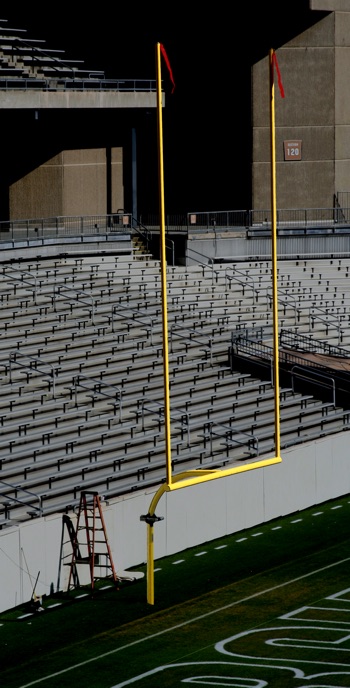
Goal post at Georgia Tech stadium. Photo by Hector Alejandro from Flickr CC by 2.0. Background darkened to emphasize the subject.
In a February 2015 interview with Sports Illustrated, Florida State University kicker Roberto Aguayo discussed the idea, first brought up by FSU head coach Jimbo Fisher (70 wins, 14 losses, 6 bowl appearances).
SI interviewer Martin Rickman asked “Jimbo mentioned his ideas about putting laser beams on top of field goal posts a while ago, and Georgia kicker Marshall Morgan brought up the notion again last season. Do you feel like electronic accuracy monitoring is something that should be implemented in kicking?”
Aguayo replied:
“Personally, I think the laser idea is a good idea. I’m still behind Jimbo. I’ll back him up on that. Games can be won or lost on a kick. I’ve seen it, a kick has gone close and one ref looks at the other. Not a lot of people know this, but my redshirt year, Dustin [Hopkins] was still kicking, and he hit a 27-yarder. He comes off the field and says, ‘Guys, I missed that.’ But the refs counted it in. They said it was good. It went right over the upright.”
“One of the kicks I missed this year went over the uprights, too. It looked like I missed it, but when they showed it on the JumboTron [TV scoreboard] the whole stadium booed. It looked good on the JumboTron. Depending on what angle you’re looking at, it’s hard. Lasers I feel like would be a good idea. It’s just about figuring out whether if it goes inside the laser it’s good, or if it touches the laser it’s no good. That would have to be discussed. Either get lasers or make the uprights a little bit longer. Kickers are getting much better and they’re hitting it a lot higher.”
From Sports Illustrated
US: Anti-laser laser for drone defense
To help defend drones against laser light, a California company has developed a defensive laser to be mounted on the drone. When it detects a laser attack, it first analyzes the incoming beam’s power, wavelength, pulse frequency and source. It then uses its own laser to counter the incoming beam.
The exact method is secret. New Scientist speculates “…it may involve fooling the control system into thinking it is hitting its target despite the laser actually pointing a few metres to the side. A direct hit would have produced a big burst of reflected light, so a pulse sent back by an anti-laser laser could make it look like the original laser was on target.”
The company is Adsys Controls of Irvine, California; the anti-laser laser system is called Helios. According to the company, “Helios is a low SWaP [Space, Weight and Power], completely passive Counter Directed Energy Weapon system capable of nullifying the enemy’s DEW [Directed Energy Weapon]. Consisting of a small UAV-mounted sensor package, Helios provides full analysis of the incoming DEW beam including localization and intensity. With this information it passively jams the enemy, protecting the vehicle and the payload.”
From Popular Science and New Scientist
US: Study examines 4 laser-caused eye injuries in children, at one medical practice
For details, see this LaserPointerSafety.com article in the non-aviation incident section of our news coverage. We are cross-referencing the article in this section as well, for persons who are looking for articles about scientific studies of laser eye injuries.
US: Pilot group forms to combat laser strikes
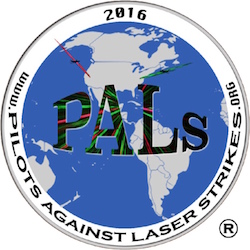
On the education side, volunteers will visit schools and airports to provide information about why people should not aim lasers at aircraft.
On the legislative side, the group wants to create a National Laser Registration List for Class 4 lasers (those over 500 milliwatts of power), with federal law mandating registration.
PALS was founded in March 2016 by pilot Craig Pieper, who was illuminated by green laser light in December 2015 while on approach to Newark Liberty International Airport. The organization’s website is at pilotsagainstlaserstrikes.org.
From Aero Crew News August 2016, pp. 26-27 and Metropolitan Airport News, August 2016, p. 10.
US: Army looking for battlefield goggles which include laser eye protection
The US Army Contracting Center, Aberdeen Proving Ground, Natick Contracting Division (NCD) on behalf of the US Army Natick Soldier Research, Development and Engineering Center (NSRDEC) intends to issue a solicitation under Authority of FAR Part 15 for Research and Development (R&D) efforts to deliver prototype systems capable of meeting Next Generation Eye Protection (NGEP) requirements. Eyewear must be capable of exceeding military ballistic fragmentation protection requirements for eye protection as currently outlined in MIL-PRF-32432, meet optical quality requirements, provide configuration(s) with laser eye protection, accommodate varying light conditions, and be compatible with the Universal Prescription Lens Carrier (UPLC) to accommodate Marines requiring vision correction. Since follow-on production is envisioned, the ability to produce protective eyewear in production quantities is also a key consideration.
The Government is anticipating awarding 1 or more firm fixed price (FFP) contracts with a period of performance of 12 months for the required services. The Government reserves the right to award one or no contracts as a result of the solicitation.
From the pre-solicitation notice at FedBizOpps.gov. The Solicitation Number is W911QY-16-R-0043.
US: Air Force buys 11,805 laser eye protection glasses for $30.1 million
“Air Force aircrew members require an ALEP system for day and night applications that balance requirements for laser eye protection, mission/aircraft compatibility, and flight safety. The ALEP Block 2 system provides aircrew members with enhanced protection against hazard and threat laser devices in combat and training situations while minimizing visual acuity degradation. The ALEP Block 2 system also provides sufficient protection to prevent permanent eye damage and temporary effects (glare, flash blindness, etc.) from laser weapons/devices. The Block 2 system is compatible with current aircrew flight equipment, cockpit/cabin displays, exterior aircraft lights, and airfield lights, night vision devices, helmet mounted displays, and exterior scenery.”
The supplier is Teledyne Scientific & Imaging. The contract amount is $30.1 million, meaning the cost amortized over each spectacle is $2,550. The sole source contract stated “Teledyne is the only firm capable of providing the supplies without the USAF experiencing substantial duplication of cost that could not be expected to be recovered through competition and unacceptable delays in fulfilling its requirements.”
From GovTribe and airforce-technology.com. The federal solicitation number for this contract is FA8606-15-C-6370.
US: FAA bill mandates quarterly reporting of laser incidents and prosecutions; increases civil penalties
- the number of laser pointer incidents reported to FAA
- the number of civil and criminal enforcement actions
- the resolution of any incidents that did not result in a civil or criminal action
- any actions taken to help deter laser pointer incidents
In addition, the maximum civil penalty that FAA can impose was raised to $25,000. It was formerly $11,000.
U.S. Government Printing Office. The full text of the laser pointer provisions of the Act is below (click the Read More… link).
Click to read more...
US: Cleveland bans lasers from area around convention; guns are allowed
The prohibition lasts from July 18 through July 22. The list of items was first published by the city of Cleveland as part of regulations issued May 25 2016.
In the list, some items have specific descriptions, such as a restriction on “Lumber larger than 2” in width and 1⁄4” thick, including supports for signs” or “Umbrellas with metal tips.” For lasers, the list simply bans “Lasers;” there is no additional description such as allowing lasers under a certain size or power output.
The general public can possess a banned item if it is used in a workplace or at a home within the restricted zone, and if the item is used within the business or home.
The public is allowed to have guns in the event zone due to an Ohio state law allowing open carry by licensed gun owners. The event zone covers most of downtown Cleveland.
A much smaller security zone inside the convention arena, under the jurisdiction of the Secret Service, has banned guns.
From Wired and Q13 Fox. The city of Cleveland regulations are here. Click the “Read More…” link for a map of the event zone and the complete list of 72 banned items.
Click to read more...
US: Hobbyist builds 200-watt portable laser from scrap parts
Anthony started by harvesting lasers used in DLP video projectors, such as the Casio “LampFree” series:
He purchased four broken projectors, each with an array of blue laser diodes totaling 50 watts, to get a grand total of 200 watts of laser output. He then used knife-edge optical components to help superimpose all the laser beams.
When energized, the beam is immense and powerful:
The highest (most hazardous) laser classification is Class 4, which starts at 500 milliwatts (0.5 watts). Such lasers can cause instant eye injury, skin burns and can burn materials. Anthony’s 200 watt laser is 400 times more powerful than the 0.5 watt limit where Class 4 begins.
In the video, Anthony says “this feels like I’m holding a bolt of lightning in my hands. This is definitely my new favorite toy.”
Adding a magnifying glass to the end focuses the beam onto a spot that can almost instantly burn a block of wood:
When operating the laser, Anthony wears a welder’s mask with laser goggles fitted. This prevents potential retinal burns caused by looking at the concentrated laser light. Below he is shown with the laser and mask.
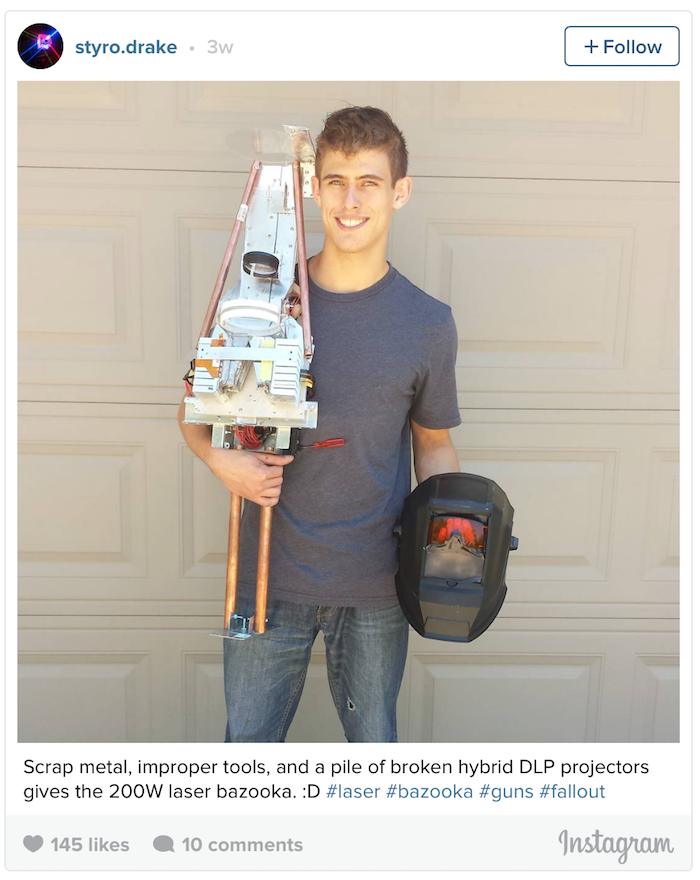
At the end of the video, he says “I'm glad to have finally finished this beast because that means I can start working on some of my other projects, and in the coming months I have a lot of crazy stuff planned including impulse lasers that peak in the megawatts as well as explosively pumped lasers, so I'm looking forward to that….Until the next time, stay safe and happy lasing!”
Drake Anthony is a 23-year old senior at Southern Illinois University, who has been accepted into the University of Rochester PhD program. In a Feb. 2016 newspaper profile entitled “SIU student turns passion for lasers into potential career”, the author notes that “What really excites Anthony is the science behind the beam.” She quotes him as saying “From a theory perspective, it’s beautiful. It uses physics, it uses quantum physics, chemistry, good things of math, engineering. It’s just this conglomeration of all the best things that humans have come up with.”
From the YouTube video “My Homebuilt 200W LASER BAZOOKA!!!!!”, posted June 28 2016
US: Statistics for second half of 2015 show unusual rise and sudden decline
The chart below, showing FAA laser illumination reports for the past nine years, demonstrates how the number of reports increased and even more dramatically decreased (yellow area):
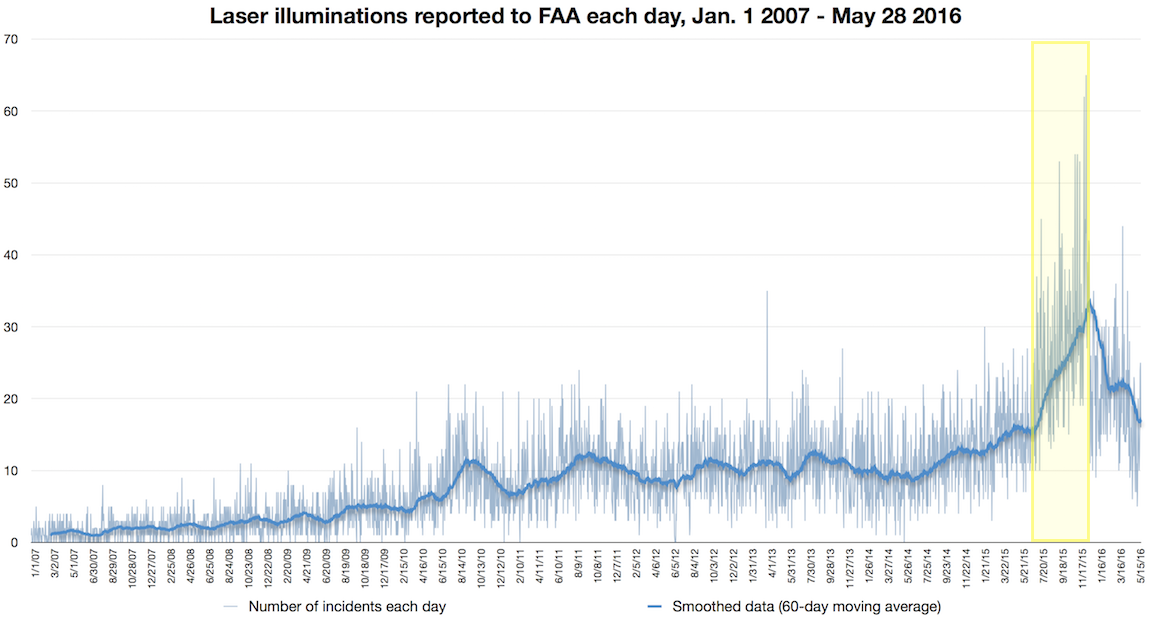
Click for larger image
A closer look at the past two years shows this more clearly:
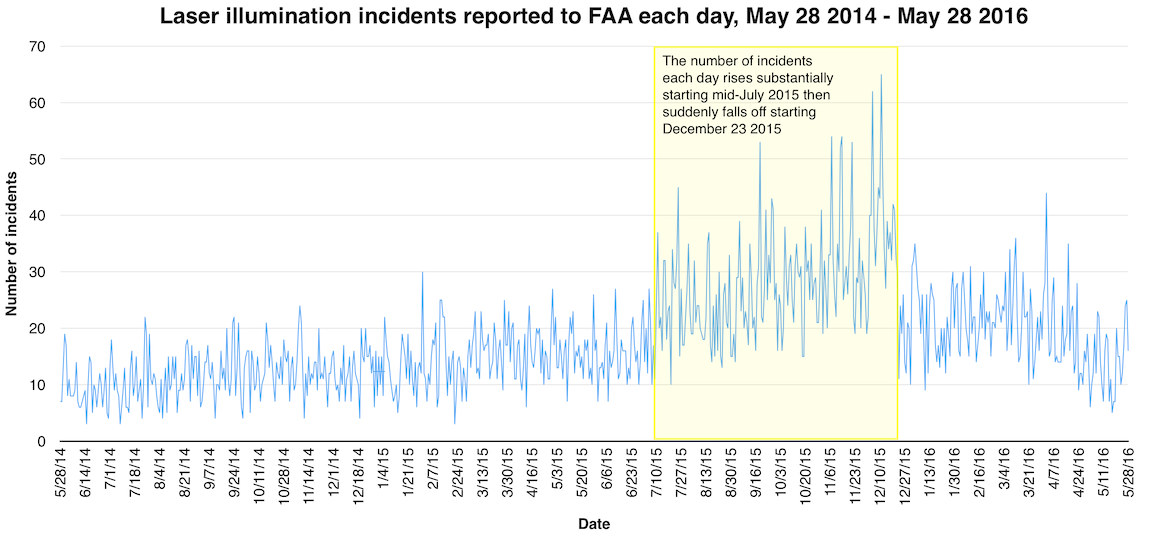
Click for larger image
A possible cause of the increase is that on July 16 there was widespread nationwide publicity about 11 flights that were illuminated on July 15 in and around New Jersey.
However, this event is not a full explanation. While the publicity may have triggered a “copycat” effect, incidents had been increasing at least two weeks prior to July 16.
LaserPointerSafety.com is not aware of any other external events such as new laser pointer products, changes in laws, etc. that could also account for this increase. And, we have no explanation for the dramatic fall-off starting December 23. We have reached out to FAA to find out if there were any changes in pilot reporting requirements or in data gathering procedures.
Knowing reasons for the increase — and especially for the sudden decrease — could provide clues in the effort to reduce laser pointer incidents in the U.S.
US: Coast Guard seeks FDA waiver; wants to use laser illuminators on helicopters
Currently, the U.S. Department of Defense is permitted to self-certify their laser equipment and usage. The DoD’s Army, Air Force and Navy agencies do not need FDA approval of their helicopter-based laser illuminators. However, the Coast Guard is part of the Department of Homeland Security, which does not have a self-certification waiver. The Coast Guard must currently apply for FDA approval.
On April 14 2016, Rep. Duncan Hunter sent a letter to FDA, asking that the Coast Guard be permitted to self-certify their laser systems. Hunter called FDA’s policy “onerous and burdensome”.
One issue may be that the helicopter-based video system already has low-light and infrared capabilities. Although the laser illumination can further enhance the image, it may not be considered a necessity for operations.
From Seapower magazine
US: Scientist uses "laser-pointer-in-a-can" to discover dinosaur eyes, feathers
In a social media post around late March 2016, Kaye posted photos of a dinosaur’s eye that is only visible with his technique.
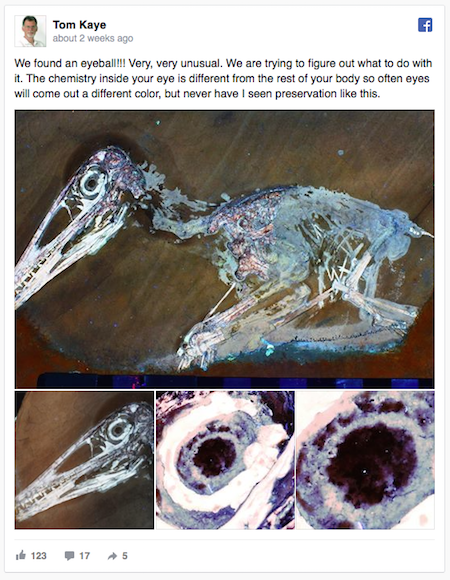
A science story notes that Kaye is “maybe the only person on Earth not named Sam Neill who can say he’s looked into the eyes of a pterosaur.”
In previous studies he used green (532 nm), blue (457 nm) and violet (407 nm) laser modules with powers from 150 to 500 milliwatts. This provides much brighter illumination of the subject. For example, a standard 20 watt ultraviolet fluorescent lamp has an irradiance (power over a given area) of 510 milliwatts per square centimeter. A 500 milliwatt (1/2 watt) laser, by comparison, provides an irradiance of around 4000 to 8000 milliwatts per square centimeter.
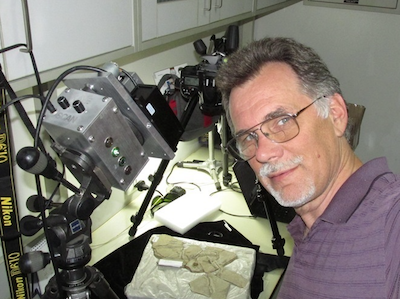
Kaye with his laser apparatus
The story “What Did Dinosaurs Look Like? Tom Kaye Finds Answers, Feathers With Lasers” appeared online at Inverse.com on April 19 2016. Inverse also featured a previous story, “Lasers Can Tell Us More About Fossils Than Before” on October 8 2015. A May 27 2015 paper by Kaye and associates, written for the online journal PLOS ONE, “Laser-Stimulated Fluorescence in Paleontology”, is here.
US: UPDATED - 2016 laser incidents up 33% over same period in 2015
From January 1 through May 28 2016, pilots filed 2,925 reports of laser illuminations with the U.S. Federal Aviation Administration. This is a 33% increase over the 2,194 reports filed during the same period in 2015.
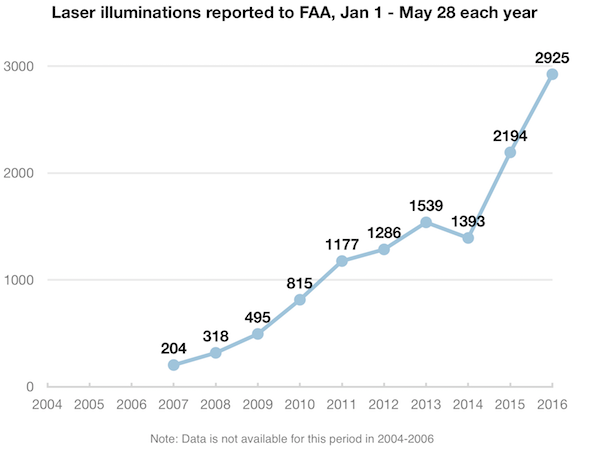
LaserPointerSafety.com estimates there will be over 8,500 laser incidents reported for 2016. This is based on comparing the number of illuminations Jan 1 - May 28 2016, with the average of the same period in the past four years.
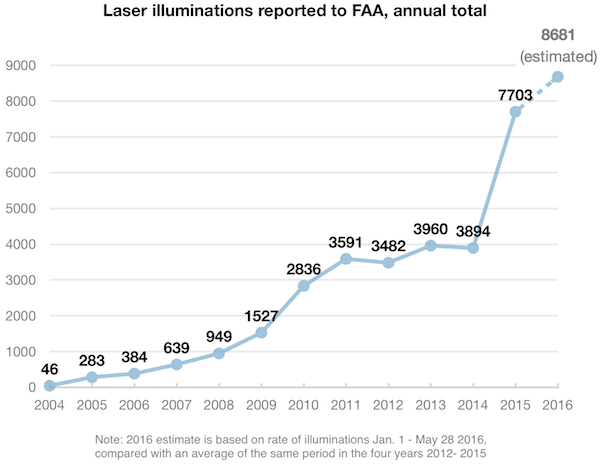
Canada: 663 laser/aircraft incidents in 2015 based on newspaper analysis of CADORS data
Here is the CADORS data:
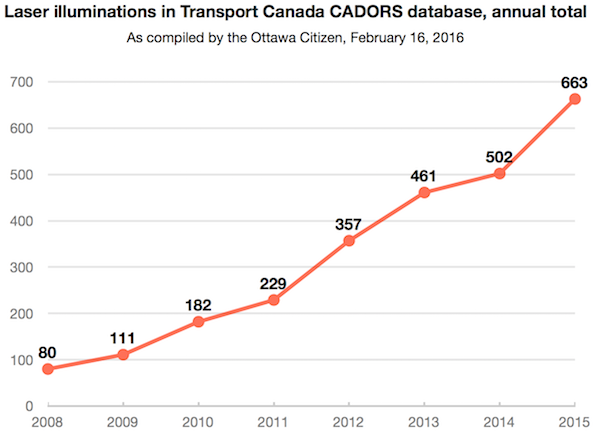
Compare this with the number of illuminations in the United States over the same period:
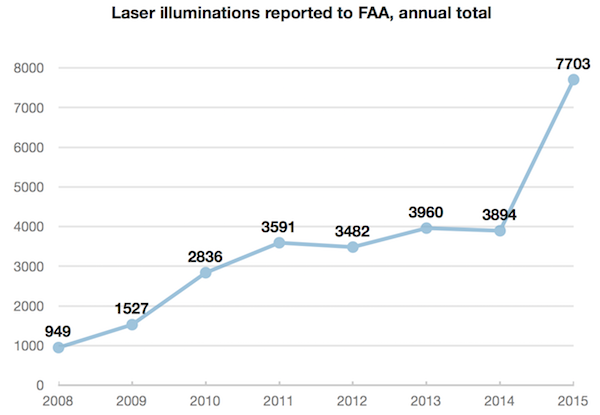
Canada’s data roughly tracks the U.S. data. Here are the two charts above, superimposed, with the CADORS numbers multiplied 11.7 times. The slope of the lines are similar for all but 2013/2014, and the endpoints are remarkably close.
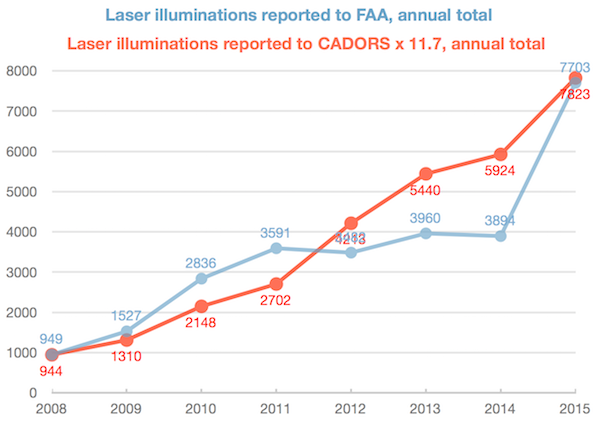
From an analysis by Andrew Duffy in the Ottawa Citizen. Note that a few days earlier, CBC News stated that there were 590 laser/aircraft incidents in 2015. There is no indication as to reasons for the discrepancy.
US: Prosecutor says laser sentences are "getting lighter" since Gardenhire appeal
The April 30 2015 decision by three judges of the Ninth Circuit found that prosecutors had not presented evidence of “reckless endangerment” of aircraft. The judges sent the case back to the U.S. district court in Los Angeles for a new sentencing hearing under a new judge. Under the original sentencing guidelines, Gardenhire had been recommended for 27 to 33 months in prison taking into account the reckless endangerment charge, or 4 to 10 months in prison without the charge.
From Ars Technica
US: Sen. Schumer gets new FDA leader to consider banning high-power green laser pointers
As of February 4, Califf’s nomination still awaited Senate approval.
Sen. Schumer, a Democrat from New York State, issued a statement saying “We’re only one month into 2016 and already there has been a green laser strike targeting aircrafts in the New York metropolitan area. We need to do something, and that is why I am pushing the FDA Commissioner nominee to act ahead of his confirmation. Green laser pointers have been a repeated danger to pilots across the country and I will continue to urge the FDA to use its authority and finally ban green, long-range, high-powered laser pointers once and for all.”
According to Newsday, there would be an exemption for professional uses. No additional details on the exemption criteria were available.
From Newsday (Note: accessing the article may require payment or answering survey questions)
US: UPDATED - Laser incidents nearly double in 2015 to 7,703
he number of FAA-reported laser incidents nearly doubled in 2015, to 7,703. This is a significant increase over the 2010-2014 period, which had hovered around 3,500-4,000 incidents per year.
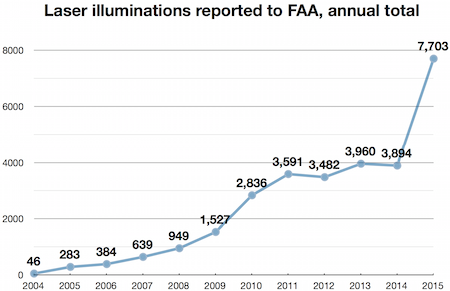
Here is the same data, presented to show the number of incidents per day:
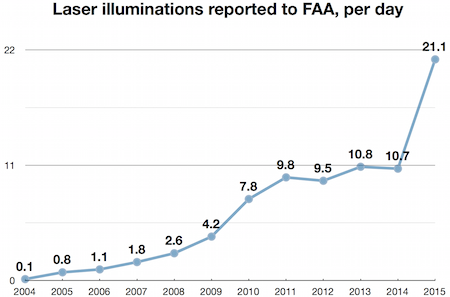
Below is a closeup of the 2014-2015 data. The thin light blue line represents the number of incidents on each day. Note the wide variability, from as few as no reports in a day (May 27 2014) to as many as 65 on December 11 2015.The thick blue line is a 30-day moving average, to smooth out the data.
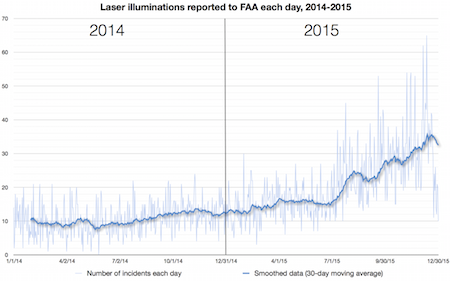
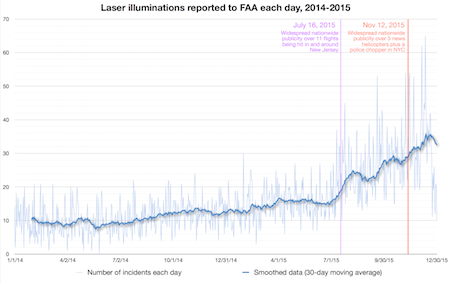
Both charts show identical data. On the second chart, two dates have been highlighted. Around July 1 2015, the number of incidents per day (light blue line) starts to increase. The only significant change that LaserPointerSafety.com can find around that time, is that on July 16 (purple line) there was widespread nationwide publicity about 11 flights that were illuminated on July 15 in and around New Jersey.
However, this event is not a full explanation. While the publicity may have triggered a “copycat” effect, it is apparent from both the thin and thick lines that incidents had been increasing at least two weeks prior to July 16.
Another date with widespread nationwide publicity is marked, November 12 2015 (red line). Three news helicopters and a police helicopter were illuminated in New York City the night before. Again, while there is some increase in incidents after that date, there also was a consistent increase from July through November.
Based on this analysis, “Copycat” laser use does not seem to be a significant factor in the near-doubling of 2015 laser incidents.
US: UPDATED - FDA reminds consumers of laser pointer hazards
This is an update to a similar warning issued December 16 2010. It contains more specific guidance about how to tell whether a handheld pointer may be over the U.S. limit of 5 mW for a laser sold as a “pointer” or for pointing purposes.
Also, the 2015 version includes details about how to report potential laser injuries to FDA’s MedWatch medical device reporting system, and what information to include in the MedWatch report.
The full text of the FDA Safety Communication is below; click the “Read More…” link.
From U.S. FDA: December 22 2015 safety communication, and December 16 2010 safety notification
UPDATED February 19 2015 — The FDA also produced a video, entitled “Laser Pointer Safety”. The 3 1/2 minute presentation shows some of the hazards of laser pointers. It also gives recommendations on how to select and safely use laser pointers. From the FDA’s YouTube channel.Click to read more...
US: Study of U.S. incidents, 2010-2014 gives insights into laser-aircraft safety
An AirSafe summary noted that from 2010 through 2014, there were only eight days with no laser encounters reported in the U.S. The graph below shows the distribution of incidents, with most days having between 7-12 laser strikes:
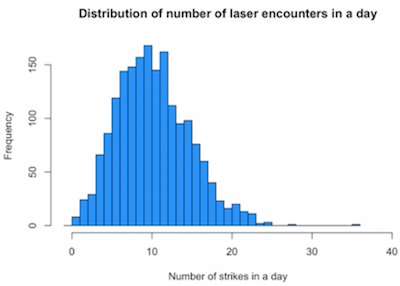
Analysis by day of the week, and by month of the year, showed Friday and Saturday evenings as having a greater likelihood of illuminations. July through November saw higher-than-normal numbers of incidents.
The AirSafe study also looked at six selected metropolitan areas. It compared the number of flights to the number of incidents. Phoenix, Los Angeles and San Francisco had higher-than-normal numbers of incidents; Chicago and New York were about average, and Atlanta was below average.
From AirSafe.com: summary page, and detailed analysis as a webpage, PDF and RPubs versions. Links are given to the raw FAA data, the processed version used by AirSafe, and statistical R code. Thanks to Dr. Todd Curtis who did the study and brought this to our attention.
US: UPDATED - "Star Shower" home laser projector raises aviation concerns
Between November 18 and December 6 2015, there have been at least three incidents, involving six aircraft, where pilots were illuminated with light from “Star Shower” laser projectors. In all cases, the illumination appeared to be inadvertent. The devices were being used for holiday decorating, and stray beams went into airspace. (E.g., a person was not knowingly aiming the Star Shower at an aircraft, or the flight path of an aircraft.)
The Star Shower emits “thousands” of laser beams from two sources, one green and one red. A homeowner can simply aim the Star Shower at her house or foliage, and instantly cover it with green, or green plus red, laser dots.
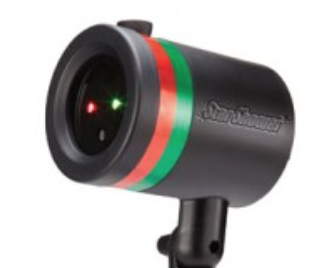
The projector head. It screws into a stake that is placed in the ground for outdoor use.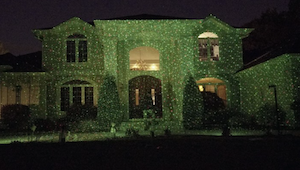
A home densely covered with laser “stars” from multiple Star Shower projectors. Both photos from the Star Shower website.
According to a comprehensive story in Inquisitr, Star Shower is so popular that it is sold out in many locations. TravelPulse calls it a “laser cannon.”
The Federal Aviation Administration on December 8 2015 tweeted “Decorating for the holidays? A stray laser could blind a pilot.” They then provided a link to general information about laser/aviation safety. An FAA spokesperson told CBS Philly, ““I don’t think anybody who buys these devices even think they have enough power to hit an aircraft in the sky…. If the box is aimed a little high, some of the lasers will not hit the roof of the house, they’ll keep going into space.”
While there is no warning on the outer packaging, the Star Shower instruction sheet says: “NOTICE: Lasers should not be projected at or within the flight path of an aircraft within 10 nautical miles [11.5 miles] of an airport. If your intended surface is within 10 nautical miles of an airport, lower the angle of the Star Shower so that no lasers point into the sky.”
In a December 9 2015 statement to NBC Los Angeles, the manufacturer added: “Star Shower Laser Lights operate by taking a single laser beam and diffracting it into thousands of individual laser beams. Each beam emitted by Star Shower is much lower in power than a typical laser pointer. Each individual laser beam is 10 times less than the maximum permissible exposure (MPE) allowed by the FAA normal flight zone (NFZ) criteria.”
In an urban or suburban environment, it is likely that most homes are within 10 NM of some type of airport. It may not be a major metropolitan airport; it could be a small general aviation facility. In a December 3 2015 incident, a Boeing 737 at 13,000 feet and 22 miles east of Dallas-Fort Worth Airport, reported seeing lights from what was believed to be a “laser holiday light display.”
From the FAA, Inquisitr, NBC Los Angeles
Analysis and commentary by LaserPointerSafety.com
ADVICE FOR OUTDOOR USE
After purchasing and testing a Star Shower, here is our summary advice for consumers. Details then follow.
The Star Shower is essentially eye-safe, and does not cause direct interference (glare) with pilots’ vision after about 411 feet. However, a single beamlet can be a distraction to pilots at least 3/4 of a mile away, and possibly further away due to the large number of laser dots aimed into the sky causing a flashing effect.
For this reason, a Star Shower needs to be aimed so that beams don’t go into airspace. You do not want an officer knocking on your door because a pilot saw and reported your home laser projector. While it is unlikely you would be arrested for an unknowing aircraft illumination, federal penalties for laser pointer misuse range up to five years in prison and up to a $250,000 fine.
Putting the projector closer to a house will keep more of the beams on the structure. Similarly, don’t aim it up into a tree unless the tree is very dense, such as an evergreen.
It should also be noted that there are reports such as this and this of Star Showers being stolen from yards. If you put your projector on a roof or up in a tree, aiming downwards, this both helps aviation (no beams going up into the air) and makes it harder to steal the projector. Finally, if you are in a heavy air traffic area, you might want to consider restricting it to indoor use only.
IS A STAR SHOWER LEGAL?
Under U.S. federal law, the Star Shower is legal to own and operate. As a Class IIIa (3R) laser, there are no federal restrictions on its use. The federal law prohibiting laser pointer misuse may not apply, for two reasons. 1) It prohibits knowingly aiming at an aircraft or its flight path, and 2) the law applies to “laser pointers…designed to be used by the operator as a pointer or highlighter….” This definition would not seem to apply to a device that is not a pointer, and is not used “…to indicate, mark, or identify a specific position, place, item, or object.”
A few states or localities may have restrictions on lasers that would affect Star Shower. Since it is not a laser pointer, and is not used for pointing, restrictions that cover laser pointers may not apply (depending on the exact definition). Some selected state and local laws are here.
Common sense says that a person should not stare into the beams, and that they should not be aimed to harass others. Similarly, the beams should not be aimed down a road or up into the sky, where they could interfere with drivers or pilots.
PURCHASING AND PACKAGING
In early December 2015, we purchased a Star Shower for $40 from a CVS drugstore. The box lists a sales website at BulbHead.com, and the distributor as Telebrands. It also says “Made in China.”
Both the box and the device have the proper FDA-mandated laser safety labeling. The device is FDA Class IIIa, meaning less than 5 milliwatts output. There are two apertures, one for 532 nm green laser beams and one for 650 nm red beams. A diffraction grating in front of each laser breaks the single beam into dozens or “thousands” of less-powerful beamlets. In a foggy or smoky environment, it is possible to see the beamlets in the air, but they are too weak to be seen in clear air.
Although the Star Shower has been popular for the Christmas 2015 season, the packaging does not emphasize this. Instead it says the Star Shower is “great for” indoor, landscaping, holiday, winter and summer uses. The advantages are: “No ladders, no hanging, no dead bulbs, no mess — just plug it in.”
TESTING
We took it to laser expert Greg Makhov of Lighting Systems Design Inc. for testing. Keep in mind that he tested just this one sample unit; we assume it is representative of the other Star Showers that have been sold.
Makhov used two different types of power meters, both which could measure in the microwatt and milliwatt region. He found that the maximum power of a single beam was 0.4 milliwatts. The chart below shows details.
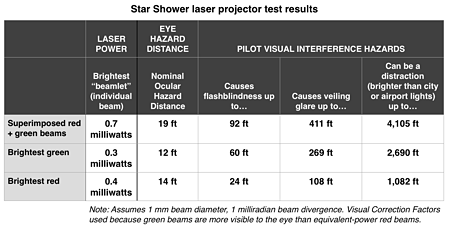
ESSENTIALLY NO EYE INJURY HAZARD
The brightest single beam, at 0.4 mW, is below the 1.0 mW Class II limit. Class II laser pointers are generally considered to be safe for accidental exposure. Eye injury from a Star Shower would be almost impossible unless a person at close range deliberately overcame his aversion to bright light and stared for many seconds into one of the beamlets, keeping it at the same spot in his visual field.
While the chart shows the Nominal Ocular Hazard Distance to be as far as 19 feet, keep in mind this is a “nominal” hazard. This does NOT mean that beams will cause injury at this distance. There is a kind of safety factor built in to the NOHD. A quick approximation is that at about 1/3 the NOHD (about 6 feet in this case), there is a 50-50 chance of a laser kept steady on the eye causing the smallest medically detectable lesion on the retina, under laboratory conditions.
GLARE UP TO 411 FEET, DISTRACTION TO 3/4 MILE
The chart also shows the visual interference hazard distances. For example, a pilot could experience veiling glare (she can’t see past the light) up to 411 feet away from the Star Shower projector. The light does not interfere with vision, but is a mental distraction, up to 4,105 feet away — a little over three quarters of a mile.
The above eye and visual interference calculations are for a single beamlet, for two reasons. First, at aviation distances, only one beamlet would enter the eye at a time. They are not so close together that two separate beamlets of the same color would be within one pupil diameter. The second reason is that even a person is so close to the Star Shower that two separate beamlets enter his pupil, each one will be focused onto a different area of the retina. This means that the beams don’t overlap — they are heating different areas. This is why we are primarily concerned — both for eye safety and for aviation interference — with the hazard of a single beamlet.
Now, when a helicopter flies through the dozens or “thousands” of laser beams, this can be more distracting than a single beam. It is no wonder that a pilot might report the laser display, and have it re-aimed or shut down.
Although an FAA spokesperson said a Star Shower was reported by a pilot who was at 15,000 feet, at this distance any single beamlet would be far below the FAA’s distraction limit. This means any beamlet would be no brighter than surrounding city or airport lights. It could be that the large number of beamlets caused flashes as the aircraft flew through them, and that this flashing was itself a distraction. Either way, no competent pilot at 15,000 feet should have any visual interference from a Star Shower. The only problem could be mental distraction, if the pilot paid more attention to the light than to flying the aircraft.
DISASSEMBLY AND HACKING (UPDATED DECEMBER 2016)
In early December 2016, Julius R. wrote to us wondering about the safety implications of opening the Star Shower and removing the star-creating holographic diffraction grating.
Our Star Shower, purchased in December 2015, has four security screws hidden behind rubber caps. The screws are at the bottom of a 2-1/4” deep shaft that is 5/16” in diameter. The screw head shape is a triangle with a raised dot in the center: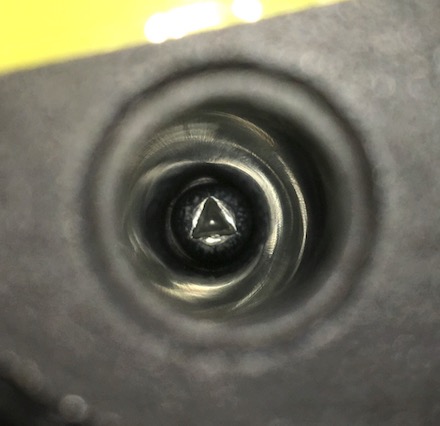
It would require a long screwdriver with a matching tip to reach and undo the screw. A brief search of Google Images to try to find such a screwdriver did not turn up any instances.
Certainly someone might be able to find such a tip, or to grind a shaft to fit. And breaking the Star Shower’s plastic housing could also give access to the inside. So if someone really wanted to get at the interior lasers, it would be possible.
We estimate that each of the lasers on the inside would be in the 10 to 50 milliwatt range. This power can cause an eye injury, although the injury would be relatively minor (assuming an unintentional exposure; deliberate staring into any laser beam should never be done). It is at the low end of Class 3B lasers.
There are similar lasers, and much more powerful ones, readily available online. They would be cost the same or even less, and would be much easier to use. So a laser hobbyist or hacker is unlikely to use a Star Shower as a source for red and green single-beam lasers.
In short, disassembly and misuse of the interior lasers is not a significant safety concern.
FOR FURTHER INFORMATION
Anyone with further questions can contact us; click the link below in the footer at the bottom of the page.
UK: Police get advice from U.S. FBI on stopping U.K. laser incidents
While both the U.S. and the U.K. have laws with penalties up to five years in jail, in the States jail sentences have been imposed while fines are the norm in Britain. The U.S. also has a centralized national reporting system, which the British officials seek to emulate.
Mark Callaghan, an NPT inspector for Sussex Police, told the Express about a case in April 2014 where a laser beam was aimed at an Airbus A319 from a Travelodge near Gatwick Airport. The pilots reported that “The green laser was extremely aggressive and we suffered three or four two-second attacks directly into the cockpit causing blotchy vision, squinting, broken concentration, sore eyes.” The perpetrators were not caught.
Callaghan noted “We can find out who was in the rooms but we have no power to conduct any searches and even if there were lasers there what evidence is there to say they did it? We would like some preventative legislation. The US have got it nailed on how they deal with this.”
From the Express
US: Slightly more than average number of laser incidents grabs media attention
Except for the involvement of multiple helicopters in New York City, the twenty November 11 overnight events were actually close to the current 2015 average of the 18.3 reported incidents per night.
It is normal for day-to-day incident numbers to fluctuate. For example, a day later on November 12, there were six incidents according to Slate.
Another example of the variability of daily incidents is shown by the day-to-day numbers for 2014. During the year there was an overall average of 10.7 incidents per day. The graph shows that daily numbers (light line) varied from 0 reported laser incidents to 24. (The dark line shows a 30-day moving average, to help smooth out the data. Day-to-day figures for 2015 are not yet available.)
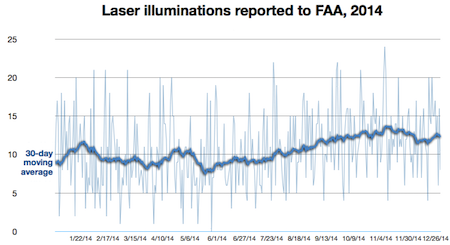
The U.S. Federal Aviation Administration made a Facebook post describing the November 11 incidents:
More than 20 aircraft were struck by lasers from the ground last night while flying over cities across the United States. Three laser strikes were reported in the New York City/Newark, N.J early in the evening, followed by three incidents in Texas, where jets were struck while preparing to land at Dallas Love Field. By late evening, pilots reported laser incidents in:
New York/Newark; Dallas; Jamestown, NY; Oakland, CA; Covington, KY; Danville, KY; Palm Springs, CA; Salt Lake City; Los Angeles; Albuquerque; Detroit; Ontario, CA; St. Petersburg, FL; Springfield, IL; San Juan, PR; Sacramento
None of the pilots reported injuries. Nevertheless, shining a laser at an aircraft is a federal crime that the U.S. vigorously pursues. Lasers distract pilots from their safety duties and can lead to temporary blindness during critical phases of flight, such as takeoff and landing. In some cases in the past, pilots have reported eye injuries that required medical treatment.
As of Oct. 16, the total number of laser strikes around the U.S. this year was 5,352.
Media stories that referenced the incidents included the following headlines and leads:
With new flurry overnight, laser strikes on aircraft hit record pace, USA Today
“Laser strikes on planes are growing even as the federal government enacts tougher penalties for people caught shining the devices. Overnight Thursday federal authorities fielded reports of more than 20 laser strikes on aircraft, adding to an already record-breaking number of strikes this year.”
Overnight outbreak of lasers pointed at aircraft, CBS Evening News
“The FAA says 20 aircraft were targeted by people with bright laser pointers Wednesday night in cities across the nation. Kris Van Cleave reports on the surge in these types of incidents.”
FAA: Lasers beams hit more than 20 aircraft overnight, Washington Post
“Federal authorities have launched an investigation after numerous aircraft were hit by laser beams Wednesday night. More than 20 aircraft were struck while in flight over at least 16 U.S. cities, according to a statement from the Federal Aviation Administration. Authorities said three strikes were reported to the FAA in the New York City area, followed by three in Texas that hit jets that were preparing to land.”
Lasers hit 20 aircraft flying in U.S. overnight - FAA, Reuters
“Dangerous beams from handheld lasers struck 20 aircraft flying over the United States and its territories overnight, among the nearly 5,400 laser hits in the nation so far this year, the Federal Aviation Administration said on Thursday. No injuries were reported in the incidents, which took place from New York City to Sacramento, and resulted in at least one arrest. Authorities said the incidents did not appear to be linked to each other.”
6 aircraft hit by lasers in New York, Dallas on Wednesday, Fox News
“Three news helicopters in New York and three planes near Dallas were hit by laser beams on Wednesday, according to the Federal Aviation Administration. Pilots for choppers flying for CBS New York, WNBC and WABC each described seeing a laser in their cockpit while flying over a scene in Park Slope, Brooklyn, CBS reported.”
High Number Of Laser Strikes In One Night Has Pilots Uneasy, CBS Sacramento
“The Federal Aviation Administration is looking into a series of laser strikes on aircraft across the country, including a possible strike at Sacramento International Airport. The exact details of that reported laser strike have not been made available yet, but for pilots these little beams of light are a huge concern. It was a busy night for law enforcement and air traffic control across the nation, with more than 20 pilots reporting laser pointers aimed at their cockpits.”
US: 96 FAA enforcement actions in two years
During this timespan according to agency records, there were 7,149 reported incidents. This means that the FAA investigated 2.1% of the incidents, and took enforcement action in 1.3% of the incidents.
There were no specific details about how many enforcement actions resulted in a conviction and/or penalty such as a fine or jail time. The agency did say in general that “Federal, state and local prosecutors have sentenced laser violators to jail time, community service, probation and additional financial penalties for court costs and restitution.”
The press release distinguished between accidental and deliberate use of lasers: “The FAA’s guidance for agency investigators and attorneys stresses that laser violations should not be addressed through warning notices or counseling. The agency seeks moderately high civil penalties for inadvertent violations, but maximum penalties for deliberate violations.
From the FAA’s Fact Sheet - Laser Strikes
US: College football team given 120 lasers to "make a point"
Herman was later quoted as saying “When you can see all these lasers everywhere, it just kind of represents everything that goes on in the lives of 18- to 22-year olds. We needed everybody to shut all that out and bring all that into one common focus.”
The tactic may have helped; the Houston Cougars went on to beat the Vanderbilt Commodores 34-0 on October 31 2015.
From the Houston Chronicle and Examiner.com
US: Doctors warn laser eye injuries may be misdiagnosed as genetic disorders
Such misdiagnosis has medical and financial consequences from the additional diagnostic workups and DNA sequencing used to detect hereditary genetic disorders such as rod monochromatism, Stargardt disease and occult macular dystrophy.
In addition, the paper describes five cases of where children using laser pointers experienced blurry vision and had eye injuries. “In some cases, the vision was as poor as 20/80, which is bad enough to fail a driving test,” said researcher Dr. Stephen Tsang, who is affiliated with Columbia University and NewYork-Presbyterian Hospital.
Dr. Tsang and his colleagues noted damage patterns similar to tree branches on the children’s retinas:

They suggest that eye-care professionals should ask patients with such patterns if they have been using lasers. Because children may be hesitant to talk in front of their parents, the researchers also suggest talking to a child alone.
A Columbia University press release noted “Since the publication about the five patients, the researchers have seen several more children with laser-induced eye injuries, suggesting that these cases are not isolated phenomena.”
From Columbia University Medical Center Newsroom, Nov. 5 2015. The Ophthalmic Genetics article “Laser induced photic injury phenocopies macular dystrophy” is not yet online as of this date, but can be found at the journal’s website.
US: From 6,500 to 7,100 laser incidents estimated for 2015
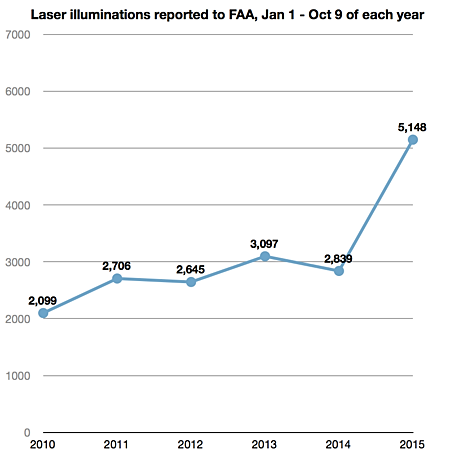
Based on trends in the years 2010 through 2014, this means that at the end of 2015 there could be between roughly 6,500 and 7,100 reported incidents. (The range is because in some years, the yearly total was between 1.28 and 1.37 times the Jan. 1 - Oct. 9 total.) We estimate that 2015 is likely to have roughly 6,850 incidents. This would be 176% of the 2014 total of 3,894 incidents.
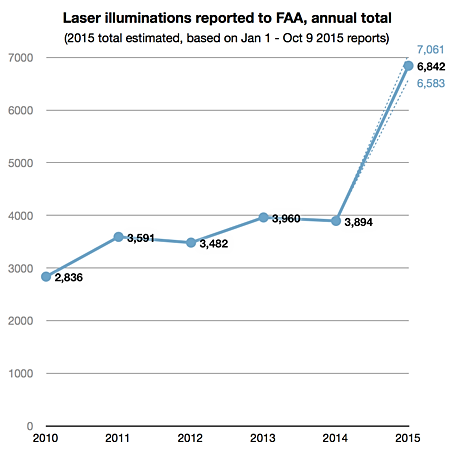
Stated on a daily basis, the number of reported incidents is expected to rise from 10.7 per day in 2014 to between 18.0 and 19.3 per day in 2015.
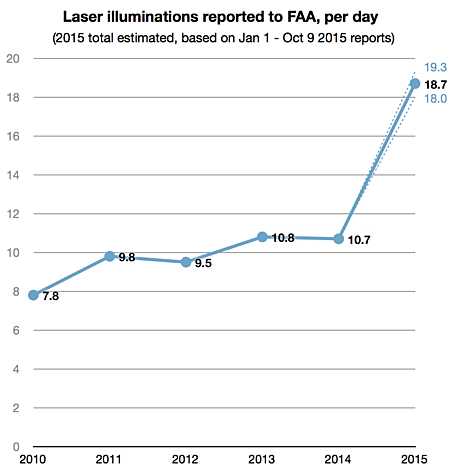
2015 information provided by FAA on November 5 2015. Statistical analysis done by LaserPointerSafety.com based on prior year FAA records.
US: Aviation reporter says FAA anti-laser efforts aren't working; wants more social media
Negroni began the segment by noting that laser incidents are “truly a menace and it’s not to be taken lightly.” She said offenders “don’t watch the news, they don’t read the paper” and thus “they need to be reached out on their level. And that level is like a Facebook level or a Twitter level, where people are actually going to learn.”
She concluded that “it’s just time for the establishment to get on board, before something really terrible happens.”
Negroni has written aviation articles for publications such as the New York Times and Smithsonian Air & Space, is an on-air expert for ABC, CNN and NBC, and has a book on mysterious aviation accidents coming out in 2016. She previously wrote an article for RGN critical of FAA laser publicity efforts entitled “No let-up in laser attacks on airplanes” published December 13 2013, and a blogpost on the same topic on August 28 2014.
From the Runway Girl Network podcast episode 27, “Crash Investigations and Laser Incriminations”, uploaded August 29 2015. A transcript of the laser-relevant parts of the podcast is below.
Click to read more...
US: Lasers create light fence to protect birds in Hawaii
According to the Kaua’i Island Utility Cooperative, “The lasers are similar to common laser pointers and use a narrowly focused green beam of light. Because the beams are parallel to the ground and because the installation is not in designated air space, the lasers do not pose a hazard to aircraft or passersby.”
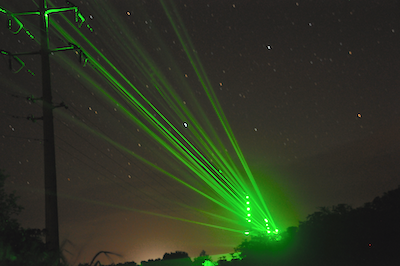
Lasers create a “light fence” to illuminate transmission poles and power lines in ‘Ele‘ele, Kaua‘i in August 2014. Kaua‘i Island Utility Cooperative is again experimenting with lasers and other devices to reduce collisions between endangered seabirds and utility equipment during the season when the seabird colonies are most active. Photo credit: Shelley Paik, Kaua‘i Island Utility Cooperative
From a press release by the Kaua’i Island Utility Cooperative (reprinted below).
US: Sullenberger says drones, laser pointers are dangerous; need certain prosecution
DICKERSON: So, the final question, Sully, I want to ask you about these reports about near misses from drones and commercial airlines. How dangerous is that?
SULLENBERGER: Well, because they are easy to get and they're relatively inexpensive, these devices are becoming ubiquitous. And that is true not just of drones, but of laser pointer attacks. And so it allows people to do stupid, reckless, dangerous things with abandon. I am heartened that the aviation and the legal authorities have raised the penalties for doing these things. Unfortunately, the essential element that is still missing is the certainty of prosecution, because it has been difficult to catch them in the act. This must stop.
DICKERSON: Very quickly, though, what could possibly happen, though, with one of these drones? I mean, how bad could it get?
SULLENBERGER: Well, we have seen what a six-pound or an eight-pound bird can do to bring down an airplane. Imagine what a device containing hard parts like batteries and motors can do that might weigh 25 or possibly up to 55 pounds to bring down an airplane -- it is not a matter of if it will happen. It is a matter of when it will happen.
Sullenberger successfully ditched U.S. Airways Flight 1549 in New York’s Hudson River in January 2009, after multiple bird strikes caused both engines to fail just after takeoff from LaGuardia Airport. Since 2011 he has been a CBS news aviation and safety expert commentator.
From the Face the Nation transcript and the Wikipedia page for Sullenberger
US: New pilot protective "anti-laser" glasses announced
The glasses block three laser wavelengths, in the red, green and blue regions. According to Dr. Perricone, “The real challenge was how do you block out red, blue, and green without changing the color discrimination. It’s critical a pilot sees color. He has to look at his instruments, he has to look at runway lights and a lot of other signals.”
A July 30 2015 news story said the glasses “have been manufactured and are ready for purchase, costing $400 a pair.”
Dr. Perricone was quoted as saying that if pilots are required to wear glasses like these, “then this problem will go away. No one is going to throw rocks at a window that won’t break.”
From WTNH.com
US: Coast Guard says NJ laws have not reduced laser strikes
Delaware Online reported from the event that “[l]asers have been a point of contention in Ocean City [MD] for years, with the council deciding to ban the sale of them last summer, and make it illegal to possess a laser pointer in public. Similar laws have gone into effect in New Jersey, but the Coast Guard hasn’t seen a decrease in laser strikes, [Lt. Shawn] Glavan said.”
According to The Dispatch, “Coast Guard Station Atlantic City, where [Glavan’s] MH-65 Dolphin [helicopter] is based, handles around two or three incidents a week involving individuals shining lasers on the aircraft. Coast Guard Air Station Atlantic City’s response area covers a large swath of the mid-Atlantic including Ocean City and as far south as Chincoteague.”
From DelawareOnline, CBS Baltimore and The Dispatch
US: FAA says no known permanent eye injuries from laser pointers as of March 2015
Commentary from LaserPointerSafety.com: There have been many pilot claims of eye injuries caused by laser pointers aimed at their aircraft. FAA has investigated some of the most serious claims. In 2011, a person knowledgeable about these studies told LaserPointerSafety (on background): “I haven't seen anything that convinces me that any of the FAA incidents are true injury. I haven't seen any convincing evidence of delayed laser lesion effects. I do know that headaches and eye pain and photophobia and light sensitivity have been reported and associated with laser illumination. I have seen nothing convincing me that there is real cellular, tissue injury.”
There have been a few cases (<10?) of temporary eye injury, where the eye healed. This is similar to how skin can heal after a sunburn. In all of these cases, the pilots returned to flying.
There have also been cases of reported laser injury to the cornea. This is the transparent surface of the eye. Visible laser light passes right through and is not absorbed. The cause of these reported “laser” injuries is the pilot rubbing his or her eyes too vigorously, causing painful scratches in the sensitive cornea. Any damage from a visible laser beam would be on the light-absorbing retina.
Note that FAA limited its statement to commercial pilots. There may be military pilots in conflict zones who have been injured by laser weapons. If so, this information would be classified. Due to the seeming lack of urgency with FAA and U.S. military, any such injuries would not seem to be a threat to commercial pilots in the U.S.
Here are lists of all LaserPointerSafety.com news items tagged with the keyword “eye effect or injury”: aviation injury incidents, non-aviation injury incidents, other eye injury stories.
LaserPointerSafety welcomes any documented cases of pilot eye injuries. Contact us with the links etc., and also contact FAA so they can be aware of the cases.
US: FAA-reported laser incidents up significantly in 1st half of 2015
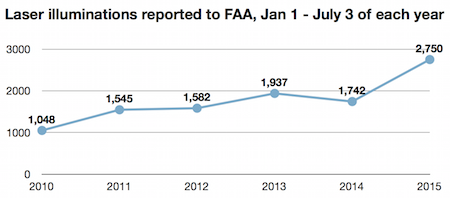
Based on past years’ trends, this means that at the end of 2015, there could be between about 5,600 and 7,400 incidents. (The range is because in some years, the second half of the year had 2.04 to 2.71 times the number of incidents in the first half.) We estimate 2015 is most likely to have about 6,300 incidents. This would be a 62% increase over the 2014 total of 3,894 incidents. 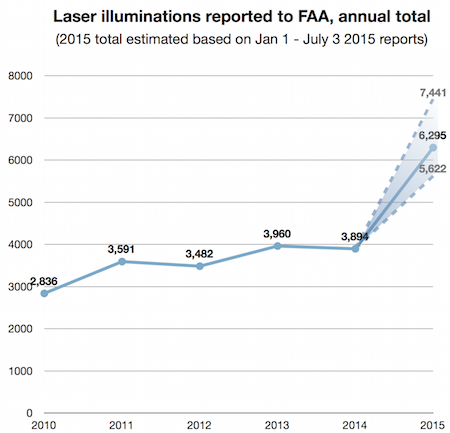
Stated on a daily basis, the number of incidents is expected to rise from 10.7 per day in 2014 to somewhere between about 15 and 20 incidents per day in 2015: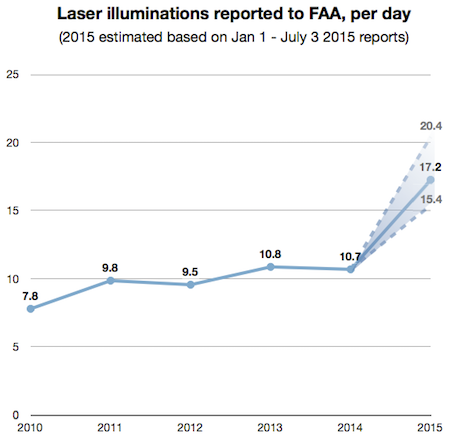
2015 information provided by FAA on July 10 2015. Statistical analysis done by LaserPointerSafety.com based on prior year FAA records.
US: Hobbyist builds 40 watt laser "shotgun"
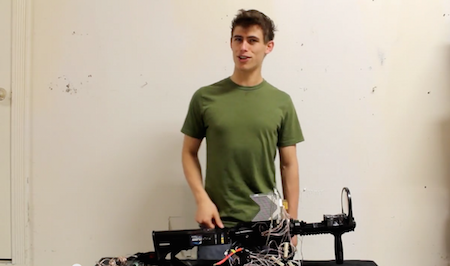
The hobbyist, with the username “styropyro,” wrote on YouTube: “Just finished building my 40W(!!!) laser shotgun!!! The output of this laser is complete insanity, and is made up of 8 parallel 5W laser beams totaling to 40W. The parallel beams are manipulated with lenses, sort of like how a choke modifies the spread of a shotgun blast. The massive diode array is powered by a huge lithium polymer battery pack (capable up dumping 250A) and the laser array is regulated by a whopping 24 LM317 drivers. This is definitely the craziest thing I have ever built, but I hope to beat this invention with something even crazier before too long.”
In the video narration, he said “I just built something so crazy that I’m almost afraid to use it” and “There is no, no good reason for anybody to own something this powerful. But because it wasn’t illegal for me to build, I decided to build it anyway.” The video then goes on to show the beam popping balloons, and burning paper, a ping-pong ball, and other materials.
Styropyro had previously posted other videos with titles such as “Homemade Lightsaber!?! MASSIVE 3W Handheld Laser Torching Stuff!!”, “My Homemade 6W Laser Sword!!!” and “Homemade Death Ray Laser DRONE BOT!!! Remote Controlled!!!”
From Gizmodo. Thanks to Patrick Daniel Murphy for bringing this to our attention via Reddit.
US: Study shows windscreen coatings can reduce laser intensity
More information at the LaserPointerSafety.com page on the 2015 Nanocomposite coating study
US: Wall Street Journal examines link between males, laser offenders
It began by noting that in 89 of the 93 reported arrests last year for laser strikes against aircraft, the offender was male. The article quoted a New York laser safety officer, John Zelenka, as saying he has never seen a female playing with lasers.
A developmental psychologist was quoted as saying that lasers appeal to a masculine perspective. Patrick Murphy (editor of LaserPointerSafety.com) told the Journal “For a lot of guys it’s like, ‘The bigger the laser, the more visible, the more of a man I am.’”
Author Sophia Hollander then noted that the prices of a 20 mW laser dropped from $239 in 2004 to $8 in 2015.
She examined the similarity of “Star Wars” lightsabers and lasers, quoting experts on the appeal to males of a weapon that can “throw your influence.”
The online article was illustrated with photos from a lightsaber combat class held by the group New York Jedi. Actual lasers were not used in the class due to the potential hazards.
From the Wall Street Journal (article is behind a paywall)
US: Burning Man desert event bans handheld lasers after 2014 accident
In addition, volunteer Kelli Halston Hoversten suffered two permanent eye injuries during the climactic “Man Burn” in 2014. Her left eye was permanently blinded by a handheld laser, and her right eye was partially blinded by a vehicle-mounted laser. (The injuries significantly affected her. Hoversten “lost her job as an arborist because they can’t insure her now” and she no longer rock climbs or ice climbs recreationally due to the loss of depth perception. She is allowed to drive but “just barely” since her central vision is blocked.)
According to an article about the policy change in the Reno Gazette-Journal, Hoversten will attend the 2015 Burning Man event, in part because of the new laser policy.
The Burning Man ban on handheld lasers applies even to low-powered laser pointers less than 5 mW in power. In a separate blog post comment, Burning Man press official Will Chase wrote: “Because of the difficulty in discerning the difference between dangerous and non-dangerous handheld lasers — and because you don’t want to be wrong — it’s been decided to prohibit all handheld lasers.”
The new webpage with the laser policy also noted that the restriction on handheld lasers “is in line with nearly all major festivals and events in the United States and Europe.”
Non-handheld lasers are still allowed at Burning Man if they are on art installations, “DMV Mutant Vehicles,” or are in theme camps. Such lasers must be disclosed on the art, vehicle or camp application. An Event Safety Officer will review the applications; only safe uses will be allowed.
Click to read more...
US: NY senator wants FDA to ban green laser pointers
Schumer made the announcement at a Sunday press conference in his Manhattan office, along with four commercial airline pilots who had been illuminated by laser light. One pilot, Gabe Rubin, said he knew of a pilot who “suffered severe eye damage from a green laser pointer [and] will never fly again.”
Schumer said “Green lasers are the weapons of choice being used for evil purposes. We know terrorists are always looking for areas of weak points.”
He is focused on green pointers because they are apparently preferred by pranksters because the green light travels farther, and “because the light spectrum of green is more easily absorbed by the retina and then causes more damage”, according to the senator.
In 2012, Schumer wrote a letter to the U.S. FDA saying that laser pointers’ power should be less than the current 5 mW limit, that FDA should restrict more powerful Class 3B (5-500 mW) and Class 4 (500+ mW) lasers, and that FDA should require warning labels about aiming at aircraft.
From Newsday and CBS New York. The text of Sen. Schumer’s press release is below (click the “Read more…” link).
Click to read more...
US: Aiming lasers at aircraft now a felony in New York State
From WIVB and the Democrat and Chronicle
US: 3,894 FAA-reported laser illuminations in 2014; only 2.4% decline from 2013
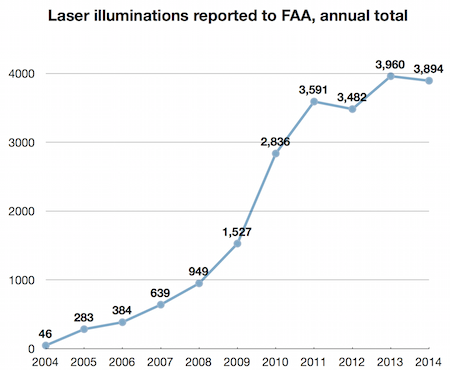
The chart below shows the number of incidents each day (light blue line) and a 30-day moving average (dark blue) to smooth out the data. In the first half of the year (Jan 1 - Jun 30) there were 9.4 incidents per day, but these rose in the second half to 11.9 incidents per day, making the 2014 final average of 10.7 incidents per day.
It is unclear why 2014 saw roughly level incident rates up to about June but then a steady increase over the next 5 months. One significant 2014 event was the February push by the FBI to publicize and prosecute laser pointer incidents, including offering a $10,000 reward. This was followed by another FBI push in June — after which rates started to rise.
The chart below shows 2014 in context with the past seven years. While the incident rates have leveled off to about 10-11 per day since 2011, all the publicity and prosecutions over the past few years have not brought the rate downward.
Finally, this chart superimposes each year’s laser illumination incidents, from 2009 through 2014. This gives an idea of the “shape” of each year. The heavy black line is 2014 data.
From public FAA Excel spreadsheet “Reported Laser Incidents for 2010-2014” at this page. For 2013 and previous years’ data, see the page FAA laser/aircraft incidents: 2004-2013 historical data.
US: Ophthalmalogist calls consumer lasers "weapons", asks Congress for law
The October 7 2014 story was a follow-up to an incident at an NFL football game on October 5, when Buffalo Bills players complained of lasers being aimed at them during a game with the Detroit Lions. The NFL and police were said to be investigating.
USA Today’s Martin Rogers wrote that Dr. Robert Josephberg “has lobbied members of Congress for more than a year to discuss criminalizing intentionally dangerous use of laser pointers, to no avail. Josephberg told the newspaper that intentional shining of a laser at someone should be a felony: “There has been a significant increase in medical journals of reports of blindness caused by the lasers. The use seems to be increasing – and so does the power and availability of the pointers. Congress needs to take note.”
In a February 28 2011 story in the New York Times, Josephberg recounted how he saw a high-school student who had a blind spot from a 50 milliwatt green laser pointer. At first he did not believe that lasers were available that could cause such an injury. But he bought a 100 milliwatt laser for $28 online; Times writer Christine Negroni said “he could hardly believe how easy it was.”
A June 2011 article in the magazine of Westchester (NY) Medical Center, where Josephberg works, quoted the doctor as saying “I contacted new Republican Congresswoman Nan Hayworth of the 19th Congressional District, who is an ophthalmologist herself. We are working with her, trying to write a bill that addresses this problem.”
From USA Today, the New York Times and ”Health & Life” magazine from Westchester Medical Center
US: Apple repair guide lists laser damage to camera as a service item
This information comes from a 2014 “Visual/Mechanical Inspection” guide provided by Apple to authorized repair centers. An image from the document was provided by a worker to Consumer Reports’ Consumerist blog. In the upper right is the laser damage information:
This item is relatively new. Laser damage is not mentioned in the 2012 version of the iPhone Visual/Mechanical Inspection Guide.
From the Consumerist. For more on laser damage to consumer cameras and camcorders, see our Lasers and camera damage page.
US: Laser show company has variance revoked for unauthorized audience scanning
On July 24 2014, the Food and Drug Administration sent a letter to David Fleenor of Epic FX, Inc. of Phoenix, Arizona. It stated that videos posted on the epicfx.com website “documents audience scanning with Class IIIb and/or Class IV lasers. Although much of the audience scanning was done with fanned beams, your projector is not designed nor reported for safe audience scanning. Your variance prohibits audience scanning. Any laser beams projected into the audience directly or indirectly is considered audience scanning. This is in violation of Condition 5 of your variance.” [The page has since been removed, and returns a 404 error.]
Click to read more...
Arizona: Pilots will seek to upgrade laser pointing penalty to felony
The first draft of the April 2014 law called for a Class Five felony to “knowingly or intentionally” aim a laser towards an aircraft. But there was concern among legislators that juveniles could end up with a felony record. The bill passed once the penalty was reduced to a Class One misdemeanor.
In a September 22 2014 story, reporter Emilie Eaton recounted Arizona’s experience. FAA-reported incidents in the state rose from 138 in 2010, to 202 in 2013. One police pilot interviewed said that he had been hit by lasers over 100 times, during a 22 year career. The pilot, Chris Potter, said he had permanent damage from a laser strike: “It literally felt like I got punched in my eye and there was a piece of debris, like a piece of glass in my eye.”
Another pilot quoted, Pima County Sheriff’s Department deputy Chris Janes, said he has has between 12 and 24 laser strikes from 2007 to 2014: “I have not received any eye damage. But I’ve had headaches afterward. I’ve had eye discomfort for several days afterward.”
From Cronkite News, via the Tucson Sentinel
US: Wall Street Journal article describes laser pointer hazards to aircraft
The article begins by saying that “People keep aiming powerful laser pointers at aircraft ... despite jail sentences for offenders and rewards for people who turn them in.”
It quotes unnamed law enforcement experts and prosecutors as saying that most strikes are “not done out of maliciousness, but irresponsibility.” The FAA told the WSJ author that no accidents or aborted takeoffs or landings have been attributed to laser incidents.
Jones notes that the FBI’s recent publicity and prosecution campaign “appear[s] to have led to some success, with the number of laser strikes in recent months dropping to about nine a day from about 11 in 2013, according to an FBI spokeswoman. She said this crime was the first for which the FBI has offered a reward that didn’t involve a fugitive or missing person.”
The article describes a few cases, then in the penultimate paragraph, states “Still, thousands of laser strikes, particularly involving commercial planes, go unpunished. Since 2005, only 162 people have been arrested for strikes, and 86 convicted, according to the FBI.”
From the Wall Street Journal. The article may be behind a paywall, requiring a subscription to access the full text. Aviation reporter Christine Negroni was moved by the WSJ article to respond a day later with a blog post entitled “Aviation’s Effort Combating Laser Attacks Hashtag #Ineffective #Insane”.”
US: UPDATED - Arizona law adds penalties for aiming at aircraft
In addition, if the pilot is unable to safely operate the aircraft, or if anyone onboard has a serious physical injury, the act becomes an assault. Apparently, under Arizona law, an “assault” would add to the seriousness of a Class 1 misdemeanor (possibly increasing the jail term and/or fine), but would not put it into another category such as a felony. (For more details, see this discussion and this page.)
House Bill 2164 was introduced January 13 2014. It amended existing Arizona statute Section 12-1213, which prohibited aiming a laser pointer at a peace officer. HB 2164 added a prohibition on aiming at an occupied aircraft.
Click to read more...
US: Paper's editorial on Ocean City ban concludes it is a "a reasonable approach"
The July 27 2014 opinion piece, titled “Public safety versus profit?”, begins with the May 19 2014 emergency legislation passed by Ocean City.
The article notes that the May ban was resisted by merchants who would lose revenue, and by those “unhappy because of the perceived curtailment of personal freedom.” But this is outweighed, in the paper’s opinion, by the risk to eyes: “There are recorded instances of police, random passers-by and municipal employees in Ocean City suffering injury as a result of someone pointing a laser at them.” In addition, the story says, pilots are at risk from the bright light.
The opinion piece then notes that in the two months since the ban, “resort police went from taking 1,000 calls in a three-year period complaining about laser pointer abuse to no incidents this year. This is despite the fact that laser pointers are easily obtained elsewhere, suggesting that without the temptation to make an impulse purchase on the Boardwalk, people will find other ways to amuse themselves.”
The editorial suggests that merchants may be “legally or ethically culpable” for injuries or aircraft crashes caused by lasers that they sold: “Is our economy so focused on profits, we’ve lost track of taking the common welfare into consideration when conducting business?”
The paper’s conclusion is that “ given the persistent and long-term problems caused by laser pointers in Ocean City and elsewhere, particularly other beach resort areas, banning the sale of the devices on the Boardwalk and regulating how they are used — for the purpose of curtailing abuse — seems a reasonable approach.”
From an editorial available online at DelmarvaNow.com
US: Ocean City MD incidents decline after ban on sale, possession
After 975 incidents of misuse reported to police over three years, there were no incidents or arrests during the May 19 to July 13 period. The ban was put into effect both because of increasing harassment of persons in the beach town, and because of concerns over pilot safety when the bright beam was directed towards aircraft. Harassment incidents noted in the article included times when tram operators and city bus drivers were targeted.
Ocean City’s attorney noted that “We didn’t want to ban their legitimate use,” saying that laser pointers used in presentation are legal.
In 2010, Ocean City police estimated that 23 retailers had sold more than 30,000 laser pointers at $30-$50. A laser pointer wholesaler said in May that the ban “would hurt the merchants... Say a merchant sells 1,500 in a season, that’s $30,000. That’s a lot of cash to them.”
The news story discussed an injury to 33-year-old Rich Drake in the summer of 2009, who supported the ban. A red beam went into his eye. “Afterward, he noticed his vision took on a pinkish tone, and altered the colors he was seeing. The effects lasted more than a year. Drake already wears glasses and has a condition that makes his eyes extra-sensitive to light. The experience left him shaken.”
From DelmarvaNow.com. The story includes quotes from LaserPointerSafety.com editor Patrick Murphy.
Note that other U.S. beach towns have enacted bans or restrictions on laser pointers, including Ocean City NJ in 2011, Virginia Beach and towns in the Myrtle Beach, SC area. Past LaserPointerSafety.com news stories can be found with the tags Ocean City, Virginia Beach and Myrtle Beach. Text of the 2014 Ocean City MD ordinance is here.
US: New York State law criminalizes aiming lasers at aircraft or flight path
The New York state bill seems to be more restrictive than U.S. federal law, which simply prohibits aiming a laser at an aircraft or its flight path. The New York law appears to require both intent to disrupt or interfere with the aircraft, and the laser’s power to be above a certain level. (Specifically, it is only a violation if “the calculated or measured beam irradiance on the aircraft, or in the immediate vicinity of the aircraft, exceeds limits set by the FAA for the FAA-specified laser flight zone [Normal, Sensitive, Critical or Laser-Free] where the aircraft was located.”)
In addition, if a pilot in the illuminated aircraft does not file a laser incident report with the FAA, there is no New York state violation.
Click to read more...
US: Puerto Rico law makes pointing lasers at aircraft or law enforcement illegal
In addition, if the laser pointing results in serious bodily harm to a human being (defined as “an injury that requires hospitalization, long-term treatment, or causes permanent or mutilating injuries”), the violation becomes a felony.
As of August 14 2014, it is not known if the act has been signed by the Governor, and thus whether it has become an official law. [Usually, such laws are signed by the executive. However, in October 2013, New Jersey Governor Chris Christie vetoed a law, passed by the legislature, that would have banned the sale of laser pointers over 1 milliwatt.]
From a PDF of S.B. 799. The text of the law is here. Thanks to George Johnson for bringing this to our attention.
US: FAA-reported laser incidents decline 12.8% compared to 2013
During the 219 days from January 1 to August 7, 2014, there were 2,085 laser incidents reported to the Federal Aviation Administration, according to the FBI data. This is a 12.8% reduction compared with 2,390 incidents during the same 219-day period in 2013, and is an 8% increase compared with 1,925 incidents Jan. 1- Aug. 7, 2012.
One reason for the decline may be the FBI’s campaign to prosecute offenders, and to inform the public via press releases and public service announcements that it is illegal to aim a laser at aircraft.
Based on the Jan-Aug 2014 data, the number of illuminations in 2014 is expected to fall below 3,500.
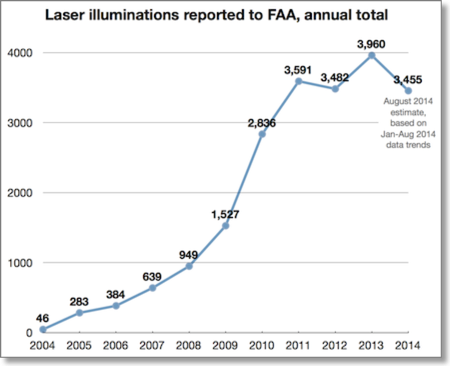
From information provided to LaserPointerSafety.com, and analysis of FAA data for previous years. For 2013 and past years’ data, see the page FAA laser/aircraft incidents: 2004-2013 historical data
US: No laser beam headlights for U.S. cars -- not without rule changes
Toyota has filed a petition with the National Highway Traffic Safety Administration, seeking to allow the advanced headlights.
A story in Ars Technica goes into more detail about how the laser headlights work, and how companies are advocating for “sensible policy solutions where the tech and car worlds intersect.”
From a June 5 2014 Ars Technica article by Jonathan M. Gitlin
Note from LaserPointerSafety.com: Although automobile headlights are not laser pointers, they do use diodes similar or identical to those in high-powered blue lasers such as the multi-watt Wicked Lasers S3 Arctic handheld. In headlights, laser diodes are used to energize a phosphor coating so that incoherent bright white light is emitted. The small diodes allow the headlight assembly to be lower-profile, giving more flexibility in body design and aerodynamics. They also allow beam shaping to avoiding dazzling other drivers, and aiming the beam in the direction of travel while turning. Our coverage of laser headlights (other stories) can be found here.
US: FBI expands laser education & reward campaign nationwide for 3 months
The original FBI education and reward program ran from February 11 to April 11 2014 in 12 U.S. cities that had high rates of laser/aircraft incidents. The FBI said the program led to a 19 percent decrease in lasing reports.
The new, nationwide program was announced June 3 2014. The $10,000 reward offer is scheduled to last for 90 days; until September 1.
The FBI said they are working on the educational campaign with the Federal Aviation Administration, the Air Line Pilots Association, International, and state, local and international law enforcement. They are outreaching to schools, teaching teens to not aim at aircraft.
Click to read more...
US: 129 laser/aircraft incidents in Florida thus far in 2014
The NBC Miami “Team 6 Investigators” did a report on laser incidents, how pilots are endangered, and the enforcement effort to find perpetrators. The report aired May 16 2014.
From NBCMiami.com
US: 134 laser arrests, 80 convictions, out of 17,725 incidents, 2005-2013
Farivar noted that there were 80 convictions among the 134 arrests. One reason for the conviction rate of 60%: some who were arrested were minors who were never formally charged.
The extensively researched 4,200-word article, dated May 21 2014, was based around the 14-year sentence handed down in March 2014 to Sergio Rodriguez, for his August 2012 aiming of a laser at two helicopters, one medical and one police. Farivar used the case to illustrate many laser/aviation issues, especially about how prosecution is being used to try to educate and deter future incidents.
Farivar interviewed Karen Escobar, who has brought more cases against laser perpetrators than any other federal prosecutor. Her territory includes Sacramento, Fresno, and Bakersfield.
In the article, Escobar was quoted as saying “At sentencing, [Rodriguez] did not accept responsibility for his actions; he blamed his 2- and 3- year-old children. I believe the evidence showed the laser was a dangerous weapon, and there was intention, supporting a guideline sentence of 168 months. I would not call it harsh. I would say it is a penalty that fits the crime, but I believe that it will have a deterrent effect, and I hope it will.”
Farivar noted that, “While 14 years might sound incredibly excessive for an incident that caused no serious or lasting physical injury, much less death, this is the emerging reality for attorneys prosecuting laser strikes. The Rodriguez sentence now serves as an example of what can happen to defendants who don't take plea deals. (The plea deals typically end up being around two years.)”
From Ars Technica
US: UPDATED - Ocean City MD passes emergency ordinance banning sales, possession of laser pointers
The action comes after a number of previous measures had failed to stop misuse of lasers.
Click to read more...
US: Louisiana bill makes pointing lasers at aircraft a crime
HB1029 was introduced March 12 2014 by Representative Terry Landry, a Democrat from New Iberia. The House passed it by a vote of 97-0 on April 14, and it was sent to the Senate. As of May 13 2014, it had passed the Committee on Judiciary C and was being sent to the Senate floor for a vote. If it passes, as expected, it will be sent to Gov. Bobby Jindal for his signature.
The bill “provides penalties of imprisonment with or without hard labor for not less than one nor more than five years, and a fine of $2,000. For second or subsequent offenses, the offender shall be imprisoned with or without hard labor for not less than two years nor more than ten years and shall be fined $4,000.”
A police officer who testified before the Judiciary C Committee told of an incident where a suspect was tracked down but officers “couldn’t charge him with anything.” The FBI -- who could bring charges -- was given the information but after two months, nothing was done.
A police helicopter pilot was asked why people aim lasers at aircraft. He said “We don’t know their intentions,” and speculated that they could be “just fooling around” or trying to interfere with police work.
From the Times-Picayune and the Louisiana State Legislature website
US: Air Force study to help protect pilots from laser injuries
TASC is working on countermeasures such as laser eye protection and the development of procedures for injury assessment. The work is being performed under the Optical Radiation Bioeffects and Safety contract with the Air Force’s 711th Human Performance Wing’s Optical Radiation Bioeffects Branch at Fort Sam Houston in San Antonio, Texas.
From the San Antonio Business Journal
US: Review of 1-watt blue laser with US-required safety features
The SKY Technologies Blue Handheld includes a keyswitch, 3-5 second emission delay, remote interlock, and a shutter to cut off the beam, as required by FDA regulations enforced by the agency’s Center for Devices and Radiological Health (CDRH). Under current (May 2014) law, the laser appears to be legal for sale and use in the U.S., assuming the manufacturer also submitted a proper Laser Product Report and has filled all other FDA/CDRH import and paperwork obligations.*
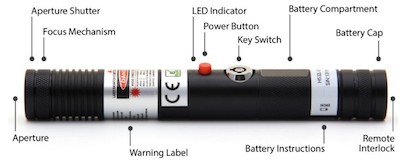
US: FDA proposes defacto ban on selling pointers, handhelds above 5 milliwatts
Although the agency did not give a reason, such bans have been imposed in other countries in response to climbing numbers of laser illuminations of aircraft as well as reports of eye injuries caused by higher-powered consumer lasers.
The proposal would not make it illegal to own or responsibly use portable, battery-powered lasers of 5 mW or more. However, manufacturers could not make or sell these into general commerce in the U.S.
The agency will accept comments for 90 days (until August 2 2014) on the new proposal. FDA will then review the comments. Based on whether it believes any objections or suggestions are valid, the agency could put the guidance into effect (thus imposing their new interpretation), could submit a revised proposal, or could withdraw its proposal.
What lasers are covered by the proposed 5 mW limit?
FDA does not have direct authority over battery powered portable lasers. For example, the words “pointer” and “handheld” laser do not appear in U.S. laser regulations 21 CFR 1040.10 and 1040.11.
Therefore, to regulate these lasers, the May 5 draft proposes an extension of the FDA’s existing authority to regulate surveying, leveling and alignment (“SLA”) lasers. In the May 5 proposal, FDA asserts that the existing definition of SLA lasers also can applied to lasers with the following design characteristics:
- Compact size (i.e. small, lightweight)
- Battery power
- Ergonomic design to permit hand-held use
- An aperture in the laser product's protective housing to transmit laser emission into open space
- Portability to permit use in open spaces or in unrestricted environments
- Features that utilize the laser’s straight line emission for surveying, leveling, or alignment
According to the FDA, these types of lasers would be affected by the new 5 mW limit:
- Laser pointers
- Levels
- Tools incorporating laser guides
- Gun sights
- Target designators
- Night vision illuminators
- Visual disruptors
What lasers are NOT covered by the proposed 5 mW limit?
The FDA's proposed 5 mW limit would NOT apply to lasers with the following design characteristics:
- Predictable, stable power input and output
- High quality power supply and/or power conditioning components
- Adjustability of power and wavelength
- Design that facilitates remote actuation
- Non-portability
- Hard wire connection to power mains
From the FDA’s Surveying, Leveling, or Alignment Laser Products - Draft Guidance for Industry and Food and Drug Administration Staff webpage, published online May 2 2014. This webpage includes the procedure for submitting comments to FDA.The FDA’s PDF version of the draft guidance document is here.
Editorial comment from LaserPointerSafety.com: We have previously published our opinion disagreeing with the FDA’s interpretation of “SLA” lasers. The existing regulations are clear on what constitutes “surveying, leveling or alignment” (SLA) lasers. While we understand the FDA’s intent, in our view, they are going about it the wrong way. They are essentially “making it up” by adding characteristics (size, battery power) which are in no way derived from the clear, existing definition of SLA lasers. As support of this position, we have not found any surveying, leveling or alignment lasers which look the same as the majority of laser pointers and handhelds. This topic is discussed in much greater detail on our page describing FDA authority over laser pointers and handheld lasers.
US: 3,960 laser incidents reported to FAA in 2013
Other news based on the statistics:
- In 2013, there were no incidents documented by FAA as causing eye injuries. Although there were incidents with eye effects such as temporary flashblindness, afterimage, blurry vision, eye irritation and/or headache, no incidents were serious enough to be tabulated as “eye injuries” by the agency. The FAA did say that in 2013, there were 35 incidents where pilots who were lased sought medical attention.
- The closer an aircraft is to the ground, the greater the likelihood of reporting a laser incident. There is a strong peak in the number of incidents at 1000-3000 feet above ground level.
- The color green was reportedly seen in the vast majority (92.8%) of incidents. Blue was a distant second with 2.4% of incidents.
- For states, California had the most incidents (734), followed by Texas (416) and Florida (326).
- For cities and regions, LaserPointerSafety has determined the Los Angeles area, including Van Nuys and Burbank, leads the nation with 147 incidents. Portland Oregon is second with 137 and Houston is third with 124. (Note that LaserPointerSafety.com tabulates regions slightly differently than the FAA or FBI, so these federal agencies may have slightly different numbers or rankings.)
- FAA tabulates each incident according to the closest airport. For 2013, Portland (Oregon) International led this category with 133 incidents. Phoenix Sky Harbor International was second with 111, and Marin International in San Juan, Puerto Rico was third with 107. This does not necessarily mean that incidents occurred at or near these airports -- just that these were the closest airports to the reported incident.
Full details are on the 2013 laser/aircraft incidents page.
US: FBI offers $10,000 reward; warns public about laser pointer misuse
This comes as part of a publicity campaign by the FBI to inform the public and especially teenagers about the dangers of lasing aircraft. The agency said teens are the primary age group responsible for laser/aircraft illuminations.
[Note: There appear to be no official records of perpetrators’ ages. However, here are lists of incidents recorded in LaserPointerSafety.com news items, based on the age of the perpetrator: 10-19, 20-29, 30-39, 40-49, 50-59, 60-69. Counting the stories in each group may give a rough indication of the age distribution of laser perpetrators.]
The two-month campaign will focus on 12 cities with large number of incidents. FBI field offices participating in the regional reward program are Albuquerque, Chicago, Cleveland, Houston, Los Angeles, New York City, Philadelphia, Phoenix, Sacramento, San Antonio, San Juan, and the Washington Field Office.
During the campaign, the FBI and the Air Line Pilots Association International will work with Clear Channel Outdoor to hang billboards and issue public service announcements in these cities, warning people that a laser prank can lead to prison.
Click to read more...
US: Famous DJ explains why he had to have a 2 watt laser pointer
Avicii answered “I just bought a really awesome laser pointer. It's two watts, so it's five hundred times stronger than those regular green laser pointers. If you were standing on top of the Empire State Building with it, you could see all the way to Philadelphia. It's dangerous. You can't really play with it. You need to use goggles or you could go blind. But I saw some YouTube videos where it set stuff on fire, and I was like yes. It cost $1,500. That's not too bad for such an amazing invention.”
From Rolling Stone
US: Professor emails all students at university to remind them of laser safety
Douglas Brandt said that pointers should be labeled as Class 2 [less than 1 milliwatt] or Class 3R [less than 5 mW]. He stated that Class 3B and 4 lasers had the potential to damage the eye and were required to be registered with the State of Illinois.
He urged students to not direct a laser pointer at a person’s eye, and not to use Class 3B or 4 lasers, or unlabeled lasers.
Brandt is the laser safety officer at the university, which has about 11,600 students.
From the Daily Eastern News
US: NIST working to get forensics labs to measure laser pointers for court cases
The effort began when NIST physicist and laser safety officer Joshua Hadler worked with the U.S. Attorney’s office on a 2013 case in Fresno, California. Hadler already had devised a relatively simple and inexpensive way to accurately measure laser pointer powers. (His widely-reported study showed that a majority of pointers exceeded the U.S. limit of 5 milliwatts.)
But power is only one factor of the potential laser hazard. The beam spread, or divergence is another key factor. This is because a wide, high-divergence beam will have its energy spread out more, making it dimmer and less hazardous at a distance than an otherwise equivalent-power laser with a narrower, low-divergence beam.
To tackle this, Hadler used a pyroelectric laser camera to measure the laser’s divergence. From the power and divergence, and knowing the approximate distance to the aircraft from the Federal Aviation Administration incident reports, Hadler was able to calculate the irradiance, or laser power over a given area.
The information helped to get a conviction in the Fresno case. Hadler noted that in the past, “...the vast majority of prosecutions were failing, due in no small part to a basic lack of knowledge about the laser devices on the part of nearly everyone in the trial process, including lawyers, judges, and jury members. What they needed was to be able to acquire and present quantitative data about a device's power and its effects at a specified range that could be used in the judicial process."
Hadler will present a paper on February 21 2014 at the American Academy of Forensic Sciences meeting in Seattle, Washington. The paper, “Output Characterization of Handheld Lasers Used in Criminal Aircraft Illumination,” will discuss the needed measurements and will present ideas for having these measurements be done outside of NIST, in law enforcement forensic labs.
From PhysOrg
US: UPDATED - Arizona bill to make aiming a laser at aircraft a felony
The Tucson Police Department had about 50 lasing incidents in 2013; the perpetrator was caught in most of the cases. But there was little prosecution.
Orr says the bill is needed because “there’s really no punishment. The county prosecutor, because it's not at a felony status, doesn't go after them. And so literally, you get a ticket and nothing happens. But you're endangering lives."
Orr is working with Tucson police pilot Chris Potter, who says he has been hit by a laser pointer about 100 times in his career. Potter says a laser pointer permanently damaged his right eye around 2011.
According to News 4 Tucson, “the FBI will launch a public awareness campaign about the issue next month.” It was not clear if this was an Arizona-area initiative or nationwide.
From News 4 Tucson
UPDATED - February 4 2014: The Arizona House Judiciary Committee voted in favor of increasing the penalty for persons who point lasers at aircraft. HB 2164 would make it a Class 5 felony, with a presumptive sentence of 18 months in prison, to knowingly or intentionally point a laser at an occupied aircraft. And the penalty would go to 30 months if the act disables the pilot or causes serious physical injury to anyone on board. The legislator who introduced the bill, Ethan Orr, is considering reducing the penalty slightly, to a Class 6 felony, when it goes to the full House. Prosecutors could reduce the charge from a felony to a misdemeanor when appropriate. Orr said this might be the case for youths so that a single mistake would not result in a felony record. From KWST.com. A related article at AZCentral.com includes comments from LaserPointerSafety.com’s Patrick Murphy on the issue.
UPDATE 2 - May 1 2014: The bill was eventually amended to make the act of aiming at an aircraft a Class 1 misdemeanor. The act became an assault if the pilot was unable to safely operate the aircraft or if anyone onboard suffered a serious physical injury. The amended version passed both legislative bodies and was sent to Governor Jan Brewer, who signed it on April 30 2014. From the Arizona State Legislature legislative history of HB2164.
UPDATE 3 - September 23 2014: The Arizona Police Association and other law enforcement groups want to increase the penalty to a felony. They hope to introduce a measure when the legislature re-convenes in January 2015.
US: Lasers being used to burn string in arcade games (to get prizes to drop)
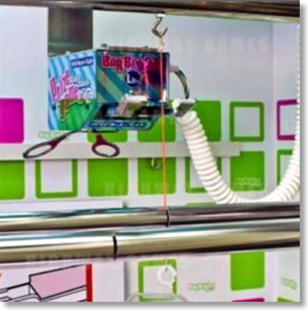
Namco America sent the notice to arcade operators of BarBerCut Lite and other hanging prize type games in May 2010, after powerful handheld laser pointers became available online at relatively low cost. Namco noted that “a criminal armed with one of these can steal a number of prizes from a merchandiser in a short period of time.”
White cords and zip ties are recommended, since they reflect most of the laser’s power. In 2009, Namco changed from black and colored fasteners, which absorb the laser’s light.
From Vending Times
US: Tucson police pilot says he has permanent retinal damage from laser exposure
The statement came as hundreds of Arizona law enforcement pilots attended a safety seminar in Tucson focusing on laser beam incidents. In 2012 in Tucson alone, the police department’s air unit had “close to 50 incidents”, according to Potter. As of November 2013, Phoenix was the top U.S. city for laser incidents.
From KVOA News
US: FBI uses sophisticated surveillance to catch Portland man who lased ~25 aircraft
The operation was initiated in August 2013, after multiple incidents of lasers being aimed at aircraft around Portland International Airport. Four law enforcement aircraft were equipped with video surveillance cameras.
On August 10, five aircraft were targeted by a ground-based green laser. One was an Alaska Airlines flight; two were from the FBI and two were from the Portland Police Bureau. At the same time, a surveillance team was on the ground. Using information from the FBI/PBB aircraft sightings, the ground officers observed suspicious behavior from a male in the back yard of a duplex apartment. He was looking up at the sky. He removed something mounted from a stand or pole, and went inside. The laser strikes ceased afterwards.
Six days later, after reviewing the video, consulting Google Earth and Google Maps, and visiting the apartment complex, an FBI Special Agent determined that Apartment 35 -- the one previously surveilled -- was the most likely source of the laser. The apartment was occupied by 39-year-old Stephen Francis Bukucs.
Surveillance cameras were then secretly installed, watching Apartment 35. They could see in daylight, low light and nighttime (using infrared).
Click to read more...
US: Underwriters Labs offers third-party testing for laser pointer sellers
These regulations, 21 CFR 1040.10 and 1040.11, require laser product manufacturers only to self-certify to the Food and Drug Administration that their products meet safety standards. Once the FDA’s Center for Devices and Radiological Health reviews and acknowledges the certification, the laser product can be marketed in the United States.
UL is providing a third-party, independent check on the manufacturer’s claims. This can be provided to retailers such as Amazon.com which in August 2013 began requiring third-party verification of lasers sold on its website. UL can also assist with preparation of a manufacturer’s FDA report.
Click to read more...
US: New Jersey governor vetos bill to ban laser pointer sales
In his veto message, Christie noted that the New Jersey bill would have gone “well beyond” the federal government’s 5 milliwatt limit for laser pointers. He said there was no criminal use of lasers between 1 and 5 mW in New Jersey. Christie indicated the bill was “arbitrary” and interfered with lawful commerce of pointers typically used in business presentations. (See full text below, after the “Read More…” link.)
The bill was first submitted in November 2010, in response to ongoing problems in Ocean City, N.J. and other beach resort towns where widespread laser pointer sales in boardwalk shops were leading to harassment incidents and aircraft illuminations. The bill, A3169/S418, passed the state Senate on August 19 2013 by a vote of 36-1. It had previously passed the General Assembly on June 24 2013 by a vote of 70-7, with one abstention.
Click to read more...
US: Time-lapse video shows astronomy lasers being used at Mauna Kea
Sean Goebel, a graduate student in astrophysics, has produced a 3-minute time-lapse video showing observatories at Mauna Kea, Hawaii, shooting lasers into the night sky. By analyzing how the beam is distorted by the atmosphere, a telescope’s mirror can be counter-distorted in order to obtain sharper images for astronomers.
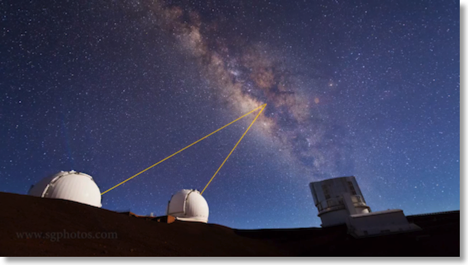
A still frame from the video. Two telescopes are simultaneously observing the same spot in the Milky Way, using lasers to help give a sharper image.
Goebel writes about the lasers:
“A typical laser pointer that you might use to point at stuff/exercise your cat is about 5 mW. That's five one-thousandths of a watt. Not a whole lot of power. And yet it's enough to blind airplane pilots. The lasers on the telescopes are in the range of 15-40 watts. The FAA calls a no-fly zone over the area when a laser is in use, and two people have to stand around outside in the freezing temperatures and watch for airplanes. Each of them has a kill switch to turn off the laser in case an airplane comes near.”
“Additionally, the telescope has to send its target list to Space Command ahead of time. Space Command then tells them not to use the laser at specific times, ostensibly to avoid blinding spy satellites. However, you could calculate the spy satellite orbits if you knew where they were at specific times, so Space Command also tells the telescope to not use the laser at random times when no satellites are overhead.”
To clarify, the FAA does not have a no-fly zone, but instead issues a “Notice to Airmen” or NOTAM about the laser operations. It is not illegal to fly over the area. Fortunately, at Mauna Kea’s location and altitude only a couple of flights per month fly at night within the laser-affected airspace over the mountain. At one telescope, planes get close enough to the beam to cause a shutoff once every year or twin.
Automated aircraft-detection systems are slowly being tested and phased in, since the cost of having humans watch the skies all night at Mauna Kea’s altitude (13,700 feet) is about $600,000 per year.
The video, “Mauna Kea Heavens”, can be seen at Sean Goebel’s website, which also has more information about adaptive optics lasers and how the video was made. Additional information on aircraft frequency and spotting techniques is courtesy Paul Stomski of the Keck Observatory. A story about Keck’s aircraft protection system appears online in Ascend magazine.
US: Toy helicopter powered by 500-watt laser beam; kept aloft for more than a day
They noted that the technique could be scaled up to create laser-powered drones that could do useful work: “commercial laser-powered flight applications are only a few years away.”
Click to read more...
US: FAA prosecutes 1.5% of all laser/aircraft incidents
This appears to describe civil cases brought by FAA based on violations of 14 CFR 91.11, which states “No person may assault, threaten, intimidate, or interfere with a crewmember in the performance of the crewmember's duties aboard an aircraft being operated.” The maximum penalty is an $11,000 fine. FAA announced on June 1 2011 its intent to charge laser perpetrators under this law, so the 129 cases referenced above would be since that time.
During the same time period, from June 2011 to September 2013, there were 8,507 reported laser/aircraft incidents in the U.S. This means that 1 out of every 70 reported incidents results in a civil prosecution. Stated another way, 1.5% of all laser/aircraft incidents result in a civil prosecution.
Click to read more...
US: Laser aimed from aircraft to ground results in dozens of calls
In a September 16 2013 article, HawaiiNewsNow said there were “dozens” of inquiries about the nighttime green light. One person emailed that the aircraft circled his area about six times at 1:00 am, with a wide green laser that appeared to be scanning downward. Another email confirmed the multiple passes with a V-shaped green laser.
The Army Corps of Engineers is conducting the work. They stated that the laser is not harmful to the eyes. The Oahu work should take about a week, and mapping the entire state should conclude in November.
From HawaiiNewsNow. Similar flyovers using visible green lasers have occurred in other U.S. cities, such as New York City in 2010 and 2012, according to a a brief Google search of such reports, for example here and the comments here.
US: Newsday editorial calls for warnings, enforcements to reduce laser attacks
The paper, ranked 13th in the country with a circulation of 393,000 weekday subscribers, said “It’s a serious offense that should be firmly punished…. Heavy fines, and in some cases, jail time, would send a powerful message that it’s a life-threatening crime.”
The editorial was the result of incidents in the Long Island area in the past month. It was titled “Enforce anti-laser laws with laser-like force.”
From Newsday. Subscriber information from USA Today.
US: $208 million contract to protect Army helicopters from laser threats
The Army/Navy Piloted Aircraft/Visual and Visible Light/Receiving, Passive Detecting (AN/AVR-2B) Laser Detecting Sets (LDS) uses four sensor units placed on the aircraft. It is smaller, lighter and uses less power than a previous generation developed for the cancelled Comanche helicopter program.
News reports did not state how much it costs to equip each helicopter with an AN/AVR-2B system.
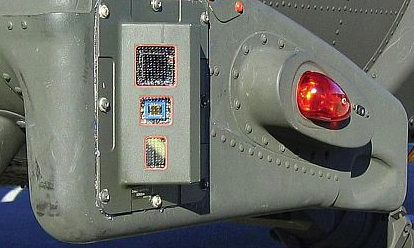
One of the four sensor packages to detect laser threats on U.S. military helicopters
From Avionics Intelligence August 31 2013 and September 3 2013
US: Army Research Laboratory works on laser protection for eyes, sensors, etc.
Laser protection team leader Andy Mott was quoted as saying “Lasers of varying pulse width and wavelength are being developed every day. We protect against the known threats, and unknown ones. We develop protection for electronic sensors of the future, as well as the sighting systems of today.”
More details are at the Military.com story
US: FDA asks Customs' help on illegal imports of laser pointers
Using Form 2877, the importer must submit information on each shipment and must affirm that the products comply (or do not comply) with FDA laser regulatory standards. But if a small package omits Form 2877 and is mislabeled (not using the word “laser”), this is an attempt to evade FDA and Customs. FDA specifically notes that such single-package Section 321-type imports do not meet the FDA’s criteria for enforcement discretion for personal importation.
Lasers that FDA is interested in include laser pointers, laser gun sights, laser levels, laser light shows, laser pointer key chains, veterinary laser products, laser illuminators and similar products. If a shipment does not meet FDA requirements, it can then be detained by the FDA and would not be allowed into the country.
From STR Trade Report. Thanks to New Aje Lasers for bringing this to our attention.
US: UPDATED - New Jersey to ban laser pointer sales above 1 mW
The bill was first submitted in November 2010, in response to ongoing problems in Ocean City, N.J. and other beach resort towns where widespread laser pointer sales in boardwalk shops were leading to harassment incidents and aircraft illuminations.
As passed, the bill states that “No person shall sell or offer to sell a laser pointer that exceeds one milliwatt in output power.” A pointer is further defined as “any device that emits laser light to project a beam that may be used for aiming, targeting or pointing out features.”
The penalty is a civil fine of up to $500 for the first offense, and up to $1000 for each subsequent offense. There are two exemptions: for laser pointers intended to be affixed to a firearm, and for a laser pointer used by or under the supervision of a N.J. licensed healthcare practitioner.
If signed in August 2013 by Gov. Christie, it would take effect December 1 2013.
From CBS New York and New Jersey 101.5. The bill’s legislative history and text is available on the New Jersey Legislature website; use the “Bill Search” feature to search the 2012-2013 legislative session for the keyword “laser”.
UPDATED - October 17 2013: The bill was vetoed on October 17 by Governor Christie. In a statement, he noted that the bill would have gone “well beyond” the federal government’s 5 milliwatt limit for laser pointers. He said there was no criminal use of lasers between 1 and 5 mW in New Jersey. Christie indicated the bill was “arbitrary” and interfered with lawful commerce of pointers typically used in business presentations. The full text of Christie’s veto message is here.
Related LaserPointerSafety.com news stories about Ocean City and New Jersey laser troubles
- August 26 2010: Ocean City officials discuss city-wide ban on laser pointers after summer incidents.
- November 22 2010: State senate bill 2430 is introduced in November 2010 to ban laser pointers above 1 milliwatt.
- June 8 2011: Man buys laser in Ocean City, points it at helicopter, and is almost immediately arrested.
- June 11 2011: Residents report harassment; voluntary sales ban is not working.
- June 24 2011: Unanimous vote on the initial measure to ban Ocean City laser pointer sales and possession.
- July 14 2011: Unanimous vote on the “second reading” to make the Ocean City ban official.
- April 16 2013: North Wildwood NJ bans sale and possession of laser pointers above 1 mW.
- August 20 2013: New Jersey state legislature passes bill to ban laser pointer sales above 1 mW; sends bill to Governor for signature.
- October 17 2013: Governor Chris Christie vetoes bill to ban laser pointer sales, saying the 1 mW power limit was “arbitrary” and there was no criminal use of lasers between 1 mW and the federal limit of 5 mW in New Jersey.
US: Latest FAA statistics show 3,188 incidents, Jan 1 to Oct 17 2013
The 2013 figure of 3,188 laser/aircraft incidents is 16.7% higher than the same period in 2012. If incidents continue at the same pace, there will be 4,063 incidents in calendar year 2013.
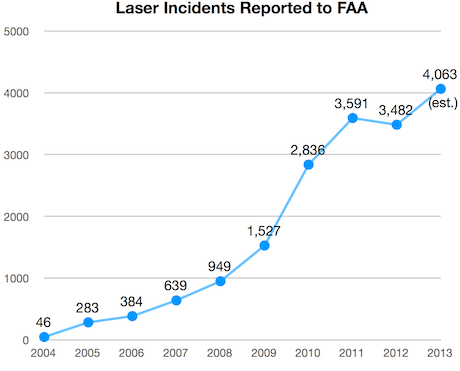
Total Incidents, 2004 to Date
There have been approximately 16,936 laser/aircraft incidents reported to FAA, from January 1 2004 through October 17 2013.For additional details on previous years, see the year-end statistics for 2012, 2011 and 2010.
Commentary from LaserPointerSafety.com
This 16.7% increase represents a setback from the 2012 totals, which were 3% lower than in 2011. Having a rise in 2013 incidents seems to indicate that the publicity and prosecutions which form the majority of current U.S. anti-laser efforts are not having the desired effect.
There has been some speculation that the 2013 figures differ from 2012 in part because FAA may have updated its incident reporting procedures. While FAA is working to include military and overseas incidents, this has not yet been done. In this respect the 2013 figures are directly comparable to earlier years.
Another possible explanation is that pilots have become more aware of the issue and are thus more likely to report a laser sighting. However, pilot information has been widely available since 2008 and has increased as this became of more concern. By now, most pilots should be alerted to the issue and FAA’s reporting requirements. There has not been a major push during 2013 in this area, so increased pilot reporting is probably not a major factor in causing 2013 reports to increase over 2012.
US: Amazon.com tightens rules for laser pointer sales
The new Amazon.com policy requires pre-approval of laser pointers and related products. The products are limited to Class 3R (5 mW) or less and must be branded; examples include Kensington, Quartet, 3M and Logitech. Products must have a testing report from Intertek, UL or SGS.
It is not known if this is a U.S.-only policy or if it extends to other non-U.S. Amazon sites.
Click to read more...
US: FAA updates laser reporting method in AC 70-2A
The changes include:
- Air Traffic Control can now regard a laser illumination of aircraft incident as an “in-flight emergency”, due to the potential debilitating injuries which could compromise safety and interfere with aircrew duties.
- New web-based methods by which pilots can report incidents
- Additional information in the Resources and the Related Documents sections
The key part of the document is the reporting procedure: “On arrival at destination, all aircrews that have been affected by an unauthorized laser illumination are requested to complete the Laser Beam Exposure Questionnaire. The questionnaire is located on the FAA’s Laser Safety Initiative Web site at http://www.faa.gov/about/initiatives/lasers/ and can be electronically submitted. The questionnaire may also be printed and faxed to the WOCC at (202) 267-5289, ATTN: DEN, or emailed to laserreports@faa.gov.”
From FAA Advisory Circular 70-2A
US: FAA study compares fixed-wing airplane laser incidents with helicopter incidents
The study found that helicopters were 3.4 times as likely to be illuminated at altitudes below 2,000 feet than fixed-wing aircraft. Helicopter aircrews were twice as likely to report adverse effects such as distraction, vision interference, operational problems, and pain.
The study also broke down adverse effects by the type of flight, such as commercial, law enforcement, medical and military.
One conclusion of the study is that the “results may also justify the expense of equipping rotary-wing aircraft (particularly law enforcement aircraft) with laser detection and tracking devices to improve the possibility of apprehending perpetrators of these offenses.”
A detailed summary is at LaserPointerSafety.com’s 2013 FAA helicopter study webpage. The full 6-page report is available online from the FAA.
US: Think Geek introduces toy shark with frickin' laser on its head
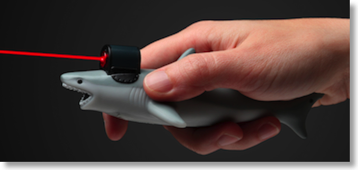
The gadget references the Austin Powers spy spoof movies. In 1997’s International Man of Mystery, the character Dr. Evil asks for “frickin’ sharks with frickin’ laser beams attached to their heads.” In 2002’s Goldmember, his son Scott actually develops the sharks:
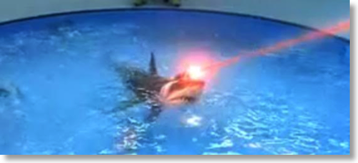
From Think Geek by way of Gizmodo. See also our May 2012 story about a laser pointer attached to a (real) shark’s fin, done for publicity purposes.
US: FDA warns parents of dangers of laser toys; issues draft guidance
In an August 6 2013 press release and Consumer Health Information article, FDA warned parents that lasers operated unsafely can cause serious eye injuries and even blindness. FDA said injuries from lasers can go unnoticed for days or weeks since there is no pain. But vision can slowly deteriorate over time, eventually causing permanent eye damage.
FDA gave the following as examples of children’s toy laser products:
- Lasers mounted on toy guns that can be used for “aiming”;
- Spinning tops that project laser beams while they spin;
- Hand held lasers used during play as “light sabers”;
- Dancing laser beams projected from a stationary column; and
- Lasers intended for entertainment that create optical effects in an open room.
Interestingly, the FDA’s press release and article gave tips on safe usage, including not aiming at car drivers or sports players -- but did not say that it is unsafe and illegal to aim at aircraft.
On August 7 2013, FDA issued draft guidance for industry on minimizing the risk of lasers in children’s toys. Comments are invited within 90 days of the Federal Register publication of the guidance, or by November 4 2013. The draft guidance is reprinted below.
Click to read more...
US: UPDATED - Laser pointer restrictions have made a "huge" positive difference in Myrtle Beach
He said that lasers last year, in 2012, were a “fad”. Visitors to the city purchased them from vendors as an impulse purchase
Horry County, which also passed a similar law, has seen similar results. “So far this year, there has been a large decrease in calls concerning the usage of green lasers and zero citations have been issued,” said Lt. Robert Kegler of the Horry County Police.
In the summer of 2012, there were 70 reports of lasers being aimed at aircraft near Myrtle Beach International Airport. The equivalent number for 2013 is not known.
Both ordinances state that adults improperly using lasers will be charged with assault and battery; the penalty is a fine of up to $500 and up to 30 days in jail. They will also be held liable for any damage or personal injury. Minors improperly using lasers will be prosecuted in Family Court, and their parents can be held responsible with a fine of up to $500 and up to 30 days in jail.
From Myrtle Beach Online and CarolinaLive.com
UPDATED September 3 2013: A letter from Coast Guard officials had some additional information: “Notable progress has been made, evident through a recent spring break sting operation that found no businesses selling lasers along the beachfront. There were a of [sic] total 68 laser incidents reported to the FAA in 2012 in the greater Myrtle Beach area. So far in 2013, the Coast Guard has not had any of its aircraft illuminated by lasers in the area. We applaud the efforts made by local leaders and sincerely appreciate the community’s support of the initiative.” The August 30 2013 letter was signed by Capt. Ric Rodriguez, Commander, Coast Guard Sector Charleston and by Commander Gregory Fuller, Commanding Officer, Coast Guard Air Station Savannah. From Myrtle Beach Online
US: FDA proposes amending Federal laser manufacturer regulations
The proposal was issued in the Federal Register on June 24 2013. The public may send comments to FDA until September 23 2013. FDA will then evaluate the comments, make any changes as a result, and at a future date will put the amendments into effect.
For consumer lasers, the most significant proposal is to create a new category of specific purpose lasers, “children’s toy laser products.” FDA says these could include lasers intended for creating entertaining optical effects, dancing laser beams projected from a stationary column, spinning tops which project laser beams, or lasers mounted on toy guns for “aiming.” FDA defines such toys as “a product that is manufactured, designed, intended or promoted for use by children under 14 years of age.”
The laser inside such a toy would be restricted to Class I (less than 1 mW for visible light). This is because FDA is concerned that if the toy were broken or disassembled, a higher power laser could harm a child.
Click to read more...
US: Researchers illuminate retinas to help stop laser damage
Because the laser pulse wavelength used was in the infrared, and the cells were cultured (not live retinas) there is no current practical use for pilots and others looking for glasses-free resistance to visible laser light. However, this research may open up other avenues as it does indicate that perhaps the retina can be “hardened.”
Click to read more...
US: Laser/aircraft incidents have increased compared to 2012
In 2012 and previous years, FAA was able to release detailed weekly reports tracking the number, type, and other data about laser incidents. But due to budget considerations in 2013, FAA has not yet been able to disseminate any reports. Thus, there is some uncertainty in the 1,500 approximation.
Based on this uncertainty, LaserPointerSafety.com has calculated that there could be between 1% and 16% more laser incidents in 2013 than in 2012. If accurate, any increase would represent a setback from the 2012 totals, which were 3% lower than in 2011. Having a rise in incidents would indicate that the publicity and prosecutions which form the majority of current U.S. anti-laser efforts are not having the desired effect.
The 2013 estimate of 3,774 incidents is based on comparing FAA reports from Jan. 1 to June 12 2013 to the same time period in 2012, and then extrapolating the 8.4% increase over the entire year. However, FAA changed their reporting procedures in 2013 so it is unclear how much of the estimated increase, if any, is an actual increase and how much is due to the new reporting procedures.
For the last comprehensive FAA figures, see our page Latest 2012 laser/aircraft incident statistics.
UPDATE, August 16 2013: New information shows 2,200 incidents from January 1 through August 2 2013. This is an 18% increase over the same period in 2012. Also, it does appear that FAA’s 2013 incident reports are comparable to 2012’s -- they have not yet significantly changed their reporting procedures or criteria. More information is at this LaserPointerSafety.com story.
US: New Maryland law criminalizes aiming laser pointers at aircraft
Click to read more...
US: North Myrtle Beach bans sale of lasers over 1 mW, and bans possession by minors in detailed new law
Click to read more...
US: South Carolina to ban laser pointer possession by minors
The bill was introduced by Representative Liston Barfield. He represents Myrtle Beach and North Myrtle Beach, resort towns which have been plagued with incidents of laser pointer harassment by youths and others. In 2012, there were more than 70 area incidents where laser pointers were aimed at aircraft, including Coast Guard search-and-rescue operations that were abandoned due to fear of laser exposure.
Click to read more...
US: North Wildwood NJ to ban laser pointer sales and possession
This was done after about 40 complaints to police in 2012, most of which "turned out to be kids playing with the laser pointers" according to the deputy police chief. The U.S. Federal Aviation Authority had also contacted the city regarding lasers pointed at aircraft. The ordinance language notes that "the illegal use of laser pointers creates risks and dangers for those targeted by the beam of the laser as well as for the residents of and visitors to the city of North Wildwood.”
Ordinance 1622 had its "first reading" on April 16, meaning it did not become law. The second reading, and possible adoption as a law, was set for the City Council meeting the evening of May 7 2013.
Click to read more...
US: L.A. Sheriff's Dept. puts "Laser Strike" info video on YouTube
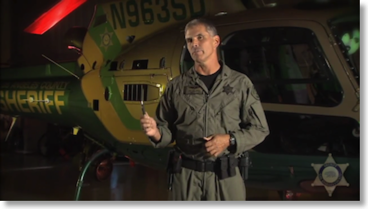
To see the video, click this link to YouTube. Following this link should also lead to the bonus content videos.
To get a flavor of the training video, click the “Read More…” link below for a list of selected excerpts and interesting statements.
US: TSA agent mistakes pepper spray for laser pointer
From the New York Post
US: Gold-coated nanotech could "laser-proof" pilots' glasses
According to a professor at Embry-Riddle Aeronautical University, gold-tinted eyewear has been used by military pilots for laser protection but only works against certain wavelengths of laser light. However, said Dan Macchiarella, if Thomas’ idea “could be applied to lasers of all strengths and wavelengths, that would certainly be a big advancement.”
A March 10 2013 Orlando Sentinel story noted that funding cuts and competition for grants mean that Thomas’ research faces “some serious hurdles” to develop this idea further. Thomas said finding research money is “going to be very difficult, very difficult.”
From the Orlando Sentinel
US: Government agency finds most laser pointers they purchased are overpowered
The findings were made public at a March 20 2013 meeting of the International Laser Safety Conference.
Researcher Joshua Hadler designed the measurement device to be accurate, inexpensive and easy-to-use. It would cost roughly $2000 in equipment costs to make a copy of the NIST device; plans are available from NIST for interested parties.
From a NIST press release, March 20 2013.
Click here for the full press release:Click to read more...
US: UPDATED - Maryland bill reintroduced to raise fines on pointer/aircraft misuse
Click to read more...
US: Myrtle Beach area proposed ban on laser pointer sales
The ordinance would make it illegal to sell lasers over 1 milliwatt, or to sell any green laser to persons under 18. Adults misusing lasers would be charged with assault and battery, with a fine of up to $500, up to 30 days in jail, and being held liable for any damage or personal injury. Minors misusing lasers would be prosecuted in Family Court, plus parents would be held responsible and could be fined or jailed.
In addition, a warning would be required with the sale of every laser pointer.
Under county procedure, it takes three “readings” at council meetings to pass an ordinance. Based on the council’s schedule, the earliest it could be passed would be in January 2013.
From CarolinaLive. This is part of continuing stories at LaserPointerSafety.com about ongoing problems at Myrtle Beach and North Myrtle Beach.
US: Myrtle Beach considering further laser regs; current ones aren't working
A meeting was held with local officials, including representatives from Myrtle Beach, the Coast Guard, the Chamber of Commerce and the Horry County Council, to discuss options. The director of airports said that existing ordinances are not enough. He wants “a way to look at regulating the size and power of lasers that are sold in our community and region.”
Rather than local cities passing ordinances, one approach is for county-wide regulations. The topic will continue to be discussed at future county council meetings.
From CarolinaLive. This is part of continuing stories at LaserPointerSafety.com about ongoing problems at Myrtle Beach and North Myrtle Beach.
US: Ocean City MD having increasing laser harassment problems
On July 29 2012, the Police Department issued a press release detailing the law’s requirements and penalties. To see the release, click the “Read More” link below.
Via WGMD. See also a related story from DelMarVaNow.com.
Click to read more...
US: Sen. Schumer asks FDA to overhaul laser regulations
From the Associated Press via the Wall Street Journal. To read the text of Schumer’s letter to the FDA, and his press release, click the Read More link below.
Click to read more...
US: Myrtle Beach area man hit in eye; wants laser ban
A vacationer staying in a local campground says the park banned green lasers. Patrick has written to the Horry County Council and has spoken at a local Public Safety Committee meeting to get rental property owners to ban them. He says “They serve no useful function at all. In fact, the only function they have is to harass people.”
Patrick would like a complete ban on lasers.
In the city of North Myrtle Beach, there have been 10 warning tickets issued between November 2011 and July 2012 for violations of a local laser pointer ordinance.
From CarolinaLive. This is part of continuing stories at LaserPointerSafety.com about ongoing problems at Myrtle Beach and North Myrtle Beach.
US: 198 calls to police about lasers in 3 months; Coast Guard "cracking down" in Myrtle Beach
The local Coast Guard echoes the concerns. Twice in two weeks, search and rescue missions were ended prematurely because of lasers being aimed at helicopters. (See a report here.) Under Coast Guard regulations, after laser exposure the aircraft is grounded and the pilots are medically evaluated before being allowed to fly again.
The Coast Guard issued a letter asking the public to stop aiming at aircraft, and saying that they want to enforce South Carolina’s state law against lading aircraft. The letter is reprinted below (click the “Read More” link).
From WMBF News. This is part of continuing stories at LaserPointerSafety.com about ongoing problems at Myrtle Beach.
Click to read more...
US: Appeal of 3-year sentence hinges on "willfully" aiming vs. "willfully interfering"
The August 2012 case in the U.S. Court of Appeals for the First Circuit hinges on instructions given to the jury during Gerard Sasso’s trial in January 2010. The judge in that trial told the jury that Sasso could be convicted for willfully aiming the laser at the helicopter. The judge also said that the government did not have to prove that Sasso knew that his aiming would interfere with the pilot.
Click to read more...
US: "Epidemic" of laser misuse in Myrtle Beach
Laser pointers are available for as little as $4 at many beachfront stores catering to tourists.
The president of a Myrtle Beach helicopter tour company says that his aircraft are hit “two, three times a week, sometimes more.” He says the increase makes him nervous for his pilots and clients. He says there is no education for laser pointer buyers about the potential hazard.
Click for video interview with Huffman Helicopter president Jeremy Bass.
From CarolinaLive. This is part of continuing stories at LaserPointerSafety.com about ongoing problems at Myrtle Beach.
US: New Virginia law makes it a misdemeanor to knowingly aim at an aircraft
The bill amends the Commonwealth’s Acts of Assembly Chapter 5.1-22, covering interference with aircraft to also prohibit “projecting a point of light from a laser, laser gun sight, or any other device that simulates a laser at an aircraft…” The only exception is for persons authorized by the Federal Aviation Administration or by U.S. armed forces. Violation is a Class 1 misdemeanor, punishable by up to 12 months in jail and/or a fine of up to $2,500.
From the Virginia Legislative Information System and FairfaxTimes.com.
US: FAA to take harsher actions against persons aiming at aircraft
FAA has directed its staff not to seek warning notices or counseling, but to use “moderately high civil penalties” for inadvertent laser illuminations, and maximum penalties for deliberate violations.
In a video provided by FAA, LaHood said “I wonder how stupid people really can be” for not knowing that laser light could “cause great harm if the pilot is not able to continue to fly the plane safely…. people’s lives could be in jeopardy.” LaHood also said people should “understand that there are serious consequences to shining a laser at a pilot.”
The complete press release is below (click the “Read More...” link). This also has links to video and audio from LaHood and the acting FAA Administrator.
Click to read more...
US: Man builds a replica Star Trek phaser
This is not the first time such a project has been done. In 2007, Kip Kedersha (“Kipkay”) posted a YouTube video showing how he bought a surplus Playstation 3 laser diode for $45 and a Star Trek toy for $30, in order to make a laser-emitting phaser.
A Huffington Post story has the 2012 video, as well as links to earlier videos and detailed build instructions.
From Reddit via the Huffington Post
US: Maryland "Laser Safety Act" passes House, goes to Senate
UPDATE, November 20 2012: The bill did not pass. According to Arora, it “passed the House of Delegates in March [2012] but ultimately failed to reach a vote in the state Senate during the final hours of the regular legislative session, when a budget showdown between the two chambers effectively killed scores of bills that were scheduled for votes.” It was reintroduced in November 2012, as discussed in this story.
AIRCRAFT LASER ATTACK BILL PASSES MARYLAND HOUSE, MOVES TO SENATE
Bill Would Punish Shining Laser Pointers at Pilots in Flight
ANNAPOLIS, Md. -- A measure aimed at curbing a dangerous trend targeting aircraft passed the Maryland House of Delegates Monday afternoon and now will head to the state Senate for approval.
The bill, the Laser Safety Act (HB 130), sponsored by Maryland State Delegate Sam Arora (D-Montgomery Co.), seeks stiffer penalties for people who shine laser pointers into aircraft cockpits, potentially blinding pilots in flight. The Act would carry a penalty of up to three years in prison and/or a fine of up to $2,500. Current law only permits for a $500 fine for “misuse of a laser pointer”.
Click to read more...
US & UK: UPDATED - Laser incident rate in U.K. more than twice the U.S. rate
- U.S. airports had 9,079,000 flights in 2011, with 3,591 laser incidents reported to the Federal Aviation Administration. This is a rate of one U.S. laser incident for every 2,528 flights. Said another way, this is 0.40 incidents per 1,000 flights.
- U.K. airports had 2,152,787 flights in 2011, with 1,909 laser incidents reported to the Civil Aviation Authority. This is a rate of one U.K. laser incident for every 1,128 flights. Said another way, this is 0.89 incidents per 1,000 flights.
The ratio of U.K. to U.S. rates is 2.24, meaning that the U.K. had more than twice the number of laser incidents than the U.S., when adjusted for the number of flights. (Important note: These figures do NOT mean that commercial aircraft are targeted at the rates indicated. Many laser incidents involve police helicopters. The analysis is simply meant to compare the two countries’ rates of laser misuse against aircraft of all types.)
It should also be noted that there could be many underlying factors affecting the precise numbers. For example, it is not known if the U.S. counts laser incidents in the same way as the U.K.
However, the figures do indicate that the U.K. rate of laser incidents appears to be significantly higher -- roughly twice the U.S. rate, based on the number of flights.
From an analysis by LaserPointerSafety.com, March 22 2012.
Updated May 27 2012 to correct a math error and make clear that it is the United Kingdom which has a higher rate of laser incidents (e.g., more incidents per 1000 flights). Our thanks to Brian Turner for pointing out this error.
Methodology: We define a “flight” as a takeoff plus a landing. US flight figures are from the Airline Activity “departures” statistic from the Department of Transportation’s Bureau of Transportation Statistics. It is assumed that each flight which departs also lands, so the data is accurate for “flights” as we have defined it. UK flight figures are from totaling column G, Total ATMs, from “Table 4, 1 Air Transport Movements 2011” found on the CAA UK Airport Statistics 2011 page. A UK “movement” is one takeoff plus one landing, so this is the same as our “flights” definition.
While the flight statistics compare only airline (US) and air transport (UK) flights, and do not include law enforcement flights, we believe this is a valid “apples to apples” comparison of how many more flights take place in the U.S. than in the U.K. A previous LaserPointerSafety.com analysis showed that law enforcement flights are less than 1% of the total flights from U.S. airports. Inclusion of law enforcement flight numbers would not significantly change the ratio of U.S.-to-U.K. flights.
.
US: Georgia bill would ban aiming at police and aircraft
The proposed bill would 1) establish the offense of unlawful pointing of a laser device at a law enforcement officer, and 2) prohibit aiming a laser pointer or projecting a laser on or at an aircraft or the flight path of an aircraft. The legislative history of the bill, including the full text of the Senate and House versions, is at the Georgia General Assembly website. We have also put the full text of the House version on the U.S. laws page here at LaserPointerSafety.com.
One interesting point is that the bill contains an exemption for “laser or laser pointer airspace uses that have been reviewed and approved by the Federal Aviation Administration.” This is a broader provision than the recently passed U.S. law, which only permits certain FAA-reviewed uses such as research and development.
In the view of LaserPointerSafety.com, the Georgia bill’s language is more flexible and still maintains safety, since they leave it up to the FAA to determine what outdoor laser uses are approved (technically, “non-objected”).
US: Amateur astronomers illuminate International Space Station with spotlights and 1-watt laser
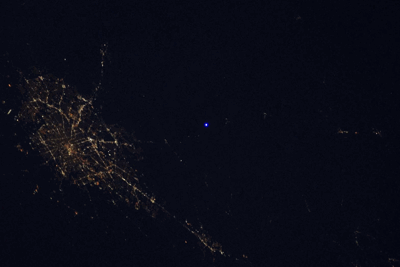
Two-frame animated GIF showing bright and dim light from the Lozano Observatory (center) near the city of San Antonio (left). North is to the right in this photo from the International Space Station, taken by astronaut Don Pettit. Click on photo for a larger version.
The spotlights were flashed at the ISS by holding plywood sheets in front of the lights every two seconds. This procedure can be seen in the video below.
The animated GIF above shows a bright blue light alternating with a dim light. The bright light is almost certainly from the spotlights. The bluish tint may be an artifact of oversaturating the camera’s sensor. Astronaut Don Pettit reported that the bright light appeared white, and the dim light appeared blue. He wrote “We could only see the laser when the white light was off and not all the time.” (E.g., the white spotlights overpowered the blue laser.) He added, “It was like there were tracking issues with the laser to keep it on target.”
The dim light in the animated GIF may be the laser only, or it may be light from the spotlights that wasn’t fully blocked by the plywood sheets. The astronomers will be working with Pettit, trying to pin down exactly how visible the laser light was.
US: Tampa police purchase anti-laser filters for night vision goggles
A person wearing NVGs is normally not at risk of retinal injuries, since direct laser light falls on the image intensifier device and not the eyes. (Depending on the NVG mounting style, it may be possible for direct laser light to enter from the side or from parts of the vision not covered by the NVG optics.) However, a serious concern is with laser light causing “blooming” of the night vision enhanced image, or even damaging the NVG sensor. To help prevent this, Night Flight Concepts developed “Laser Armor” Light Interference Filters.
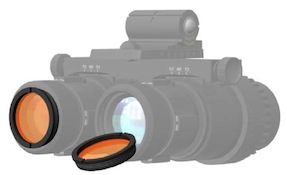
Company consultant Dr. Dudley Crosson says the screw-in filters “allow the goggles to function normally by reducing the blooming effect significantly.” A Laser Armor product sheet says the filters reduce blue (445-450 nm) intensity by 97%, and reduce green (532 nm) intensity by 99.5%.
From Aviation Today and a Night Flight Concepts press release
US: First comments on new U.S. law, from Western Pa. prosecutor
Hickton noted that the new law makes it easier to prosecute since malicious intent is no longer required. Instead, it must be proven that the defendant “knowingly” targeted an aircraft or its flight path with a laser pointer. The new law’s penalty is up to $250,000 fine and/or prison for up to five years.
A map from the FAA Allegheny Flight Standards District Office shows the location of 51 laser events between September 2009 and October 2011. Arrests were made in only two of these cases: “Hickton and other officials concede it can be difficult to pinpoint culprits.”
From 90.5 FM Essential Public Radio and the Pittsburgh Tribune-Review. A press release from Hickton’s office is below (click the Read More link). Edited Feb. 28 2012 at 3:15 PM EST to correct a statement from 90.5 FM.
US: Obama signs bill making aiming laser pointers at aircraft a federal crime
Violation can result in a fine and/or imprisonment up to five years. The bill does provide a few exemptions for research and development, flight testing, the Department of Defense, and the Department of Homeland Security. The only exemption for ordinary citizens is when “using a laser emergency signaling device to send an emergency distress signal.”
The laser pointer misuse prohibition becomes part of the United States Code; specifically, Title 18, Chapter 2, new section 39A: “Aiming a laser pointer at an aircraft”. The text of the new law is here.
From AVStop News
US: FAA clarifies "incidents" vs. "aircraft" laser illumination events
This is important because the FAA Laser Incident Database sometimes listed multiple reports from aircraft on a single spreadsheet row, if these were all in the same location at about the same time. Thus, it might appear that there was one “incident” which was reported by multiple aircraft. (This is how LaserPointerSafety.com interpreted an “incident” prior to February 15 2012.) However, FAA is now saying this was not their intent. While FAA may suspect that a single perpetrator was involved, they cannot be certain and thus to FAA this would be multiple incidents.
For example, in 2011, there were 12 spreadsheet rows that listed two or more aircraft as seeing the same laser. One row listed 5 aircraft, one row listed 3 aircraft, and ten rows listed 2 aircraft. Thus, there were 28-12 or 16 additional incidents according to FAA’s clarified definition.
The statistical analysis at LaserPointerSafety.com here and here reflects how FAA counts incidents.
.
US: Proposed Maryland law to increase penalties for shining lasers at aircraft
Co-sponsor Sam Arora said “We need this law … we’re talking about potential death.” The Maryland State Police testified in support of the bill at a February 7 2012 hearing that “the results [of a laser incident] could be deadly.” A WJZ TV news report said “Blinding a pilot at night is a good way to kill people.”
The bill only applies to laser pointers, defined under Maryland law (Title 3, Subtitle 8, Section 3-806) as any device that emits visible laser light. There are exemptions for lasers used for flight testing for the Federal Aviation Administration, the Department of Defense and the Department of Homeland Security.
The bill was introduced January 23 2012, and had its first reading on February 7. A companion Maryland Senate bill is expected to be introduced soon.
From Essex-Middle River Patch, CBS Baltimore WJZ, and the Maryland legislative information website. The full text of the bill is here; the Maryland definition of laser pointer is here.
Editorial note from LaserPointerSafety.com: A Maryland state police paramedic gave an erroneous demonstration to reporters purporting to show how a laser can be a hazard to aircraft. In a hangar, he aimed a red laser pointer at a helicopter windscreen only a few yards away. The resulting (grossly inaccurate) video shows a tiny red dot on the windscreen and in the aircraft. This is NOT what happens in a laser-aircraft incident. Instead, the light would be many inches across, even at low, helicopter-hovering altitudes of many hundreds of feet. The windscreen would further spread the light so that there would be a wide area of glare. In other words, the hazard is not a pinpoint that can go into one’s pupil, but a large “blob” of light that can cause temporary flashblindness, glare or distraction. This is an example of how laser hazards close up (within a few feet or yards) are very different from laser hazards to aircraft hundreds or thousands of feet away.
.
US: Air Force spending $2,400 each, for 3,000+ laser protection glasses
[NOTE: The amounts above represent about $2,400 per pair of laser protection spectacles. More information about anti-laser glasses for pilots, including non-military versions protecting against one or two visible wavelengths for roughly $100-200, is here.]
From a Teledyne Technologies press release
US: 2011 total: 3,591 laser/aircraft incidents
Note: The FAA reports the 2011 total as 3,592. This is because the last entry in the FAA’s laser incident spreadsheet is on line 3,592. However, the spreadsheet headings are on line 1, so the actual number of 2011 incidents is 3,591 -- the number we use below.
What is an FAA-reported “laser incident”?: This is defined as an aircraft pilot seeing one or more laser beams during flight. A mid-2011 study by Rockwell Laser Industries of 6,903 incidents reported to the U.S. Federal Aviation Administration found that in 27% of incidents, beams entered the cockpit (passed through the windscreen). For example, in 2011, there were 3,591 incidents of which approximately 970 (27%) involved beams in the cockpit.
PowerPoint version available: A set of slides, presented to the SAE G10 aviation safety committee on Jan. 31, 2012, is available on the Files and Downloads page.
Yearly Comparison
Here are the number of incidents reported to FAA in recent years:- 2011: 3,591 incidents (9.8 per night)
- 2010: 2,836 incidents (7.7 per night)
- 2009: 1,527 incidents (4.2 per night)
- 2008: 949 incidents (2.6 per night)
- 2007: 639 incidents (1.8 per night)
- 2006: 384 incidents (1.1 per night)
- 2005: 283 incidents (0.78 per night)
- 2004: 46 incidents (0.13 per night) involving an unknown number of aircraft Note: FAA mandated that pilots report incidents using Advisory Circular 70-2, beginning January 19 2005. Before this date, pilot reporting was voluntary.
This is a total of approximately 10,201 incidents reported to FAA, from 2004 through the end of 2011.
Adverse Effects
In 55 of the 3,591 laser/aircraft incidents (1.5%), a pilot or aircraft occupant reported a temporary adverse visual effect such as flashblindness, afterimage, blurry vision, eye irritation and/or headache. None of these effects was classified as a recordable injury by FAA medical experts.In these 55 incidents…
- … there were 31 reports of pain or discomfort in the eyes or elsewhere (e.g., headache).
- … there were 31 reports of vision impairment such as afterimages (10) and blurry vision (7).
- … seven persons sought medical treatment after the laser exposure.
- … one person was grounded temporarily.
- … three flights were affected: in two cases, the pilot turned control over to the co-pilot; in one case the pilot felt he had to land immediately.
Rate of increase, by year
While laser incidents continue to increase, during 2011 the rate of increase slowed significantly.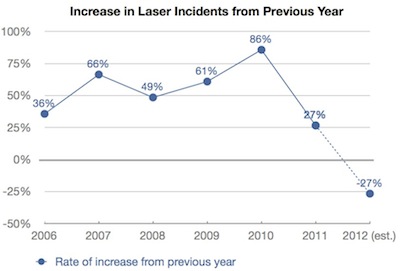
The rate of increase dropped 59% in 2011 (from 86.4% to 27%). If there is another 59% drop in 2012, (dashed line), then there would be a decrease in laser incidents for the first time, from 3,591 incidents in 2011 to 2,836 incidents projected for 2012.
Click to read more...
US: Los Angeles TV news report about increasing laser pointer incidents
KABC quoted the Glendora regional police helicopter tactical flight officer who was illuminated as saying “The laser could cause [eye] damage, and there’s a potential for the helicopter to crash.” The report said he and a pilot were recently trained by the FBI in how to handle a laser attack and how to track down a suspect.
Laser incidents are rising both nationwide and at local airport Los Angeles International (LAX), stated the report. It concluded by reminding the public that “any offense jeopardizes the safety of everyone.”
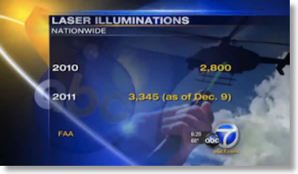
Click the screenshot above to view the video report from KABC
From KABC
US: Airborne missile-killing laser project mothballed after $5 billion
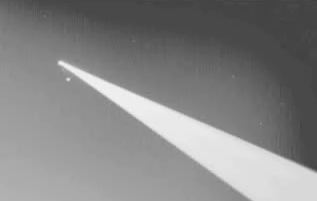
Cockpit view of the ABL shooting down a missile on Feb. 11 2010. Video is here.
A key reason for the ABL shutdown was the cost of the project versus the projected military returns. Another reason is that the Missile Defense Agency is looking to a new generation of laser systems with “much denser capacity or greater power lasers in smaller packages and operating at much higher altitudes.” Unmanned aerial vehicles would be an ideal platform. The MDA’s director said antimissile drones using solid-state lasers could be a reality by 2020.
From Aviation Week. An analysis of laser weapons is at Strategy Page.
Commentary from LaserPointerSafety.com: We included this story because people sometimes wonder if lasers aimed from the ground can damage an aircraft’s airframe. The short answer is “no”. It would take a system similar to the $5 billion ABL. However, the Missile Defense Agency is now indicating that military-developed solid-state lasers may be able to cause enough damage to down a missile -- or aircraft -- within this decade (the 2010s).
While it is unlikely that non-state groups could deploy such a device, it is more of a possibility than independently developing an ABL-like COIL gas laser. For the foreseeable future, the threat to aircraft remains the visual impairment caused by bright laser light, and to a lesser degree, the possibility of causing retinal lesion eye injuries.
.
US: Military aircrews can use finger-mounted laser pointers for target identification
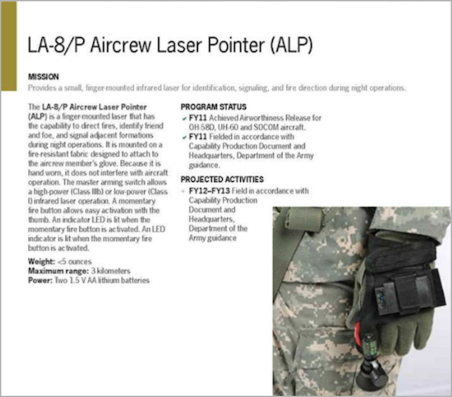
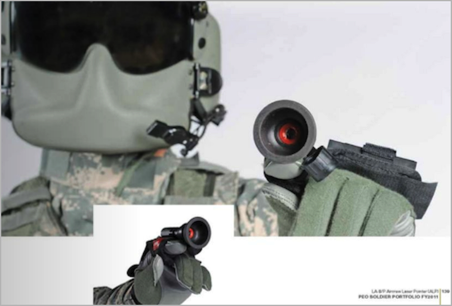
For the military laser enthusiast, the catalog contains a number of other laser devices such as the AN/PEQ-14 Integrated Laser White Light Pointer (actually a white flashlight plus a visible and an invisible laser):
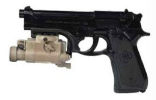
From the Program Executive Officer Soldier Portfolio FY2012 catalog. The LA-8/P is on printed pages 138-139, electronic pages 146-147. Originally found via GovWin.
Commentary from LaserPointerSafety.com: Although the LA-8/P Aircrew Laser Pointer does not emit a visible beam, it would be easy to make a visible version so that aircrews could “fire back” at persons on the ground aiming laser pointers at them. Whether this is a wise idea is another matter.
.
US: FDA updates "Red List" of banned laser importers and products
- The laser product does not have a permanently attached warning logotype label;
- The laser product output exceeds 5 milliwatts;
- The laser product fails to contain certification or identification information either on the product or in the instructions for use;
- The laser product fails to contain instructions for safe use;
- The product class or output information on the laser product's warning logotype label is different from that in the instructions for use; and/or
- A product report for the laser product has not been submitted.
Products which can be Detained Without Physical Examination (DWPE) include laser pointers, laser gunsights, laser pens, laser light show projectors, laser special effects, laser levels, toy guns with lasers, laser pointer key chains, and similar products.
It is unclear what effect the FDA’s import restrictions have on supplies. For example, the well-known company Wicked Lasers is listed multiple times as being banned from importing “All laser products and all products containing lasers.” However, a company representative on December 22 said that Wicked does ship to the U.S. and there should be “no issues getting a laser into the U.S.”
Violating companies are listed as follows.
- Canada: 2 companies shipping from a total of 3 addresses
- China: 51 companies shipping from a total of 57 addresses
- Hong Kong: 9 companies shipping from a total of 9 addresses
- Japan: 1 company shipping from a total of 2 addresses
- Taiwan: 25 companies shipping from a total of 28 addresses
- United Kingdom: 1 company shipping from 1 address
From the December 20 2011 update to the FDA Red List
US: Report says Iran blinded CIA satellite with laser
This was the only laser-related information in a December 15 2011 article that was otherwise about Iran tricking a U.S. drone into landing in Iran by jamming its GPS position signals.
From the Christian Science Monitor; the laser paragraph was on page 2 of the online story. See also an October 2011 Washington Post story analyzing a politician’s claim that China blinded U.S. satellites in 2006.
.
US: North Myrtle Beach passes laser pointer restrictions
From the North Myrtle Beach Times and CarolinaLive. For additional background, see other LaserPointerSafety.com stories on problems and ordinances in North Myrtle Beach and its neighboring city Myrtle Beach, plus resort cities Ocean City, and Virginia Beach.
.
.
US: ALPA holds major D.C. conference on the threat of laser illuminations
Speakers generally agreed on the nature and scope of lasers as a threat to air safety. They also offered similar solutions, including educating the public to not misuse lasers, prosecuting those who do, training pilots on how to "recognize and recover" from incidents, increasing the number of reports from pilots and the public, and restricting laser pointer availability.
The ALPA conference made news primarily for the announcement of a new FAA web page, which can be reached via www.faa.gov/go/laserinfo. FAA Administrator Randy Babbitt told the ALPA attendees that the web page -- erroneously described as a "website" in many media accounts -- would centralize the agency's information on laser/aviation safety. The page includes email addresses where pilots, air traffic control and the public can report laser incidents (see separate story about the FAA web page).
Babbitt also said that the FAA currently has filed 18 civil cases against individuals who aimed lasers at aircraft. There is a maximum $11,000 fine in each case.
Other speakers gave updates and information in their areas of expertise.Click to read more...
US: FAA urges pilots, public to report incidents on new webpage
- Reporting Laser Incidents: How to report an incident, for pilots, air traffic control officials, and the general public
- U.S. Laser Incidents by Year: A simple table listing incidents each year since 2005
- Laser Events and Civil Penalties: Press releases about the number of incidents in 2010 and about the June 2011 decision to impose civil fines of up to $11,000. Also, the legal interpretation justifying imposition of the fines.
- Hazards of Laser Illumination: Links to background information for pilots, and two studies of the issue by FAA’s Civil Aerospace Medical Institute
- Planning Light Shows and Other Outdoor Laser Operations: Information and forms for persons planning to use lasers outdoors
Below is the FAA press release announcing the web page:Click to read more...
US: UPDATED - Myrtle Beach CAP official witholds safety flights after being charged for confiscating laser pointer from 12-year-old (+ 2 updates)
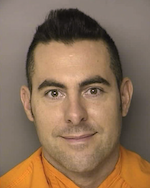
Stephen Teachout
In retaliation, Teachout said the three-pilot Civil Air Patrol would not provide help to Horry County (where Mytle Beach is located) for certain calls including offshore missing persons and forest fires. According to the Sun News, Teachout said “I support Horry County but if they don’t have [the pilots’] backs then no thanks. We don’t need to be here.”
Click to read more...US: Politician says China blinded U.S. satellites with lasers
US: Va. Beach wants state of Va. to ban aiming lasers at airplanes
The City Council is considering a local law to make malicious shining of lasers a Class 1 misdemeanor (up to a year in jail and a $2500 fine). According to PilotOnline.com, in 1998 Virginia Beach “was one of the first in the nation to make it a crime to shine lasers at police officers or into people’s eyes.”
The city is also planing an educational campaign to inform people about the law and laser dangers.
Commenter “Lost_Sailor” said there already is a Virginia state code, 5.1-22, “Interference with operation of aircraft,” to address the problem. He linked to a 2002 Virginia Court of Appeals case upholding the conviction of a man for using a “million candlelight spotlight” to illuminate a police helicopter. The man unsuccessfully argued that he had no intent to interfere with the helicopter; he wanted to view its registration number for a noise complaint. The man also unsuccessfully argued that his spotlight did not interfere with the operation of the aircraft.
From PilotOnline.com. The comment by Lost_Sailor was submitted on Thursday, 10/06/2011 at 6:40 pm.
US: Two FBI videos warning against lasers get 250,000+ YouTube views
The video highlights Justin Stouder, a St. Louis-area resident who was arrested in April 2010 for aiming at a police helicopter. He apologized at a news conference in July 2011 intended to publicize the illegality and hazards of lasers aimed at aircraft.
The FBI also released video excerpts of the Stouder laser incident and his subsequent identification by the helicopter and arrest. The incident/arrest video was about 10 times as popular on YouTube, with over 225,000 views:
The press release, and a transcript of the video, are below (click on the Read More… link).Click to read more...
US: Senate bill S. 1608 introduced to help move laser pointer legislation
A news report on WPRI said Whitehouse introduced this as a standalone measure. In February 2011 Whitehouse had proposed the same provisions as Amendment 8 to S. 223, the FAA Air Transportation Modernization and Safety Improvement Act which passed the Senate February 17 2011. Because House action on FAA funding was held up, Whitehouse decided to re-introduce the measure as its own bill.
The House version is H.R. 386 introduced January 20 2011 by Rep. Daniel Lungren, Republican of California. The House bill also provides a penalty of a fine and/or up to five years in prison. It was passed by the full House on February 28 2011.
It is likely that S. 1608 will successfully pass in the Senate Judiciary Committee and the full Senate. If the bill is identical to H.R. 386, then the legislation would be sent to the President for his approval and signature. If the bill differs from H.R. 386 -- for example, if amendments are added -- then a House/Senate reconciliation committee would meet to work out the differences, in advance of sending a single piece of legislation to the President.
From WPRI.com. S. 1608 can be tracked on GovTrack.us; as of September 25 2011, the text of the bill has not yet been posted.
US: 3 sheriff's officers charged with illegal laser sales
92 laser sights and 74 automatic machine guns were ordered between Sept. 2008 and January 2010 on Lake County letterhead and purchase orders. The officers paid for the products with personal funds. The amount earned from Internet resales was not stated, although the three officers were also indicted for understating their personal income by a total of $387,000.
The laser products came from Insight Technology Inc. and Laser Devices Inc. The 92 restricted laser sights were purchased for approximately $1000 to $1400 each and were sold on eBay for around $2800 to $4200 each. A special agent of the U.S. Food and Drug Administration (which regulates laser devices) made an undercover purchase as part of the evidence-gathering process in the case.Click to read more...
US: North Myrtle Beach considers laser pointer ordinance (UPDATED - Ordinance passed)
The city has received more than 100 complaints about laser misuse. A spokesperson for the city said “We've had many complaints this past summer about people, mostly people under 18, shining the green laser into the condominiums, into hotel rooms … at people on the beach, at animals, and even at turtles. When they were hatching, they would shine them on the small turtles and lead them away from the ocean.”
(Note: the city of North Myrtle Beach is separate from its neighbor Myrtle Beach which has enacted restrictions on pointers.)
From CarolinaLive-WPDE and WMBFnews.com
UPDATE November 28 2011: The ordinance passed its second reading and now will officially go on the books in North Myrtle Beach. From North Myrtle Beach Times and CarolinaLive.
US: Laser safety training part of UAW/GM labor pact
Due to the potential for catastrophic injuries from lasers, the UAW bargaining team pushed hard to expedite safety training in this growing field. Within 30 days of ratification, the UAW-GM Health and Safety Training Department will schedule a train-the-trainer (T3) Laser Safety Awareness Training course to be taught at the CHR [UAW-GM Center for Human Resources].
From the UAW GM Report via DetroitNews.com
US: Reporter discusses how U.S. Constitution covers laser pointers
Writing on Constitution Day, September 17, David Fahrenthold frames the issue to illustrate a new House of Representatives rule requiring every bill to reference it’s Constitutional authority.Click to read more...
US: New York Times calls attention to pilots' laser risk
From the New York Times. Readers of the Times article may also be interested in clarifications, tips and links compiled by LaserPointerSafety.com.
US: Orlando Sentinel runs article on laser hazards
From the Orlando Sentinel
US: UPDATED - Myrtle Beach proposes severely restricting lasers
For adults, the proposal would ban use in public such as beaches, parks or streets. It would be illegal to aim lasers at a person, animal or vehicle. Violation would be a misdemeanor, with a penalty of up to a $500 fine and one month in jail.Click to read more...
US: St. Louis area sheriff's department to use anti-laser glasses
The eyewear, made by NoiR, significantly reduces laser light, without adversely affecting pilot vision of cockpit instruments or airport lights. Because some laser light is transmitted, pilots and flight officers will still be able to track the source of a laser illumination.
The decision to purchase the glasses was made because of recent laser incidents in the St. Louis area. A spokesperson said the eyewear is “another tool to keep us in the air.”
From STLtoday.com
US: Laser beams usually are not tracking aircraft; most do not enter cockpit windows
The analysis was done by Rockwell Laser Industries (RLI). They examined 6,903 incidents in FAA’s database, dating from 2004 to mid-March 2011.The cockpit was illuminated only in about 1,875 incidents (27%). Of these, the exposure appeared intentional in about 350 incidents (19% of the cockpit illuminations; 5% of all illuminations). “Intentional” was defined as multiple beam exposures or the beam tracking the aircraft.
There were about 100 incidents (1.5% of all incidents) reported eye effects or injuries to the eyes. (A separate analysis by LaserPointerSafety.com shows that the vast majority of eye effect/injury reports are of minor, temporary effects. There are a few claims of eye injuries, and a very few confirmed claims of retinal injury.)
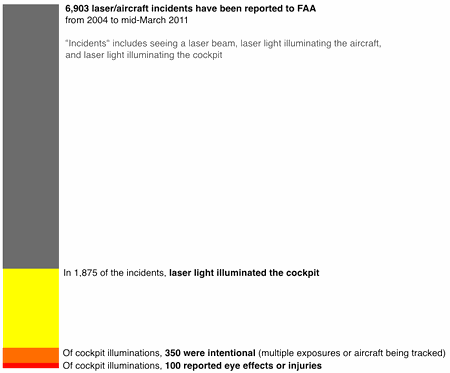
The RLI analysis was done by Kevin Donnelly, and was supervised and presented in August 2011 by RLI president Bill Ertle. Rockwell Laser Industries is a pioneer in providing services and products related to lasers and laser safety.
US: New Illinois law bans aiming lasers at aircraft
From the Chicago Tribune
See LaserPointerSafety.com’s prior coverage of the bill here.
US: Second Ocean City NJ vote against pointers makes laser ban official
US: Ocean City MD passes emergency law restricting laser pointer use, sale
- Sales to minors are prohibited.
- Possession by minors within town limits is prohibited.
- It becomes illegal to shine pointers on persons, streets, bays, sidewalks or the boardwalk.
- Stores must post conspicuous signs notifying prospective purchasers of the town’s laser pointer law.
- Stores must provide a written copy of the town’s law to anyone purchasing a pointer.
The action is in response to an “out of control” situation in the resort city (see story here).
News story from WMAR covering the laser pointer problems and resulting law
From WBOC 16
US: Ocean City NJ initially votes to ban sales, possession of laser pointers
The move comes after significant laser misuse during the resort city’s 2010 summer season, and a rise in 2011 incidents against aircraft, vehicles and citizens. The “straw that broke the camel’s back” may have been a June 7 illumination, where a 21-year-old purchased a green laser pointer from a Boardwalk store and almost immediately aimed it at a Coast Guard helicopter two miles offshore. The man, Eric Bouda, was arrested within minutes. (More on the story here.)
Last year, the local merchants’ association and the police asked for a voluntary ban on sales. However, the ban was not successful, with merchants resuming sales for competitive reasons.Click to read more...
US: UPDATED - New Jersey law proposed to ban laser pointers above 1 milliwatt
New Jersey S2430 provides for a $500 penalty for the first offense, and up to $1000 for any subsequent offenses. A laser pointer is defined in the bill as “any device that emits laser light to project a beam that may be used for aiming, targeting, or pointing out features.”
The state Senator representing Ocean City, Jeff Van Drew, introduced the legislation on November 22 2010. It was assigned to the state Senate Commerce Committee.
The bill text is available at e-lobbyist.
UPDATE - June 11 2011: The bill is still pending in the Commerce Committee. Renewed attention has been brought to the legislation as the opening of Ocean City’s 2011 summer season has brought additional incidents against both aircraft and citizens (see links below to related June 2011 news stories).
UPDATE 2 - August 20 2013: The bill passed both the New Jersey Assembly and the Senate, and was sent to Gov. Chris Christie for his signature.
Related LaserPointerSafety.com news stories about Ocean City and New Jersey laser troubles
- August 26 2010: Ocean City officials discuss city-wide ban on laser pointers after summer incidents.
- November 22 2010: State senate bill 2430 is introduced in November 2010 to ban laser pointers above 1 milliwatt.
- June 8 2011: Man buys laser in Ocean City, points it at helicopter, and is almost immediately arrested.
- June 11 2011: Residents report harassment; voluntary sales ban is not working.
- June 24 2011: Unanimous vote on the initial measure to ban Ocean City laser pointer sales and possession.
- July 14 2011: Unanimous vote on the “second reading” to make the Ocean City ban official.
- April 16 2013: North Wildwood NJ bans sale and possession of laser pointers above 1 mW.
- August 20 2013: New Jersey state legislature passes bill to ban laser pointer sales above 1 mW; sends bill to Governor for signature.
- October 17 2013: Governor Chris Christie vetoes bill to ban laser pointer sales, saying the 1 mW power limit was “arbitrary” and there was no criminal use of lasers between 1 mW and the federal limit of 5 mW in New Jersey.
US: Ocean City NJ discusses a ban on laser pointers
The move came after a report one week earlier about seven incidents when aircraft landing at Atlantic City International Airport had been illuminated by lasers. Police noted that while pointing at an aircraft is a crime, owning or selling lasers is not against the law.
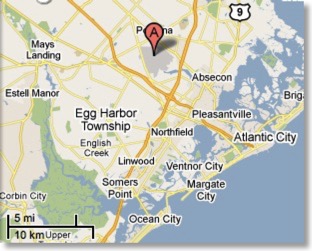
Ocean City, New Jersey, location in relation to Atlantic City International Airport (“A” on the map above)
From the Press of Atlantic City. An earlier story (August 18 2010) has additional details about the aircraft illuminations and the efforts to stop sales; see this Press of Atlantic City article. A January 23 2011 Press of Atlantic City article updates the laser situation in the Ocean City area.
Related LaserPointerSafety.com news stories about Ocean City and New Jersey laser troubles
- August 26 2010: Ocean City officials discuss city-wide ban on laser pointers after summer incidents.
- November 22 2010: State senate bill 2430 is introduced in November 2010 to ban laser pointers above 1 milliwatt.
- June 8 2011: Man buys laser in Ocean City, points it at helicopter, and is almost immediately arrested.
- June 11 2011: Residents report harassment; voluntary sales ban is not working.
- June 24 2011: Unanimous vote on the initial measure to ban Ocean City laser pointer sales and possession.
- July 14 2011: Unanimous vote on the “second reading” to make the Ocean City ban official.
- April 16 2013: North Wildwood NJ bans sale and possession of laser pointers above 1 mW.
- August 20 2013: New Jersey state legislature passes bill to ban laser pointer sales above 1 mW; sends bill to Governor for signature.
- October 17 2013: Governor Chris Christie vetoes bill to ban laser pointer sales, saying the 1 mW power limit was “arbitrary” and there was no criminal use of lasers between 1 mW and the federal limit of 5 mW in New Jersey.
US: FAA to impose civil penalties of up to $11,000
The Wall Street Journal states that “[t]he change is intended to make it easier to punish violators without resorting to time-consuming criminal proceedings.”
Previously, FAA did not go after laser violators directly. FAA will now routinely bring civil charges, and these will be in addition to any other civil or criminal charges brought by others such as the FBI, or state and local law enforcement.Click to read more...
US: 2012 laser/aircraft incident statistics
What is an FAA-reported “laser incident”?: This is defined as an aircraft pilot seeing one or more laser beams during flight. A mid-2011 study by Rockwell Laser Industries of 6,903 incidents reported to the U.S. Federal Aviation Administration found that in 27% of incidents, beams entered the cockpit (passed through the windscreen). For example, in 2011, there were 3,591 incidents of which approximately 970 (27%) involved beams in the cockpit.
Year-to-Date Comparison
The 3,482 reported U.S. laser/aircraft incidents in 2012 compare with 3,591 incidents during 2011, approximately 2,836 incidents during 2010, and approximately 1,527 incidents during 2009.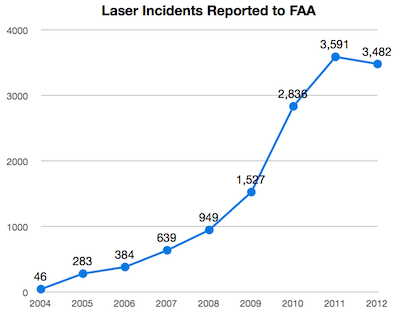
The number of U.S. laser incidents decreased slightly in 2012
Projected 2013 Estimate
If the number of laser/aircraft incidents in 2013 continues to decrease at the same rate as from 2011 to 2012 (-3.04%), then there would be 3,376 incidents in 2013.
Adverse Effects
In 36 (1.0%) of the 3,482 laser/aircraft incidents in 2012, a pilot or aircraft occupant reported a temporary adverse visual effect such as flashblindness, afterimage, blurry vision, eye irritation and/or headache. In four of the 36 eye incidents, the eye effect may have been more serious or long-lasting. In no incidents, either in 2012 or in previous years, was there any permanent eye damage.Total Incidents, 2004 to Date
There have been approximately 13,737 laser/aircraft incidents reported to FAA, from January 1 2004 through December 31 2012..
Click to read more...
US: NY Times says injury increase feared from higher powered lasers
The article listed four injuries to youths. In three of the incidents, a young person deliberately stared into a laser beam, while the fourth was caused by a high-schooler whose friend waved a 50 mW laser in his face. (Besides these anecdotal accounts, the article gave no overall statistics on injuries except to say that an ophthalmologist association is “unaware of any increase in eye injuries caused by lasers.”)
Author Christine Negroni covered a number of topics, including:
- There has been “ninefold increase over five years” in laser illuminations of aircraft
- Eye doctors are “shocked” that high-powered lasers are available on the Internet with no purchase restrictions.
- A U.K. physician says the U.S. limit should be 1 mW, that even at 5 mW laser pointers have “acute” dangers.
- FDA says that noncompliant (“illegal”) lasers are available despite agency seizures.
- Wicked Lasers says that its products are compliant, that they are “extremely clear” about eye and fire hazards on their webpages, and that they will be offering online safety lessons “before checkout”.
- A “large community” of laser enthusiasts wants to keep lasers available.
- An 18-year-old laser hobbyist, who wears goggles and is supervised by his parents, said he was learning about electronics, soldering, physics, light, optics and mechanics.
From the New York Times, online on Feb. 28 2011, in print on March 1 2011 on page D5 of the National edition.
US: House and Senate pass legislation against laser pointer aiming
The bill makes it a crime to aim or illuminate an aircraft with a laser pointer. From the bill:
Whoever knowingly aims the beam of a laser pointer at an aircraft in the special aircraft jurisdiction of the United States, or at the flight path of such an aircraft, shall be fined under this title or imprisoned not more than 5 years, or both. As used in this section, the term ‘laser pointer’ means any device designed or used to amplify electromagnetic radiation by stimulated emission that emits a beam designed to be used by the operator as a pointer or highlighter to indicate, mark, or identify a specific position, place, item, or object.
There are three exemptions in H.R. 386: 1) R&D and flight testing approved by FAA, 2) Defense or Homeland Security department operations, and 3) use of a “laser emergency signaling device to send an emergency distress signal.”
From an AP story running in many locations including here.
COMMENTARY: LaserPointerSafety.com has a page with our analysis of H.R. 386, written before the bill was introduced into the current session of Congress.
US: UPDATED -Law proposed in Illinois to criminalize laser pointing
HB0167 is similar to HR 386, a bill currently in the U.S. House of Representatives. One difference is that the state bill criminalizes using any “laser” that illuminates a cockpit, while the federal bill only applies to “laser pointers”. Another difference is that HB0167 contains two of the three exceptions in HR 386. While it provides an exemption for R&D and flight tests, and for the Defense and Homeland Security Departments, the Illinois bill does not provide any exemption for lasers used to signal in emergency rescue situations.
The full text of the bill, along with the status and other information, is available from the Illinois General Assembly.
From the Chicago Tribune (Jan. 26 2011) and St. Louis Post-Dispatch (Feb. 17 2011).
UPDATED - June 15 2011: The bill was passed February 24 by the Illinois House and May 17 by the Senate, and has been sent to the Governor for his signature. From the Illinois General Assembly status page on HB0167.
UPDATE 2 - July 21 2011: The Governor signed the bill. It becomes Public Law 097-0153 and will take effect January 1 2012. From the Chicago Tribune.
US: 2,836 laser events reported in 2010; FAA expresses concern
FAA spokesperson Laura Brown told LaserPointerSafety.com that in roughly 90% of the reports, the cockpit and/or pilot was illuminated by the laser. (In the other 10%, a beam was seen outside the aircraft but light did not enter the cockpit.) As far as injury reports, Brown said that these were “fairly rare”.
The FAA’s press release listed the top 20 affected airports, with Los Angeles International Airport topping the chart with 102 “laser events” in 2010. LaserPointerSafety.com has further analyzed the airport data to show that for these top 20 airports, an event occurred once every 7,000 takeoffs and and landings; the analysis is here.
According to the press release, “[t]he increase in reports is likely due to a number of factors, including the availability of inexpensive laser devices on the Internet; higher power levels that enable lasers to hit aircraft at higher altitudes; increased pilot reporting of laser strikes; and the introduction of green lasers, which are more easily seen than red lasers.”
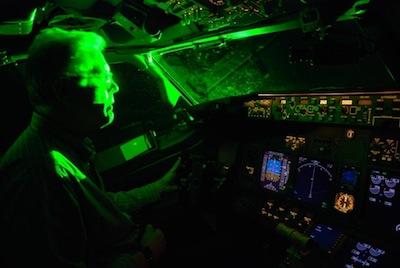
The FAA released the photo above, illustrating what a direct laser illumination of a cockpit can look like.
To read the full FAA press release, and see the list of 20 most affected airports, click the “Read More...” text below. In addition, updated statistics for the current year are here.
US: FAA issues study of 2,492 laser events from 2004 to 2008
The study is entitled “The Illumination of Aircraft at Altitude by Laser Beams: A 5-Year Study Period (2004-2008)”. The FAA’s abstract is here; and the full 12-page report in PDF format is here.
US: FDA warns of risk from high-powered lasers
The announcement, dated a week before Christmas said “high-powered laser pointers” are “illegal and potentially dangerous.... The FDA wants to make consumers aware that they should not buy these lasers for themselves or as gifts for others.”
The announcement noted that “many eye injuries from laser pointers go unreported.” Of reported injuries, FDA said in 2010 they were aware of three incidents involving children playing with laser pointers. One of these caused damage “from reflected beams after directing a 150 mW laser pointer into a mirror.”
FDA also described incidents of pilots experiencing temporary flash-blinding. In 2009, pilots reported 1500 incidents; in the first 10 months of 2010, there were 2321 incidents. FDA noted in boldface that “Using a laser to illuminate aircraft is a federal crime.”
FDA listed five recommendations:
- Do not let children own or use laser pointers.
- Do not buy any laser pointer over 5 mW
- Do not aim laser pointers at any “person, pet, vehicle or aircraft” either directly or through reflections.
- If you own a laser pointer over 5 mW, “dispose of it safely according to local environmental protection guidelines.”
- If you are injured, see your eye doctor
The complete safety notification can be found on this FDA webpage, and is also reprinted here (click on the “Read more...” link).Click to read more...
US: More than 30,000 lasers are "out of control" in Ocean City MD
Perpetrators are shining beams onto the faces, “chests and private parts” of passers-by; the latter starting fights with boyfriends according to the chief. One family complained that their child had a seizure after a laser was shone on their eyes. A councilwoman said “a young boy ... shined a green laser directly into her eyes. She said her vision is now hazy and impaired, though a doctor advises her it will eventually return to normal.”
An article from delmarvanow.com quoted 29-year-old Richard Drake of Ocean City, who in 2009 “sustained serious damage to his left eye after having a red laser shone purposefully in the face. Now he sees everything with a pinkish hue.” He is campaigning to have laser pointer sales banned in the resort town.
The town council was poised to ban sales to minors and possession by minors, to make it illegal to aim lasers at people and vehicles, and mandating signs in stores and handouts to buyers that describe the city’s ordinances. (The legislation passed; see story here.)Click to read more...
New York Times: Taking on "laser lunatics"
And now handheld laser pointers have earned a place alongside guns in Australia’s most populous state.
A new law proposed today by the premier of New South Wales declares possession of the handheld lasers a serious crime, punishable by up to 14 years in prison, depending on the device’s power. Weaker lasers could carry a $5,000 fine or 2 years in jail, and there would be exemptions only for teachers, construction crews and the scientists who point out the stars on planetarium ceilings.
...
This all may sound vaguely familiar: the United States went through a similar fit in 2005. Then, the Federal Aviation Administration reported an astounding 287 cases of cockpits hit with laser beams, and the House of Representatives proposed a law against pointing the devices at planes , with fines up to $250,000 and prison terms up to five years.
The full blog post is at the New York Times
US: New FDA publication on laser pointer hazards
FDA is especially concerned about laser pointers above 5 mW, and about aircraft incidents. “In 2008, pilots reported a total of 950 cases of laser light striking an aircraft or illuminating a cockpit....The distraction from flash blindness could cause a serious accident.”
Click to read more...
US: 148 incidents in less than 2 months
On Friday, Feb. 20, 2009 alone there were reports of incidents in Salt Lake City and Ogden, Utah; Lake Charles, Louisiana; Orlando, Florida; and Burbank and San Jose, California. On Sunday, Feb. 22, 12 different jetliners landing in Seattle were illuminated by an unknown person with a laser pointer.
Information from a CNN story on the Feb. 22 Seattle attacks; see paragraphs 6 and 7. There is also a video version of this story at CNN’s website.
Wired Magazine: Laser pointers a "huge safety risk" for aircraft
According to The Washington Post, the FAA reports during the first half of this year [2008], there have been more than 175 cases of lasers shot at aircraft, and more than 900 incidents since 2004. In most cases these were not powerful industrial lasers, but the commonplace pointers wielded by countless college professors and mid-level management types.
Additional details from the Wired Magazine blog post
